Arbitration and Winding Up Orders
VerifiedAdded on 2020/05/11
|77
|12861
|65
AI Summary
This assignment delves into a case study examining the interplay between arbitration agreements and winding-up orders in Australia. Students are tasked with analyzing a specific case involving WDR Delaware Corporation and Hydrox Holdings Pty Ltd, where the Federal Court considered the arbitrability of disputes despite an application for winding up. The assignment requires critical thinking about legal principles, court decisions, and the broader implications of arbitration in commercial contexts.
Contribute Materials
Your contribution can guide someone’s learning journey. Share your
documents today.
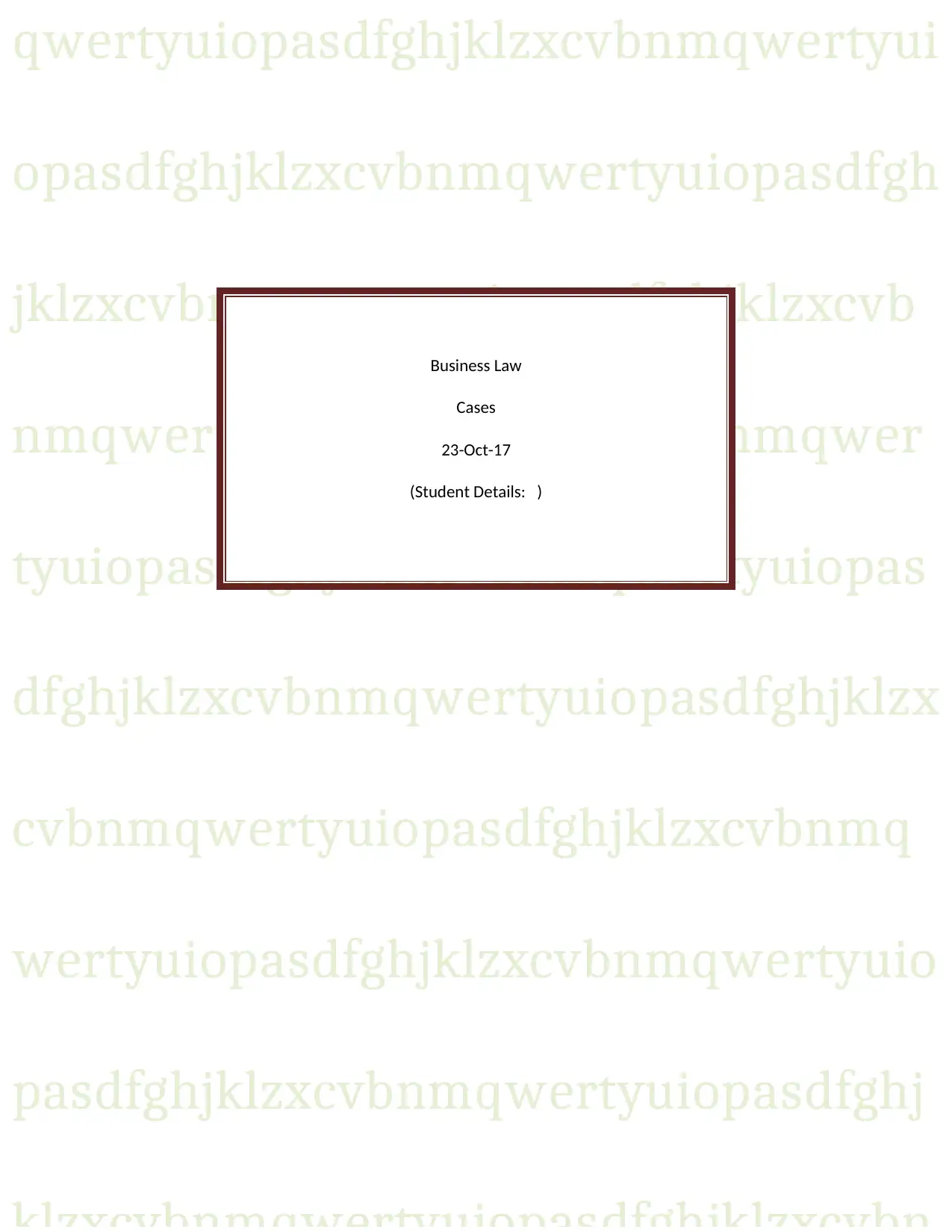
qwertyuiopasdfghjklzxcvbnmqwertyui
opasdfghjklzxcvbnmqwertyuiopasdfgh
jklzxcvbnmqwertyuiopasdfghjklzxcvb
nmqwertyuiopasdfghjklzxcvbnmqwer
tyuiopasdfghjklzxcvbnmqwertyuiopas
dfghjklzxcvbnmqwertyuiopasdfghjklzx
cvbnmqwertyuiopasdfghjklzxcvbnmq
wertyuiopasdfghjklzxcvbnmqwertyuio
pasdfghjklzxcvbnmqwertyuiopasdfghj
Business Law
Cases
23-Oct-17
(Student Details: )
opasdfghjklzxcvbnmqwertyuiopasdfgh
jklzxcvbnmqwertyuiopasdfghjklzxcvb
nmqwertyuiopasdfghjklzxcvbnmqwer
tyuiopasdfghjklzxcvbnmqwertyuiopas
dfghjklzxcvbnmqwertyuiopasdfghjklzx
cvbnmqwertyuiopasdfghjklzxcvbnmq
wertyuiopasdfghjklzxcvbnmqwertyuio
pasdfghjklzxcvbnmqwertyuiopasdfghj
Business Law
Cases
23-Oct-17
(Student Details: )
Secure Best Marks with AI Grader
Need help grading? Try our AI Grader for instant feedback on your assignments.
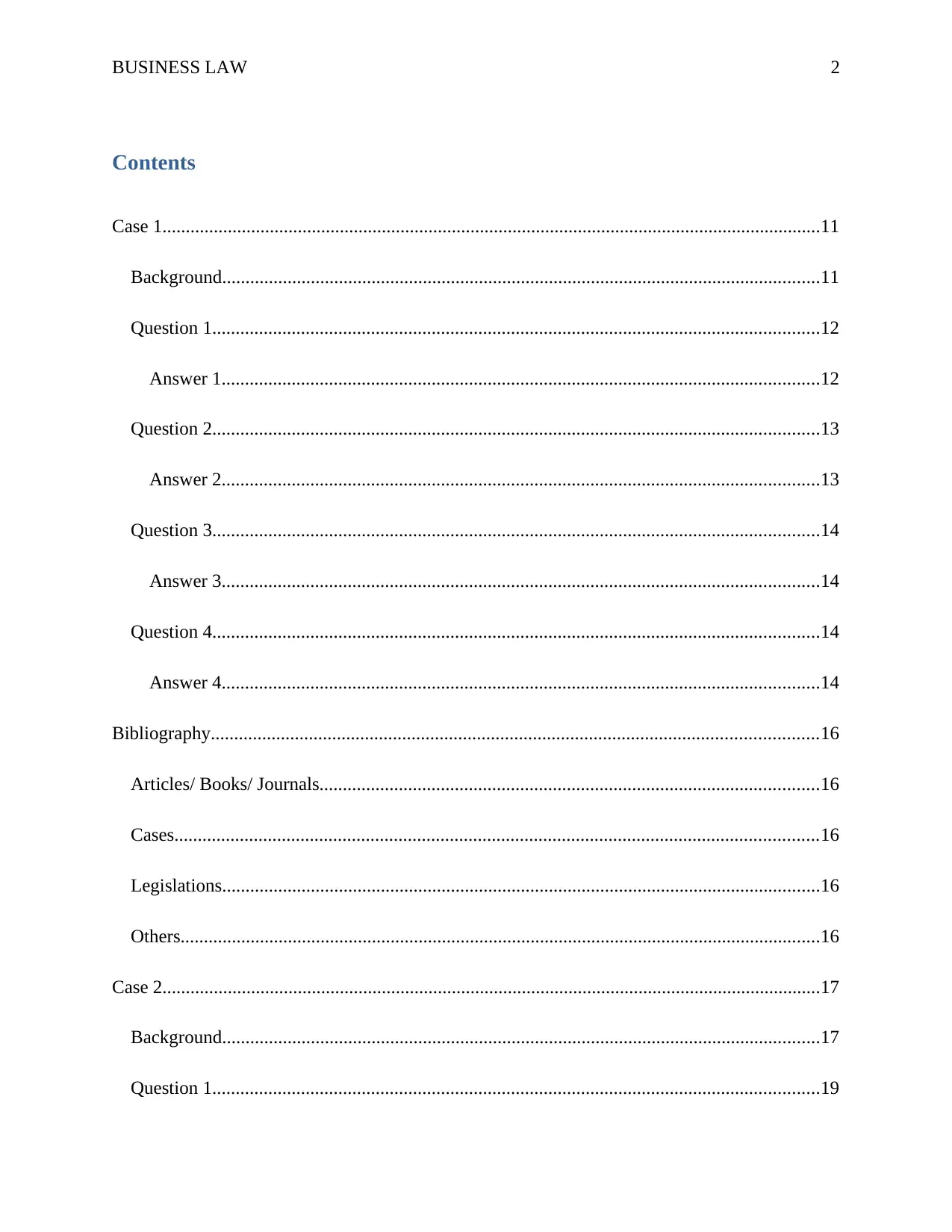
BUSINESS LAW 2
Contents
Case 1.............................................................................................................................................11
Background................................................................................................................................11
Question 1..................................................................................................................................12
Answer 1................................................................................................................................12
Question 2..................................................................................................................................13
Answer 2................................................................................................................................13
Question 3..................................................................................................................................14
Answer 3................................................................................................................................14
Question 4..................................................................................................................................14
Answer 4................................................................................................................................14
Bibliography..................................................................................................................................16
Articles/ Books/ Journals...........................................................................................................16
Cases..........................................................................................................................................16
Legislations................................................................................................................................16
Others.........................................................................................................................................16
Case 2.............................................................................................................................................17
Background................................................................................................................................17
Question 1..................................................................................................................................19
Contents
Case 1.............................................................................................................................................11
Background................................................................................................................................11
Question 1..................................................................................................................................12
Answer 1................................................................................................................................12
Question 2..................................................................................................................................13
Answer 2................................................................................................................................13
Question 3..................................................................................................................................14
Answer 3................................................................................................................................14
Question 4..................................................................................................................................14
Answer 4................................................................................................................................14
Bibliography..................................................................................................................................16
Articles/ Books/ Journals...........................................................................................................16
Cases..........................................................................................................................................16
Legislations................................................................................................................................16
Others.........................................................................................................................................16
Case 2.............................................................................................................................................17
Background................................................................................................................................17
Question 1..................................................................................................................................19
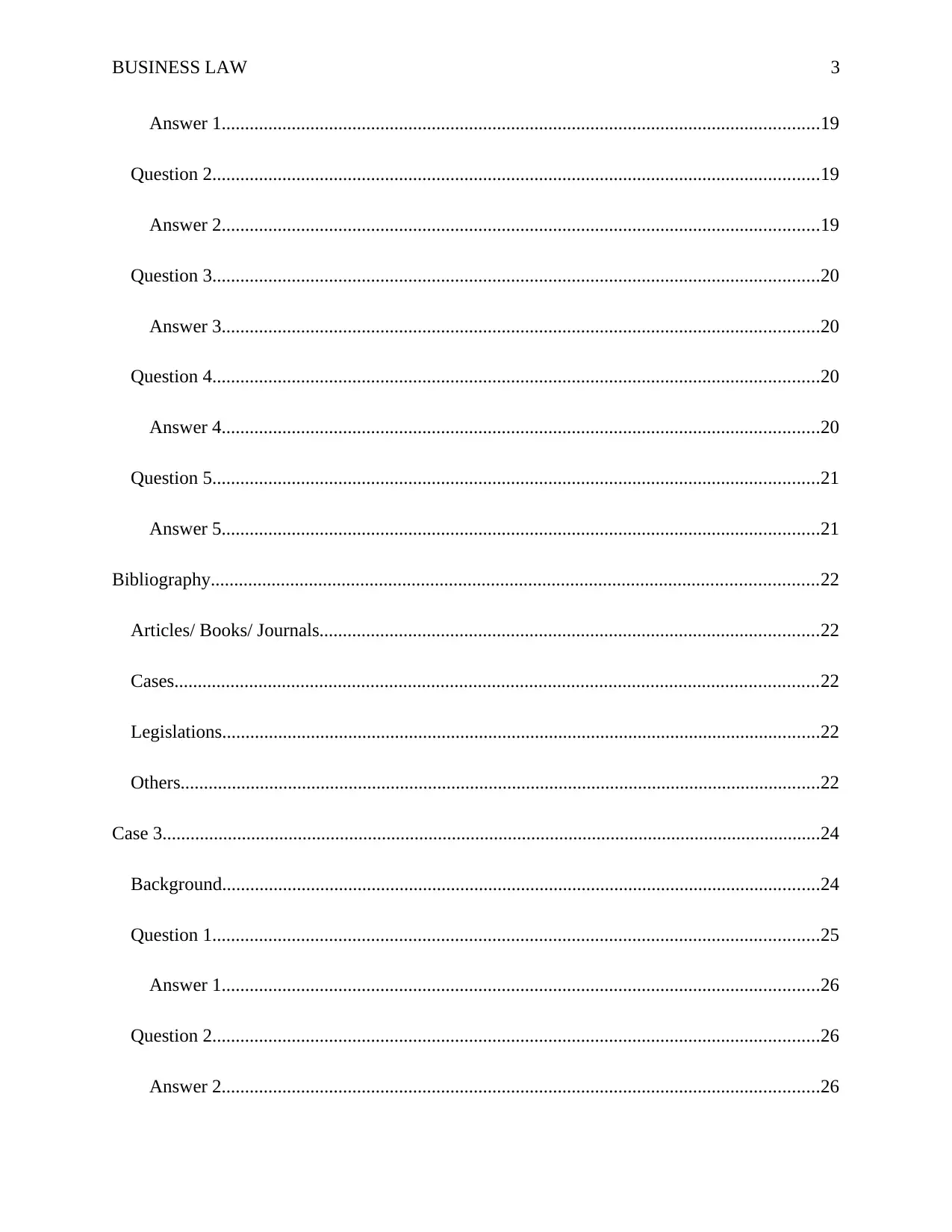
BUSINESS LAW 3
Answer 1................................................................................................................................19
Question 2..................................................................................................................................19
Answer 2................................................................................................................................19
Question 3..................................................................................................................................20
Answer 3................................................................................................................................20
Question 4..................................................................................................................................20
Answer 4................................................................................................................................20
Question 5..................................................................................................................................21
Answer 5................................................................................................................................21
Bibliography..................................................................................................................................22
Articles/ Books/ Journals...........................................................................................................22
Cases..........................................................................................................................................22
Legislations................................................................................................................................22
Others.........................................................................................................................................22
Case 3.............................................................................................................................................24
Background................................................................................................................................24
Question 1..................................................................................................................................25
Answer 1................................................................................................................................26
Question 2..................................................................................................................................26
Answer 2................................................................................................................................26
Answer 1................................................................................................................................19
Question 2..................................................................................................................................19
Answer 2................................................................................................................................19
Question 3..................................................................................................................................20
Answer 3................................................................................................................................20
Question 4..................................................................................................................................20
Answer 4................................................................................................................................20
Question 5..................................................................................................................................21
Answer 5................................................................................................................................21
Bibliography..................................................................................................................................22
Articles/ Books/ Journals...........................................................................................................22
Cases..........................................................................................................................................22
Legislations................................................................................................................................22
Others.........................................................................................................................................22
Case 3.............................................................................................................................................24
Background................................................................................................................................24
Question 1..................................................................................................................................25
Answer 1................................................................................................................................26
Question 2..................................................................................................................................26
Answer 2................................................................................................................................26
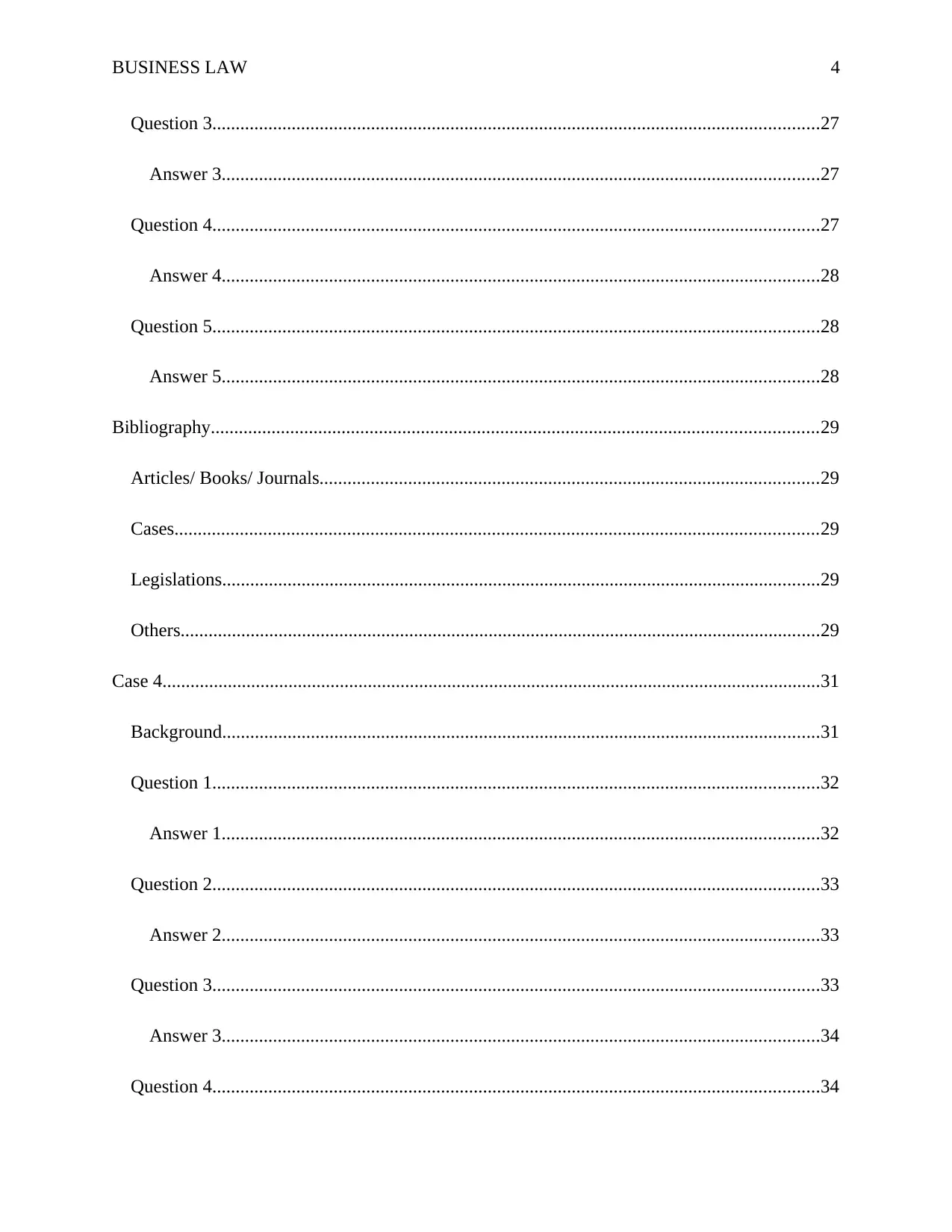
BUSINESS LAW 4
Question 3..................................................................................................................................27
Answer 3................................................................................................................................27
Question 4..................................................................................................................................27
Answer 4................................................................................................................................28
Question 5..................................................................................................................................28
Answer 5................................................................................................................................28
Bibliography..................................................................................................................................29
Articles/ Books/ Journals...........................................................................................................29
Cases..........................................................................................................................................29
Legislations................................................................................................................................29
Others.........................................................................................................................................29
Case 4.............................................................................................................................................31
Background................................................................................................................................31
Question 1..................................................................................................................................32
Answer 1................................................................................................................................32
Question 2..................................................................................................................................33
Answer 2................................................................................................................................33
Question 3..................................................................................................................................33
Answer 3................................................................................................................................34
Question 4..................................................................................................................................34
Question 3..................................................................................................................................27
Answer 3................................................................................................................................27
Question 4..................................................................................................................................27
Answer 4................................................................................................................................28
Question 5..................................................................................................................................28
Answer 5................................................................................................................................28
Bibliography..................................................................................................................................29
Articles/ Books/ Journals...........................................................................................................29
Cases..........................................................................................................................................29
Legislations................................................................................................................................29
Others.........................................................................................................................................29
Case 4.............................................................................................................................................31
Background................................................................................................................................31
Question 1..................................................................................................................................32
Answer 1................................................................................................................................32
Question 2..................................................................................................................................33
Answer 2................................................................................................................................33
Question 3..................................................................................................................................33
Answer 3................................................................................................................................34
Question 4..................................................................................................................................34
Secure Best Marks with AI Grader
Need help grading? Try our AI Grader for instant feedback on your assignments.
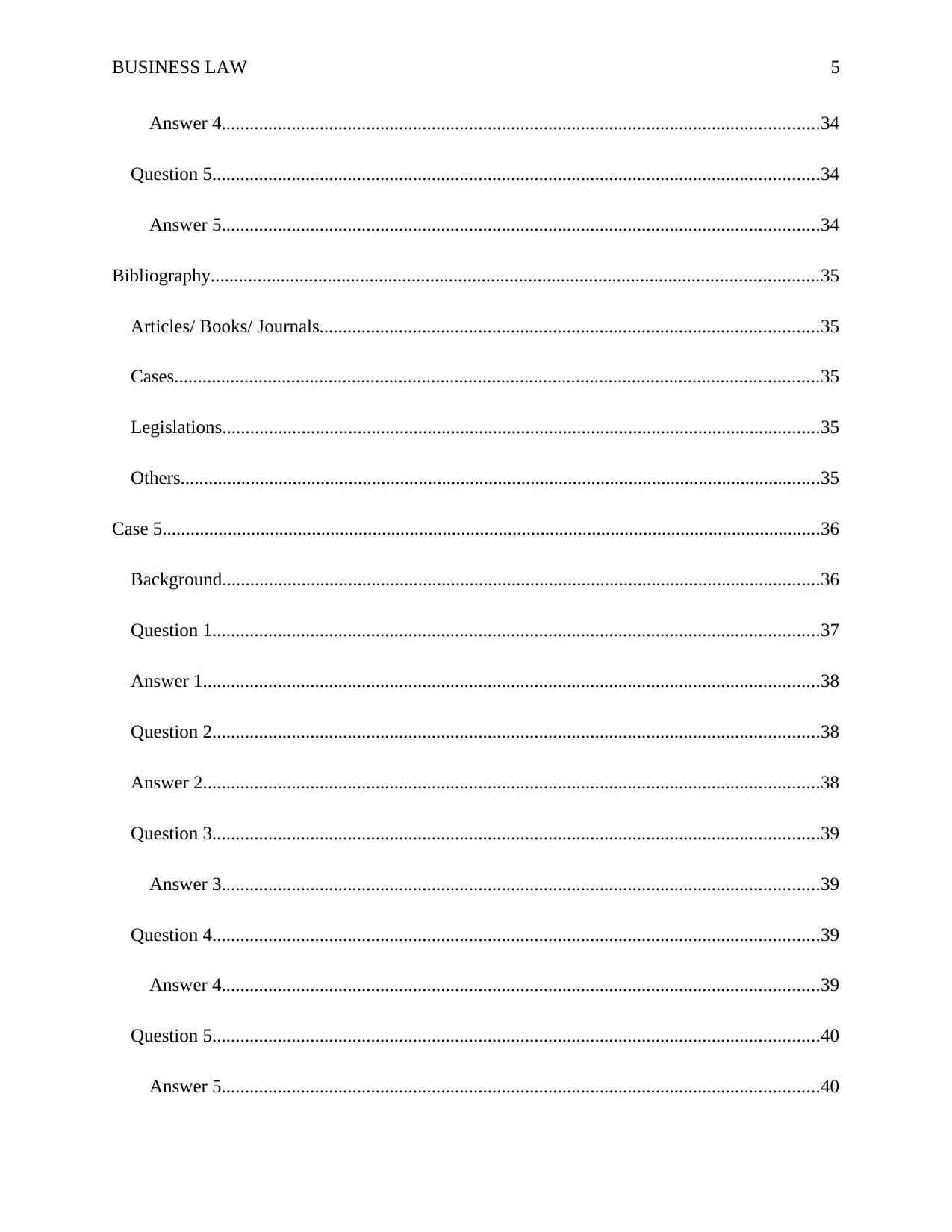
BUSINESS LAW 5
Answer 4................................................................................................................................34
Question 5..................................................................................................................................34
Answer 5................................................................................................................................34
Bibliography..................................................................................................................................35
Articles/ Books/ Journals...........................................................................................................35
Cases..........................................................................................................................................35
Legislations................................................................................................................................35
Others.........................................................................................................................................35
Case 5.............................................................................................................................................36
Background................................................................................................................................36
Question 1..................................................................................................................................37
Answer 1....................................................................................................................................38
Question 2..................................................................................................................................38
Answer 2....................................................................................................................................38
Question 3..................................................................................................................................39
Answer 3................................................................................................................................39
Question 4..................................................................................................................................39
Answer 4................................................................................................................................39
Question 5..................................................................................................................................40
Answer 5................................................................................................................................40
Answer 4................................................................................................................................34
Question 5..................................................................................................................................34
Answer 5................................................................................................................................34
Bibliography..................................................................................................................................35
Articles/ Books/ Journals...........................................................................................................35
Cases..........................................................................................................................................35
Legislations................................................................................................................................35
Others.........................................................................................................................................35
Case 5.............................................................................................................................................36
Background................................................................................................................................36
Question 1..................................................................................................................................37
Answer 1....................................................................................................................................38
Question 2..................................................................................................................................38
Answer 2....................................................................................................................................38
Question 3..................................................................................................................................39
Answer 3................................................................................................................................39
Question 4..................................................................................................................................39
Answer 4................................................................................................................................39
Question 5..................................................................................................................................40
Answer 5................................................................................................................................40
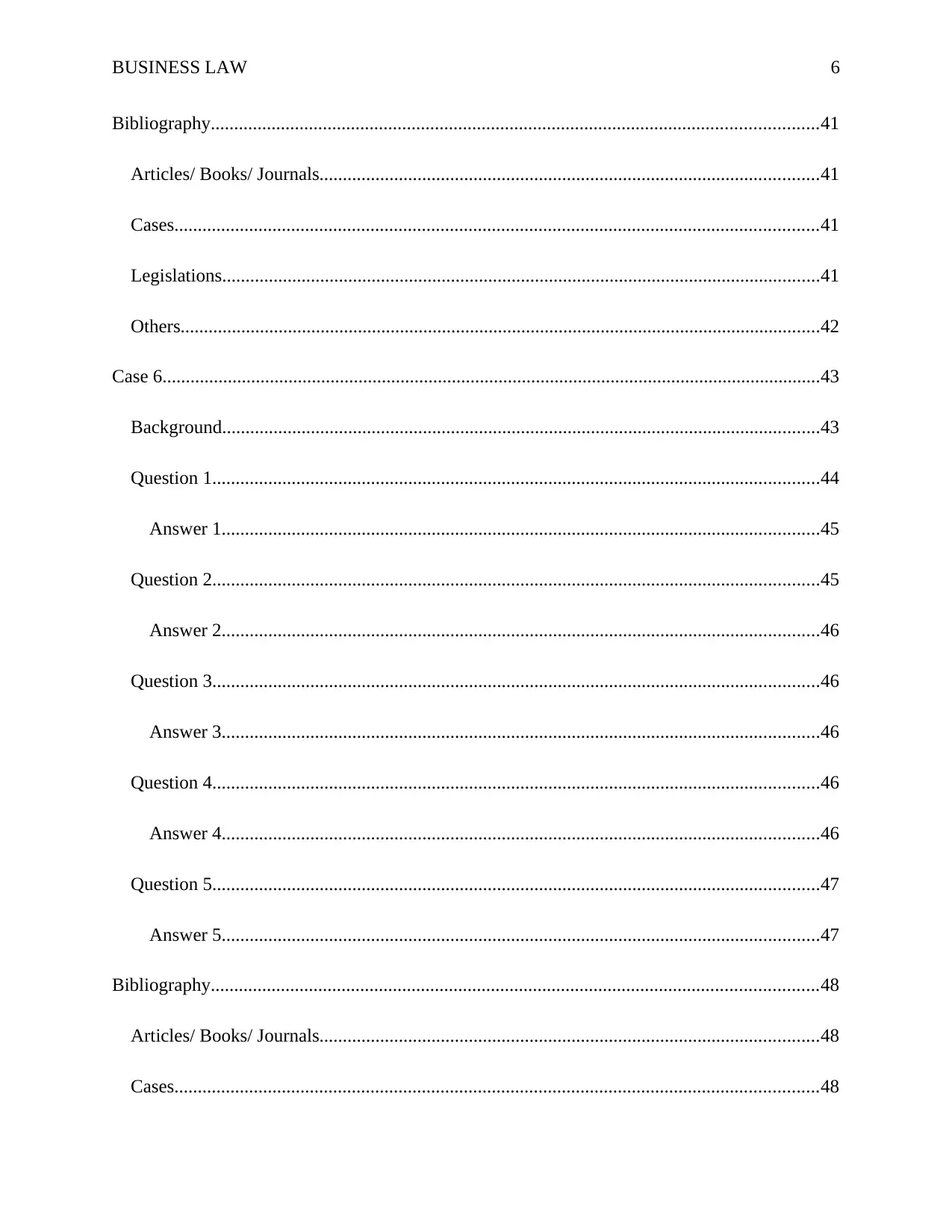
BUSINESS LAW 6
Bibliography..................................................................................................................................41
Articles/ Books/ Journals...........................................................................................................41
Cases..........................................................................................................................................41
Legislations................................................................................................................................41
Others.........................................................................................................................................42
Case 6.............................................................................................................................................43
Background................................................................................................................................43
Question 1..................................................................................................................................44
Answer 1................................................................................................................................45
Question 2..................................................................................................................................45
Answer 2................................................................................................................................46
Question 3..................................................................................................................................46
Answer 3................................................................................................................................46
Question 4..................................................................................................................................46
Answer 4................................................................................................................................46
Question 5..................................................................................................................................47
Answer 5................................................................................................................................47
Bibliography..................................................................................................................................48
Articles/ Books/ Journals...........................................................................................................48
Cases..........................................................................................................................................48
Bibliography..................................................................................................................................41
Articles/ Books/ Journals...........................................................................................................41
Cases..........................................................................................................................................41
Legislations................................................................................................................................41
Others.........................................................................................................................................42
Case 6.............................................................................................................................................43
Background................................................................................................................................43
Question 1..................................................................................................................................44
Answer 1................................................................................................................................45
Question 2..................................................................................................................................45
Answer 2................................................................................................................................46
Question 3..................................................................................................................................46
Answer 3................................................................................................................................46
Question 4..................................................................................................................................46
Answer 4................................................................................................................................46
Question 5..................................................................................................................................47
Answer 5................................................................................................................................47
Bibliography..................................................................................................................................48
Articles/ Books/ Journals...........................................................................................................48
Cases..........................................................................................................................................48
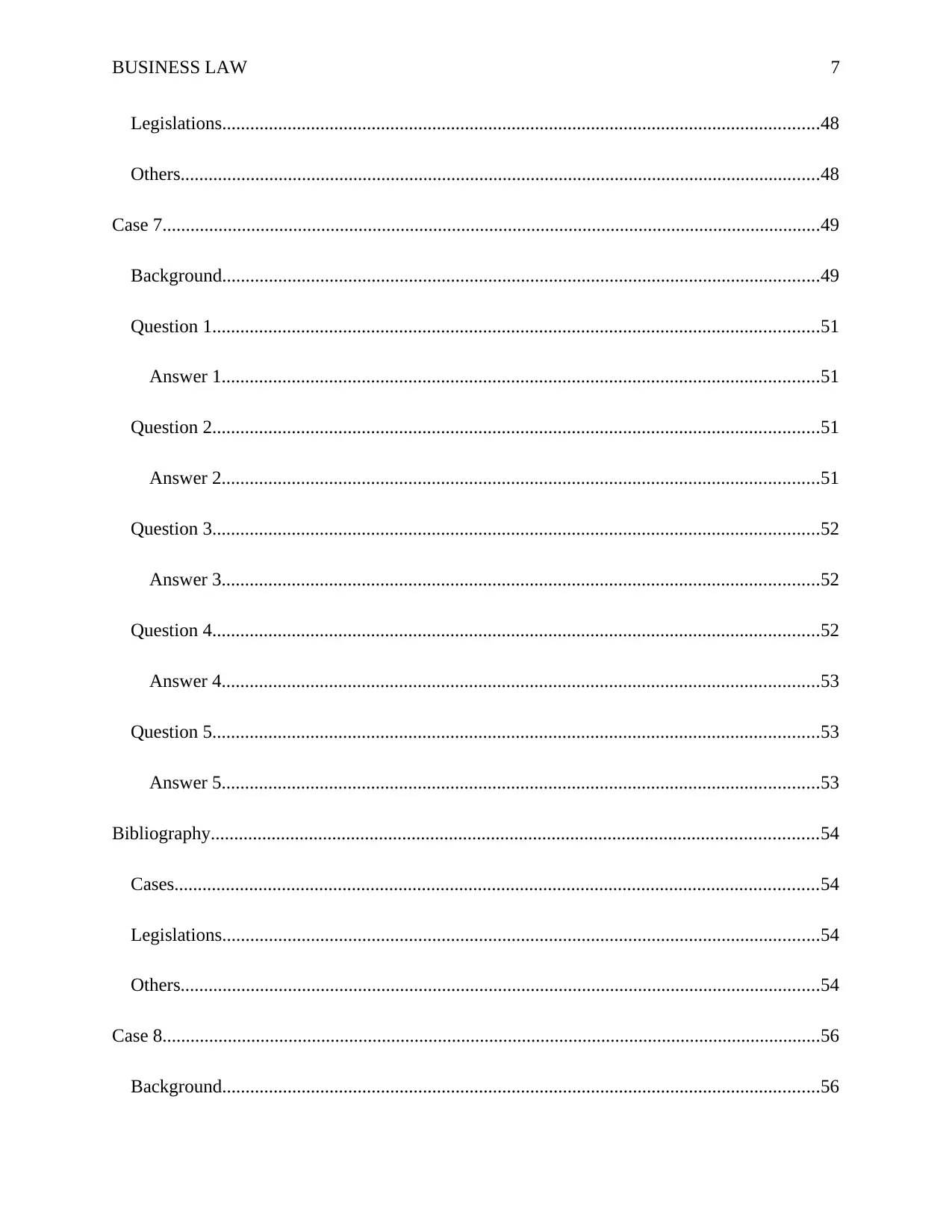
BUSINESS LAW 7
Legislations................................................................................................................................48
Others.........................................................................................................................................48
Case 7.............................................................................................................................................49
Background................................................................................................................................49
Question 1..................................................................................................................................51
Answer 1................................................................................................................................51
Question 2..................................................................................................................................51
Answer 2................................................................................................................................51
Question 3..................................................................................................................................52
Answer 3................................................................................................................................52
Question 4..................................................................................................................................52
Answer 4................................................................................................................................53
Question 5..................................................................................................................................53
Answer 5................................................................................................................................53
Bibliography..................................................................................................................................54
Cases..........................................................................................................................................54
Legislations................................................................................................................................54
Others.........................................................................................................................................54
Case 8.............................................................................................................................................56
Background................................................................................................................................56
Legislations................................................................................................................................48
Others.........................................................................................................................................48
Case 7.............................................................................................................................................49
Background................................................................................................................................49
Question 1..................................................................................................................................51
Answer 1................................................................................................................................51
Question 2..................................................................................................................................51
Answer 2................................................................................................................................51
Question 3..................................................................................................................................52
Answer 3................................................................................................................................52
Question 4..................................................................................................................................52
Answer 4................................................................................................................................53
Question 5..................................................................................................................................53
Answer 5................................................................................................................................53
Bibliography..................................................................................................................................54
Cases..........................................................................................................................................54
Legislations................................................................................................................................54
Others.........................................................................................................................................54
Case 8.............................................................................................................................................56
Background................................................................................................................................56
Paraphrase This Document
Need a fresh take? Get an instant paraphrase of this document with our AI Paraphraser
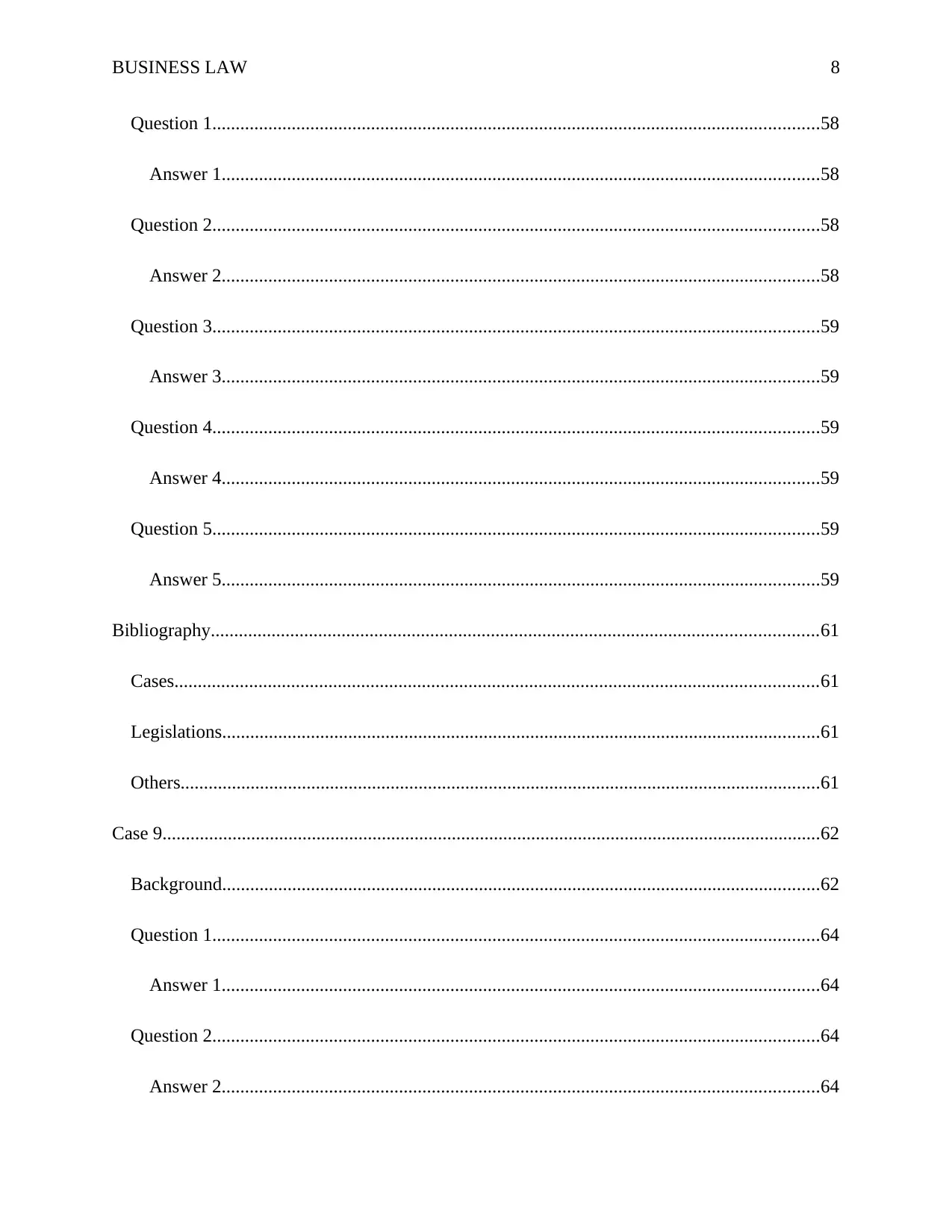
BUSINESS LAW 8
Question 1..................................................................................................................................58
Answer 1................................................................................................................................58
Question 2..................................................................................................................................58
Answer 2................................................................................................................................58
Question 3..................................................................................................................................59
Answer 3................................................................................................................................59
Question 4..................................................................................................................................59
Answer 4................................................................................................................................59
Question 5..................................................................................................................................59
Answer 5................................................................................................................................59
Bibliography..................................................................................................................................61
Cases..........................................................................................................................................61
Legislations................................................................................................................................61
Others.........................................................................................................................................61
Case 9.............................................................................................................................................62
Background................................................................................................................................62
Question 1..................................................................................................................................64
Answer 1................................................................................................................................64
Question 2..................................................................................................................................64
Answer 2................................................................................................................................64
Question 1..................................................................................................................................58
Answer 1................................................................................................................................58
Question 2..................................................................................................................................58
Answer 2................................................................................................................................58
Question 3..................................................................................................................................59
Answer 3................................................................................................................................59
Question 4..................................................................................................................................59
Answer 4................................................................................................................................59
Question 5..................................................................................................................................59
Answer 5................................................................................................................................59
Bibliography..................................................................................................................................61
Cases..........................................................................................................................................61
Legislations................................................................................................................................61
Others.........................................................................................................................................61
Case 9.............................................................................................................................................62
Background................................................................................................................................62
Question 1..................................................................................................................................64
Answer 1................................................................................................................................64
Question 2..................................................................................................................................64
Answer 2................................................................................................................................64
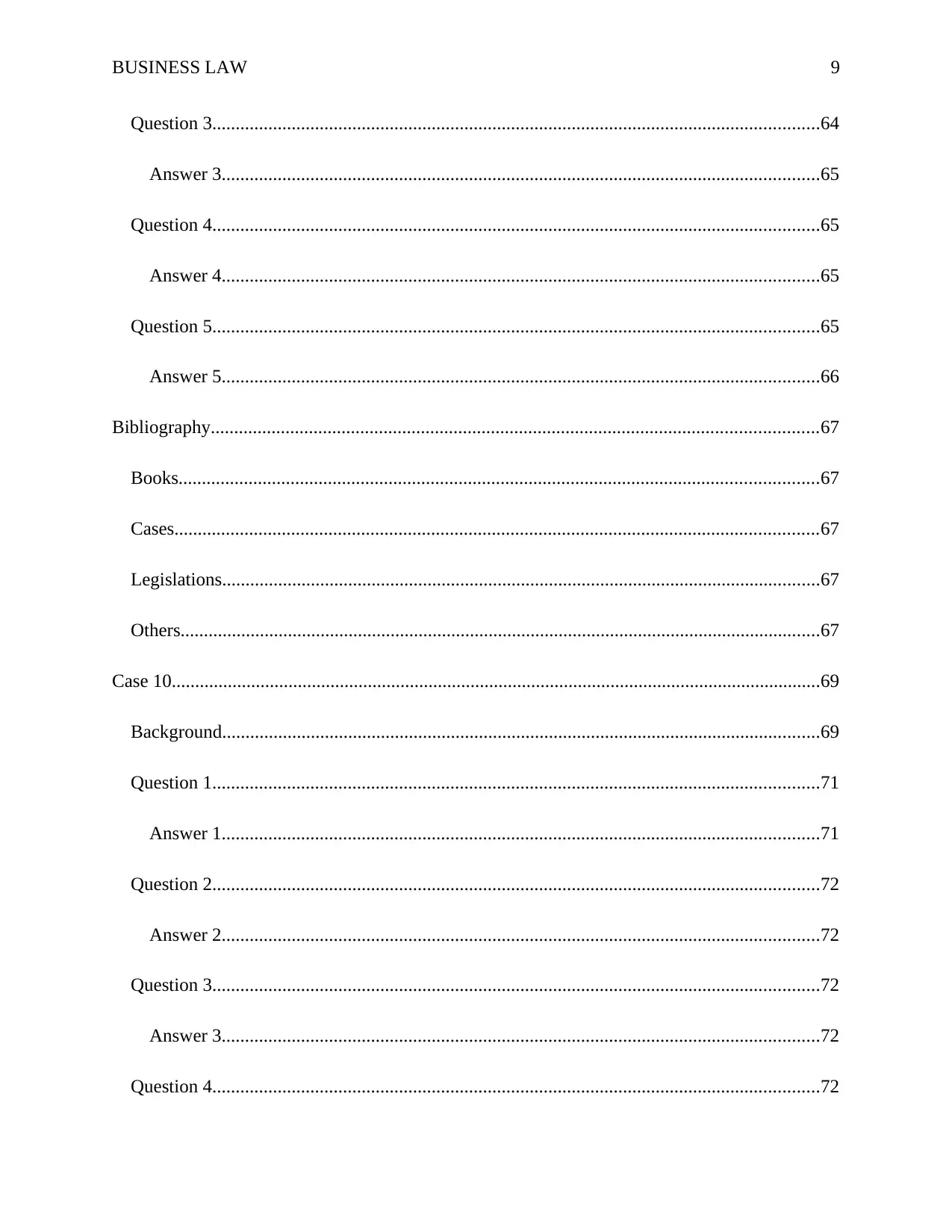
BUSINESS LAW 9
Question 3..................................................................................................................................64
Answer 3................................................................................................................................65
Question 4..................................................................................................................................65
Answer 4................................................................................................................................65
Question 5..................................................................................................................................65
Answer 5................................................................................................................................66
Bibliography..................................................................................................................................67
Books.........................................................................................................................................67
Cases..........................................................................................................................................67
Legislations................................................................................................................................67
Others.........................................................................................................................................67
Case 10...........................................................................................................................................69
Background................................................................................................................................69
Question 1..................................................................................................................................71
Answer 1................................................................................................................................71
Question 2..................................................................................................................................72
Answer 2................................................................................................................................72
Question 3..................................................................................................................................72
Answer 3................................................................................................................................72
Question 4..................................................................................................................................72
Question 3..................................................................................................................................64
Answer 3................................................................................................................................65
Question 4..................................................................................................................................65
Answer 4................................................................................................................................65
Question 5..................................................................................................................................65
Answer 5................................................................................................................................66
Bibliography..................................................................................................................................67
Books.........................................................................................................................................67
Cases..........................................................................................................................................67
Legislations................................................................................................................................67
Others.........................................................................................................................................67
Case 10...........................................................................................................................................69
Background................................................................................................................................69
Question 1..................................................................................................................................71
Answer 1................................................................................................................................71
Question 2..................................................................................................................................72
Answer 2................................................................................................................................72
Question 3..................................................................................................................................72
Answer 3................................................................................................................................72
Question 4..................................................................................................................................72

BUSINESS LAW 10
Answer 4................................................................................................................................72
Question 5..................................................................................................................................73
Answer 5................................................................................................................................73
Bibliography..................................................................................................................................74
Cases..........................................................................................................................................74
Legislations................................................................................................................................74
Others.........................................................................................................................................74
Answer 4................................................................................................................................72
Question 5..................................................................................................................................73
Answer 5................................................................................................................................73
Bibliography..................................................................................................................................74
Cases..........................................................................................................................................74
Legislations................................................................................................................................74
Others.........................................................................................................................................74
Secure Best Marks with AI Grader
Need help grading? Try our AI Grader for instant feedback on your assignments.
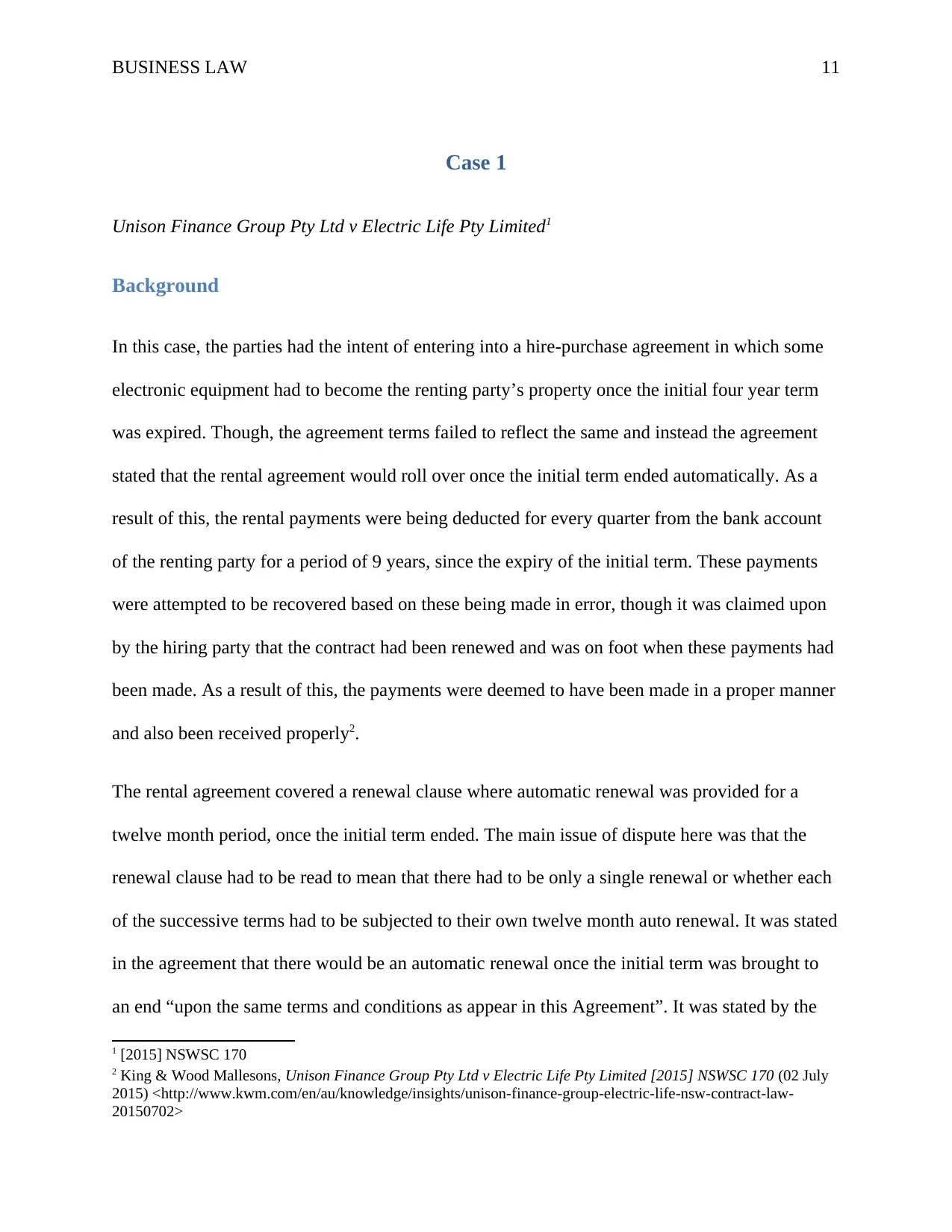
BUSINESS LAW 11
Case 1
Unison Finance Group Pty Ltd v Electric Life Pty Limited1
Background
In this case, the parties had the intent of entering into a hire-purchase agreement in which some
electronic equipment had to become the renting party’s property once the initial four year term
was expired. Though, the agreement terms failed to reflect the same and instead the agreement
stated that the rental agreement would roll over once the initial term ended automatically. As a
result of this, the rental payments were being deducted for every quarter from the bank account
of the renting party for a period of 9 years, since the expiry of the initial term. These payments
were attempted to be recovered based on these being made in error, though it was claimed upon
by the hiring party that the contract had been renewed and was on foot when these payments had
been made. As a result of this, the payments were deemed to have been made in a proper manner
and also been received properly2.
The rental agreement covered a renewal clause where automatic renewal was provided for a
twelve month period, once the initial term ended. The main issue of dispute here was that the
renewal clause had to be read to mean that there had to be only a single renewal or whether each
of the successive terms had to be subjected to their own twelve month auto renewal. It was stated
in the agreement that there would be an automatic renewal once the initial term was brought to
an end “upon the same terms and conditions as appear in this Agreement”. It was stated by the
1 [2015] NSWSC 170
2 King & Wood Mallesons, Unison Finance Group Pty Ltd v Electric Life Pty Limited [2015] NSWSC 170 (02 July
2015) <http://www.kwm.com/en/au/knowledge/insights/unison-finance-group-electric-life-nsw-contract-law-
20150702>
Case 1
Unison Finance Group Pty Ltd v Electric Life Pty Limited1
Background
In this case, the parties had the intent of entering into a hire-purchase agreement in which some
electronic equipment had to become the renting party’s property once the initial four year term
was expired. Though, the agreement terms failed to reflect the same and instead the agreement
stated that the rental agreement would roll over once the initial term ended automatically. As a
result of this, the rental payments were being deducted for every quarter from the bank account
of the renting party for a period of 9 years, since the expiry of the initial term. These payments
were attempted to be recovered based on these being made in error, though it was claimed upon
by the hiring party that the contract had been renewed and was on foot when these payments had
been made. As a result of this, the payments were deemed to have been made in a proper manner
and also been received properly2.
The rental agreement covered a renewal clause where automatic renewal was provided for a
twelve month period, once the initial term ended. The main issue of dispute here was that the
renewal clause had to be read to mean that there had to be only a single renewal or whether each
of the successive terms had to be subjected to their own twelve month auto renewal. It was stated
in the agreement that there would be an automatic renewal once the initial term was brought to
an end “upon the same terms and conditions as appear in this Agreement”. It was stated by the
1 [2015] NSWSC 170
2 King & Wood Mallesons, Unison Finance Group Pty Ltd v Electric Life Pty Limited [2015] NSWSC 170 (02 July
2015) <http://www.kwm.com/en/au/knowledge/insights/unison-finance-group-electric-life-nsw-contract-law-
20150702>
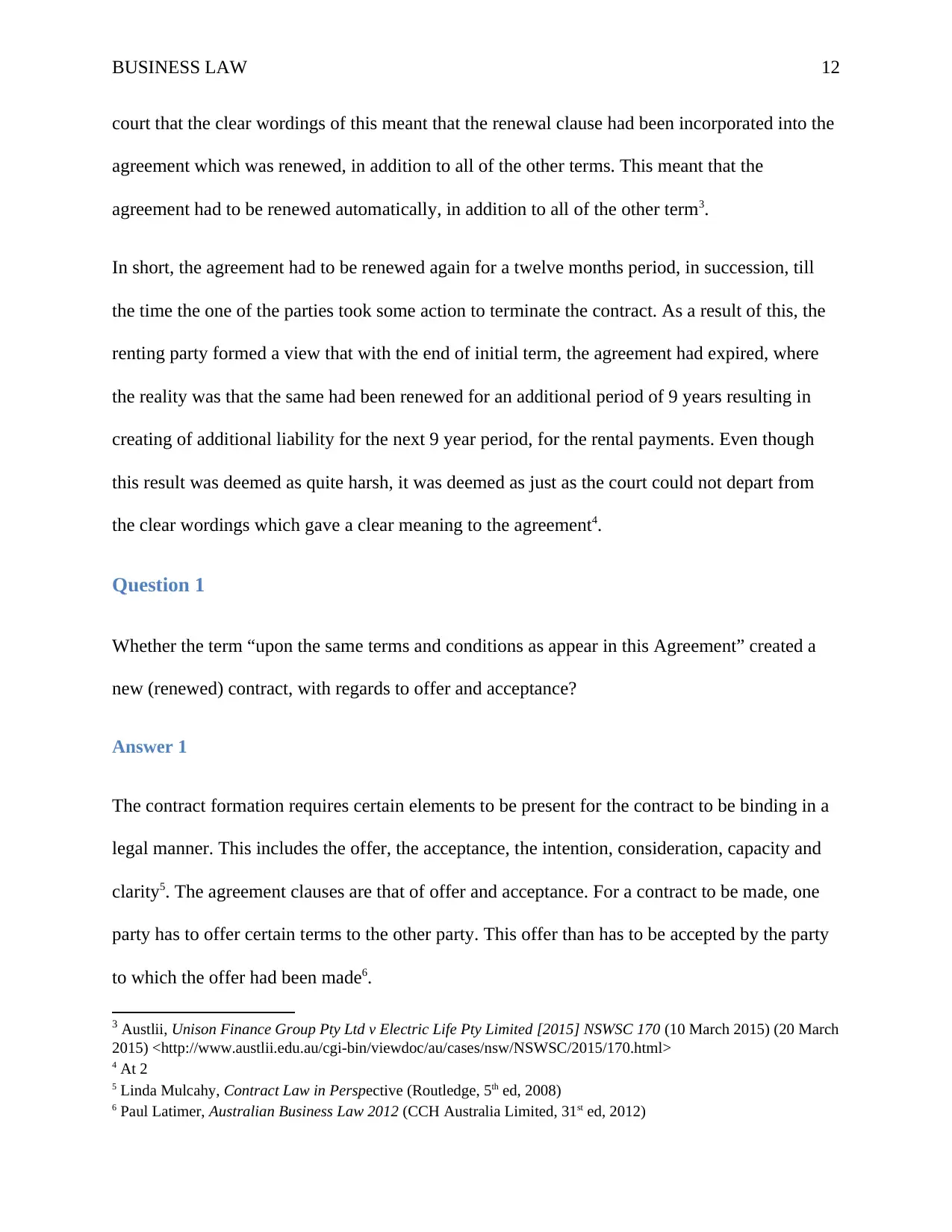
BUSINESS LAW 12
court that the clear wordings of this meant that the renewal clause had been incorporated into the
agreement which was renewed, in addition to all of the other terms. This meant that the
agreement had to be renewed automatically, in addition to all of the other term3.
In short, the agreement had to be renewed again for a twelve months period, in succession, till
the time the one of the parties took some action to terminate the contract. As a result of this, the
renting party formed a view that with the end of initial term, the agreement had expired, where
the reality was that the same had been renewed for an additional period of 9 years resulting in
creating of additional liability for the next 9 year period, for the rental payments. Even though
this result was deemed as quite harsh, it was deemed as just as the court could not depart from
the clear wordings which gave a clear meaning to the agreement4.
Question 1
Whether the term “upon the same terms and conditions as appear in this Agreement” created a
new (renewed) contract, with regards to offer and acceptance?
Answer 1
The contract formation requires certain elements to be present for the contract to be binding in a
legal manner. This includes the offer, the acceptance, the intention, consideration, capacity and
clarity5. The agreement clauses are that of offer and acceptance. For a contract to be made, one
party has to offer certain terms to the other party. This offer than has to be accepted by the party
to which the offer had been made6.
3 Austlii, Unison Finance Group Pty Ltd v Electric Life Pty Limited [2015] NSWSC 170 (10 March 2015) (20 March
2015) <http://www.austlii.edu.au/cgi-bin/viewdoc/au/cases/nsw/NSWSC/2015/170.html>
4 At 2
5 Linda Mulcahy, Contract Law in Perspective (Routledge, 5th ed, 2008)
6 Paul Latimer, Australian Business Law 2012 (CCH Australia Limited, 31st ed, 2012)
court that the clear wordings of this meant that the renewal clause had been incorporated into the
agreement which was renewed, in addition to all of the other terms. This meant that the
agreement had to be renewed automatically, in addition to all of the other term3.
In short, the agreement had to be renewed again for a twelve months period, in succession, till
the time the one of the parties took some action to terminate the contract. As a result of this, the
renting party formed a view that with the end of initial term, the agreement had expired, where
the reality was that the same had been renewed for an additional period of 9 years resulting in
creating of additional liability for the next 9 year period, for the rental payments. Even though
this result was deemed as quite harsh, it was deemed as just as the court could not depart from
the clear wordings which gave a clear meaning to the agreement4.
Question 1
Whether the term “upon the same terms and conditions as appear in this Agreement” created a
new (renewed) contract, with regards to offer and acceptance?
Answer 1
The contract formation requires certain elements to be present for the contract to be binding in a
legal manner. This includes the offer, the acceptance, the intention, consideration, capacity and
clarity5. The agreement clauses are that of offer and acceptance. For a contract to be made, one
party has to offer certain terms to the other party. This offer than has to be accepted by the party
to which the offer had been made6.
3 Austlii, Unison Finance Group Pty Ltd v Electric Life Pty Limited [2015] NSWSC 170 (10 March 2015) (20 March
2015) <http://www.austlii.edu.au/cgi-bin/viewdoc/au/cases/nsw/NSWSC/2015/170.html>
4 At 2
5 Linda Mulcahy, Contract Law in Perspective (Routledge, 5th ed, 2008)
6 Paul Latimer, Australian Business Law 2012 (CCH Australia Limited, 31st ed, 2012)
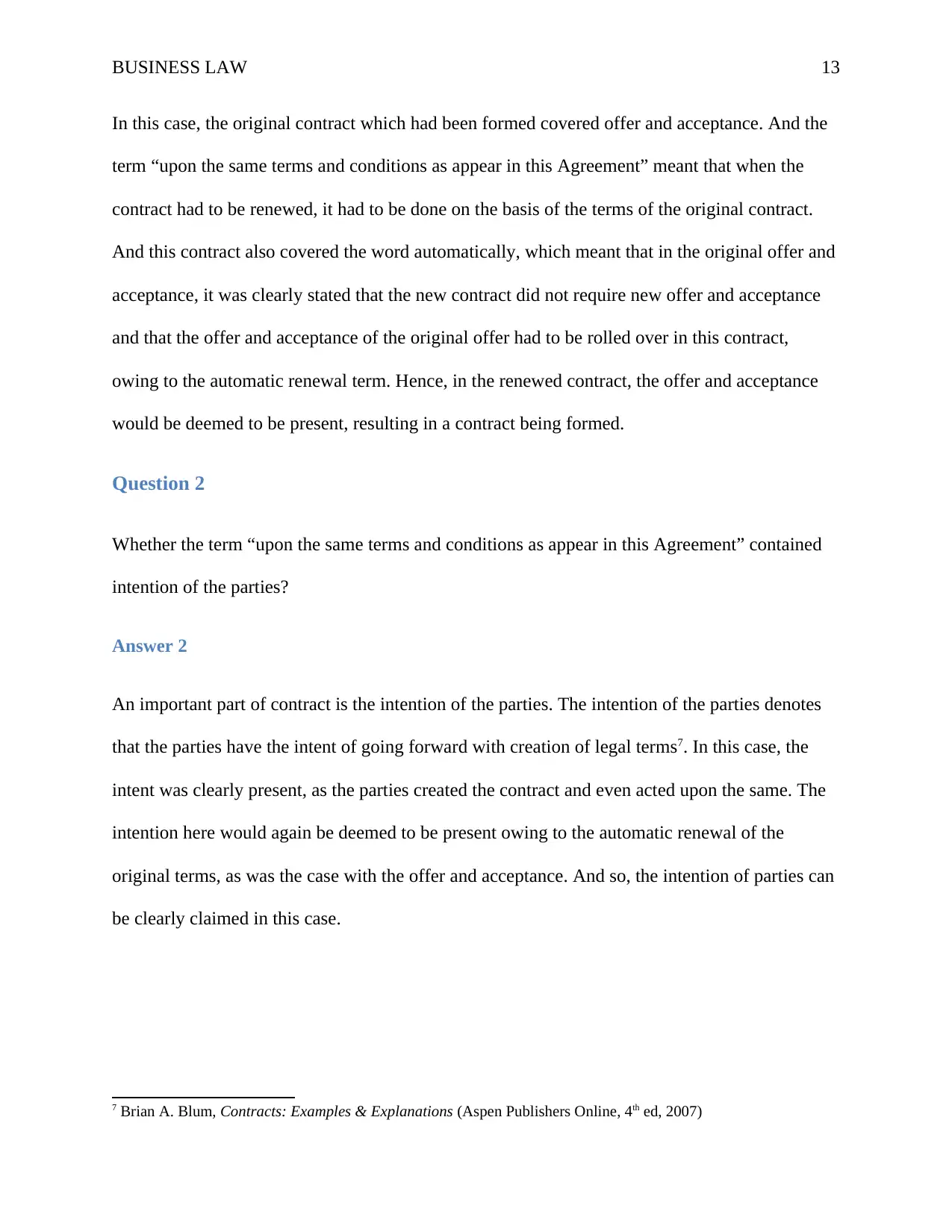
BUSINESS LAW 13
In this case, the original contract which had been formed covered offer and acceptance. And the
term “upon the same terms and conditions as appear in this Agreement” meant that when the
contract had to be renewed, it had to be done on the basis of the terms of the original contract.
And this contract also covered the word automatically, which meant that in the original offer and
acceptance, it was clearly stated that the new contract did not require new offer and acceptance
and that the offer and acceptance of the original offer had to be rolled over in this contract,
owing to the automatic renewal term. Hence, in the renewed contract, the offer and acceptance
would be deemed to be present, resulting in a contract being formed.
Question 2
Whether the term “upon the same terms and conditions as appear in this Agreement” contained
intention of the parties?
Answer 2
An important part of contract is the intention of the parties. The intention of the parties denotes
that the parties have the intent of going forward with creation of legal terms7. In this case, the
intent was clearly present, as the parties created the contract and even acted upon the same. The
intention here would again be deemed to be present owing to the automatic renewal of the
original terms, as was the case with the offer and acceptance. And so, the intention of parties can
be clearly claimed in this case.
7 Brian A. Blum, Contracts: Examples & Explanations (Aspen Publishers Online, 4th ed, 2007)
In this case, the original contract which had been formed covered offer and acceptance. And the
term “upon the same terms and conditions as appear in this Agreement” meant that when the
contract had to be renewed, it had to be done on the basis of the terms of the original contract.
And this contract also covered the word automatically, which meant that in the original offer and
acceptance, it was clearly stated that the new contract did not require new offer and acceptance
and that the offer and acceptance of the original offer had to be rolled over in this contract,
owing to the automatic renewal term. Hence, in the renewed contract, the offer and acceptance
would be deemed to be present, resulting in a contract being formed.
Question 2
Whether the term “upon the same terms and conditions as appear in this Agreement” contained
intention of the parties?
Answer 2
An important part of contract is the intention of the parties. The intention of the parties denotes
that the parties have the intent of going forward with creation of legal terms7. In this case, the
intent was clearly present, as the parties created the contract and even acted upon the same. The
intention here would again be deemed to be present owing to the automatic renewal of the
original terms, as was the case with the offer and acceptance. And so, the intention of parties can
be clearly claimed in this case.
7 Brian A. Blum, Contracts: Examples & Explanations (Aspen Publishers Online, 4th ed, 2007)
Paraphrase This Document
Need a fresh take? Get an instant paraphrase of this document with our AI Paraphraser
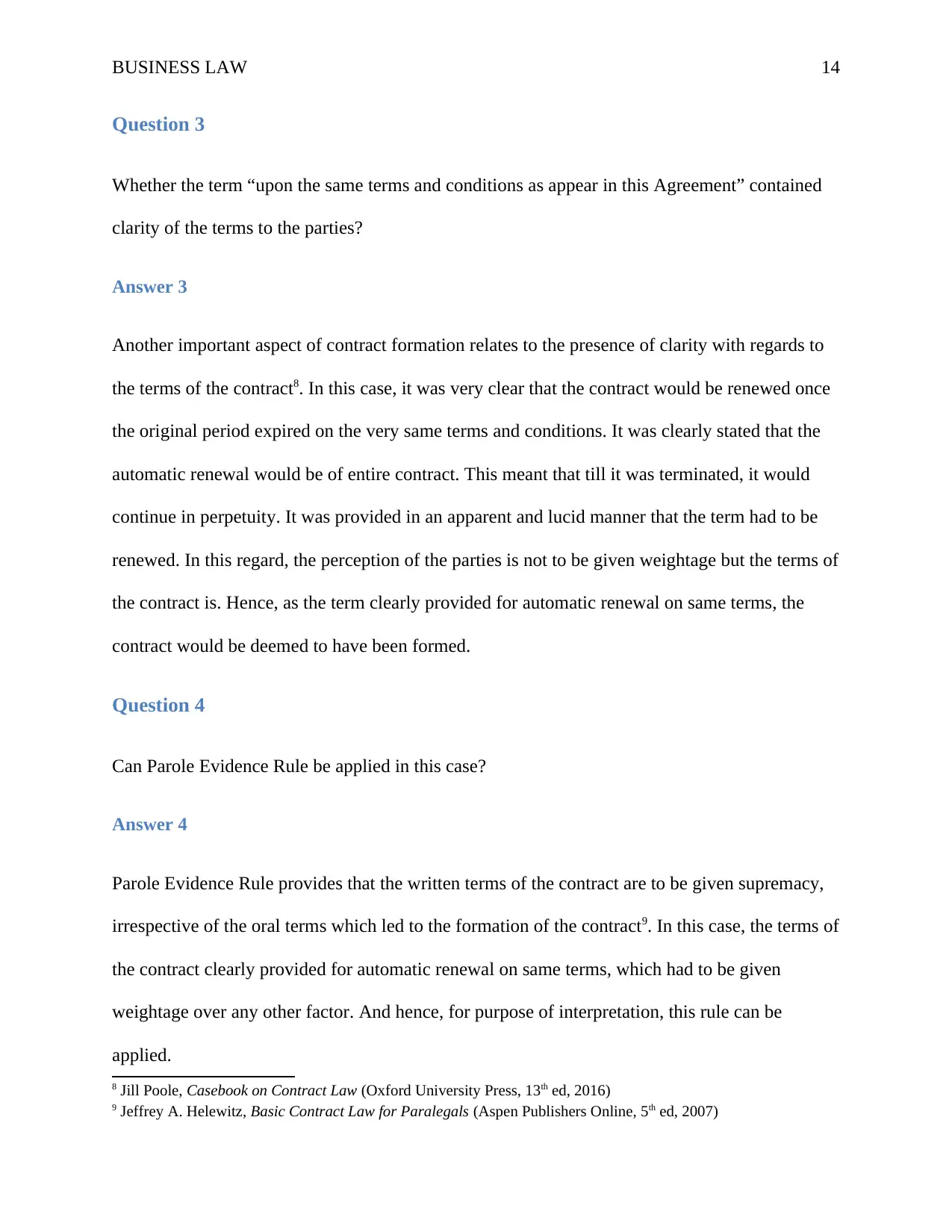
BUSINESS LAW 14
Question 3
Whether the term “upon the same terms and conditions as appear in this Agreement” contained
clarity of the terms to the parties?
Answer 3
Another important aspect of contract formation relates to the presence of clarity with regards to
the terms of the contract8. In this case, it was very clear that the contract would be renewed once
the original period expired on the very same terms and conditions. It was clearly stated that the
automatic renewal would be of entire contract. This meant that till it was terminated, it would
continue in perpetuity. It was provided in an apparent and lucid manner that the term had to be
renewed. In this regard, the perception of the parties is not to be given weightage but the terms of
the contract is. Hence, as the term clearly provided for automatic renewal on same terms, the
contract would be deemed to have been formed.
Question 4
Can Parole Evidence Rule be applied in this case?
Answer 4
Parole Evidence Rule provides that the written terms of the contract are to be given supremacy,
irrespective of the oral terms which led to the formation of the contract9. In this case, the terms of
the contract clearly provided for automatic renewal on same terms, which had to be given
weightage over any other factor. And hence, for purpose of interpretation, this rule can be
applied.
8 Jill Poole, Casebook on Contract Law (Oxford University Press, 13th ed, 2016)
9 Jeffrey A. Helewitz, Basic Contract Law for Paralegals (Aspen Publishers Online, 5th ed, 2007)
Question 3
Whether the term “upon the same terms and conditions as appear in this Agreement” contained
clarity of the terms to the parties?
Answer 3
Another important aspect of contract formation relates to the presence of clarity with regards to
the terms of the contract8. In this case, it was very clear that the contract would be renewed once
the original period expired on the very same terms and conditions. It was clearly stated that the
automatic renewal would be of entire contract. This meant that till it was terminated, it would
continue in perpetuity. It was provided in an apparent and lucid manner that the term had to be
renewed. In this regard, the perception of the parties is not to be given weightage but the terms of
the contract is. Hence, as the term clearly provided for automatic renewal on same terms, the
contract would be deemed to have been formed.
Question 4
Can Parole Evidence Rule be applied in this case?
Answer 4
Parole Evidence Rule provides that the written terms of the contract are to be given supremacy,
irrespective of the oral terms which led to the formation of the contract9. In this case, the terms of
the contract clearly provided for automatic renewal on same terms, which had to be given
weightage over any other factor. And hence, for purpose of interpretation, this rule can be
applied.
8 Jill Poole, Casebook on Contract Law (Oxford University Press, 13th ed, 2016)
9 Jeffrey A. Helewitz, Basic Contract Law for Paralegals (Aspen Publishers Online, 5th ed, 2007)

BUSINESS LAW 15
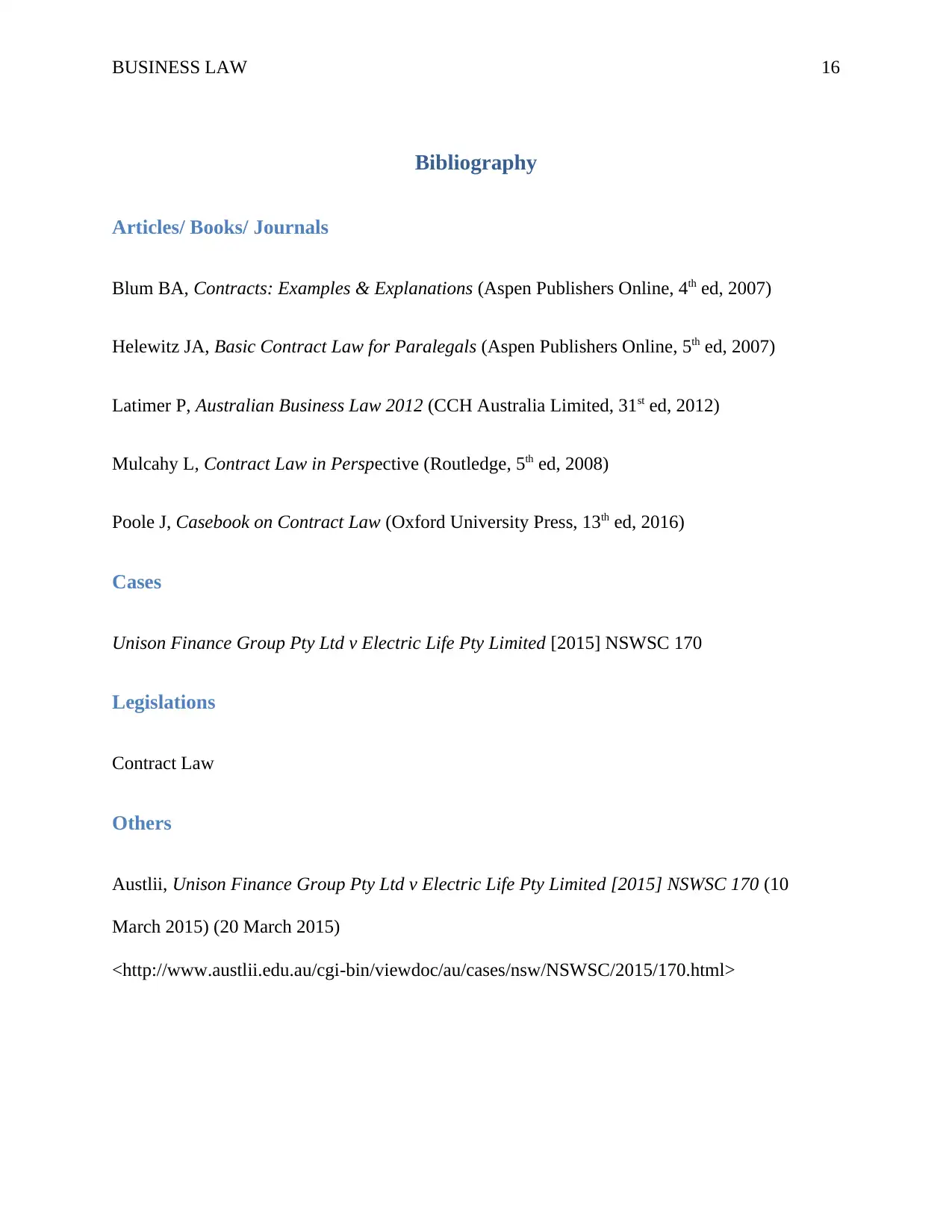
BUSINESS LAW 16
Bibliography
Articles/ Books/ Journals
Blum BA, Contracts: Examples & Explanations (Aspen Publishers Online, 4th ed, 2007)
Helewitz JA, Basic Contract Law for Paralegals (Aspen Publishers Online, 5th ed, 2007)
Latimer P, Australian Business Law 2012 (CCH Australia Limited, 31st ed, 2012)
Mulcahy L, Contract Law in Perspective (Routledge, 5th ed, 2008)
Poole J, Casebook on Contract Law (Oxford University Press, 13th ed, 2016)
Cases
Unison Finance Group Pty Ltd v Electric Life Pty Limited [2015] NSWSC 170
Legislations
Contract Law
Others
Austlii, Unison Finance Group Pty Ltd v Electric Life Pty Limited [2015] NSWSC 170 (10
March 2015) (20 March 2015)
<http://www.austlii.edu.au/cgi-bin/viewdoc/au/cases/nsw/NSWSC/2015/170.html>
Bibliography
Articles/ Books/ Journals
Blum BA, Contracts: Examples & Explanations (Aspen Publishers Online, 4th ed, 2007)
Helewitz JA, Basic Contract Law for Paralegals (Aspen Publishers Online, 5th ed, 2007)
Latimer P, Australian Business Law 2012 (CCH Australia Limited, 31st ed, 2012)
Mulcahy L, Contract Law in Perspective (Routledge, 5th ed, 2008)
Poole J, Casebook on Contract Law (Oxford University Press, 13th ed, 2016)
Cases
Unison Finance Group Pty Ltd v Electric Life Pty Limited [2015] NSWSC 170
Legislations
Contract Law
Others
Austlii, Unison Finance Group Pty Ltd v Electric Life Pty Limited [2015] NSWSC 170 (10
March 2015) (20 March 2015)
<http://www.austlii.edu.au/cgi-bin/viewdoc/au/cases/nsw/NSWSC/2015/170.html>
Secure Best Marks with AI Grader
Need help grading? Try our AI Grader for instant feedback on your assignments.
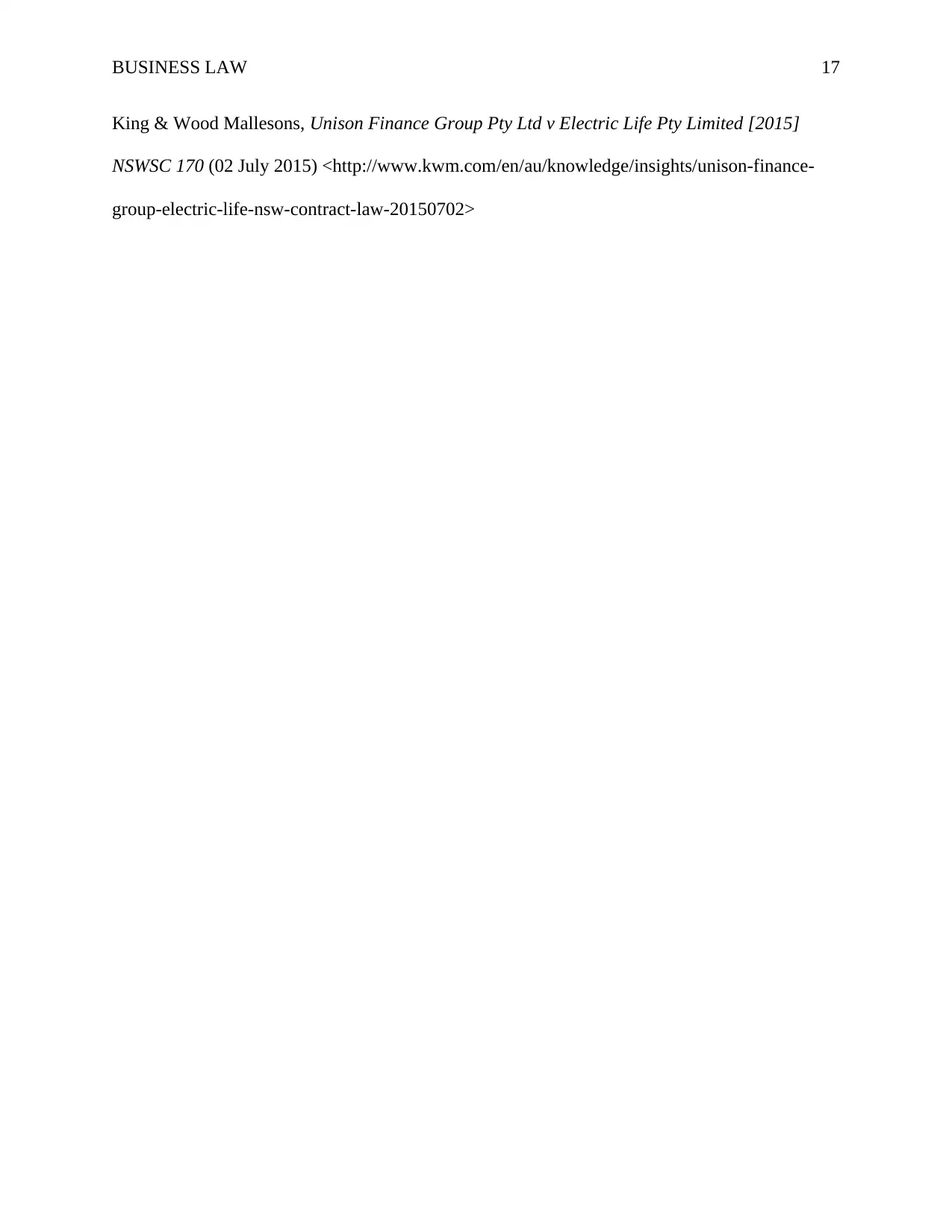
BUSINESS LAW 17
King & Wood Mallesons, Unison Finance Group Pty Ltd v Electric Life Pty Limited [2015]
NSWSC 170 (02 July 2015) <http://www.kwm.com/en/au/knowledge/insights/unison-finance-
group-electric-life-nsw-contract-law-20150702>
King & Wood Mallesons, Unison Finance Group Pty Ltd v Electric Life Pty Limited [2015]
NSWSC 170 (02 July 2015) <http://www.kwm.com/en/au/knowledge/insights/unison-finance-
group-electric-life-nsw-contract-law-20150702>
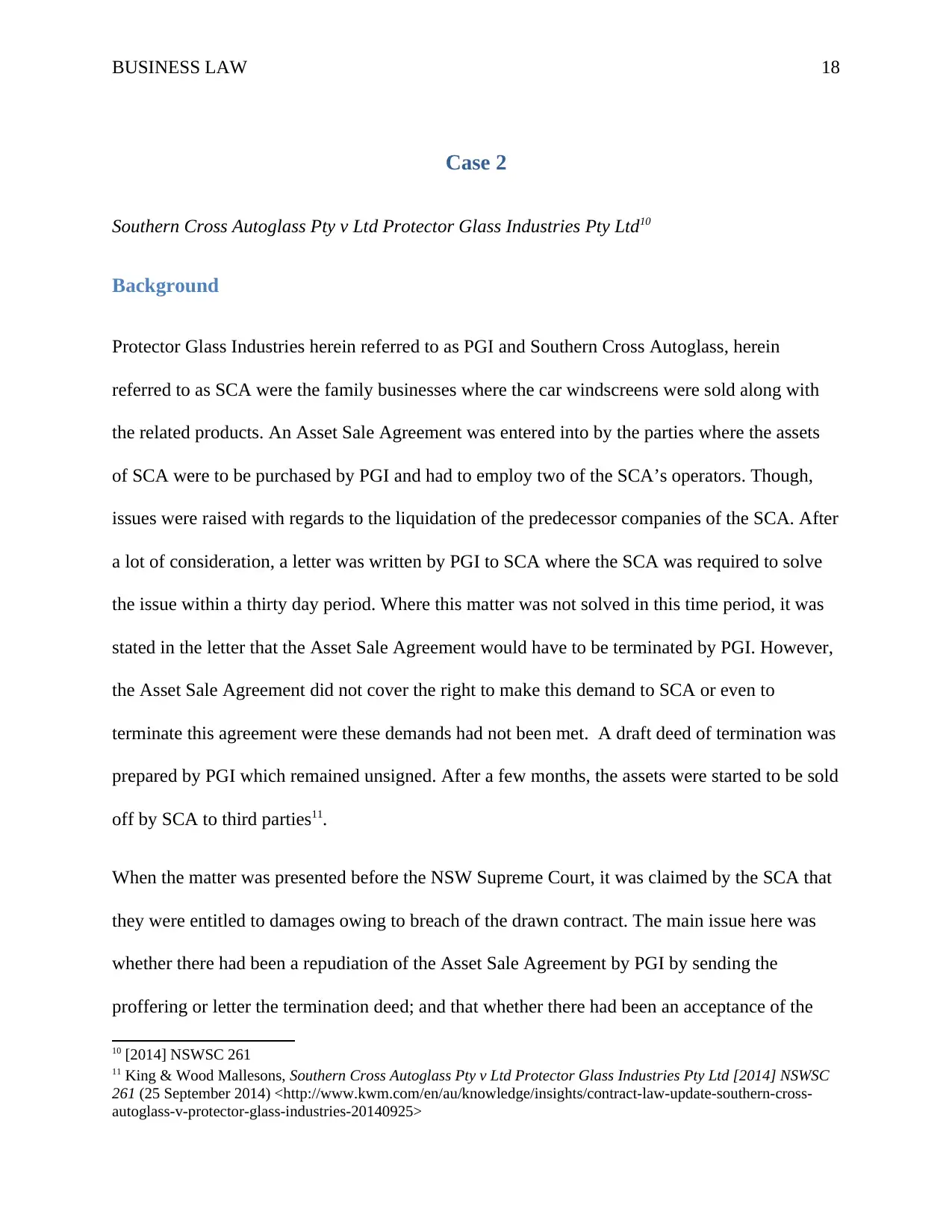
BUSINESS LAW 18
Case 2
Southern Cross Autoglass Pty v Ltd Protector Glass Industries Pty Ltd10
Background
Protector Glass Industries herein referred to as PGI and Southern Cross Autoglass, herein
referred to as SCA were the family businesses where the car windscreens were sold along with
the related products. An Asset Sale Agreement was entered into by the parties where the assets
of SCA were to be purchased by PGI and had to employ two of the SCA’s operators. Though,
issues were raised with regards to the liquidation of the predecessor companies of the SCA. After
a lot of consideration, a letter was written by PGI to SCA where the SCA was required to solve
the issue within a thirty day period. Where this matter was not solved in this time period, it was
stated in the letter that the Asset Sale Agreement would have to be terminated by PGI. However,
the Asset Sale Agreement did not cover the right to make this demand to SCA or even to
terminate this agreement were these demands had not been met. A draft deed of termination was
prepared by PGI which remained unsigned. After a few months, the assets were started to be sold
off by SCA to third parties11.
When the matter was presented before the NSW Supreme Court, it was claimed by the SCA that
they were entitled to damages owing to breach of the drawn contract. The main issue here was
whether there had been a repudiation of the Asset Sale Agreement by PGI by sending the
proffering or letter the termination deed; and that whether there had been an acceptance of the
10 [2014] NSWSC 261
11 King & Wood Mallesons, Southern Cross Autoglass Pty v Ltd Protector Glass Industries Pty Ltd [2014] NSWSC
261 (25 September 2014) <http://www.kwm.com/en/au/knowledge/insights/contract-law-update-southern-cross-
autoglass-v-protector-glass-industries-20140925>
Case 2
Southern Cross Autoglass Pty v Ltd Protector Glass Industries Pty Ltd10
Background
Protector Glass Industries herein referred to as PGI and Southern Cross Autoglass, herein
referred to as SCA were the family businesses where the car windscreens were sold along with
the related products. An Asset Sale Agreement was entered into by the parties where the assets
of SCA were to be purchased by PGI and had to employ two of the SCA’s operators. Though,
issues were raised with regards to the liquidation of the predecessor companies of the SCA. After
a lot of consideration, a letter was written by PGI to SCA where the SCA was required to solve
the issue within a thirty day period. Where this matter was not solved in this time period, it was
stated in the letter that the Asset Sale Agreement would have to be terminated by PGI. However,
the Asset Sale Agreement did not cover the right to make this demand to SCA or even to
terminate this agreement were these demands had not been met. A draft deed of termination was
prepared by PGI which remained unsigned. After a few months, the assets were started to be sold
off by SCA to third parties11.
When the matter was presented before the NSW Supreme Court, it was claimed by the SCA that
they were entitled to damages owing to breach of the drawn contract. The main issue here was
whether there had been a repudiation of the Asset Sale Agreement by PGI by sending the
proffering or letter the termination deed; and that whether there had been an acceptance of the
10 [2014] NSWSC 261
11 King & Wood Mallesons, Southern Cross Autoglass Pty v Ltd Protector Glass Industries Pty Ltd [2014] NSWSC
261 (25 September 2014) <http://www.kwm.com/en/au/knowledge/insights/contract-law-update-southern-cross-
autoglass-v-protector-glass-industries-20140925>
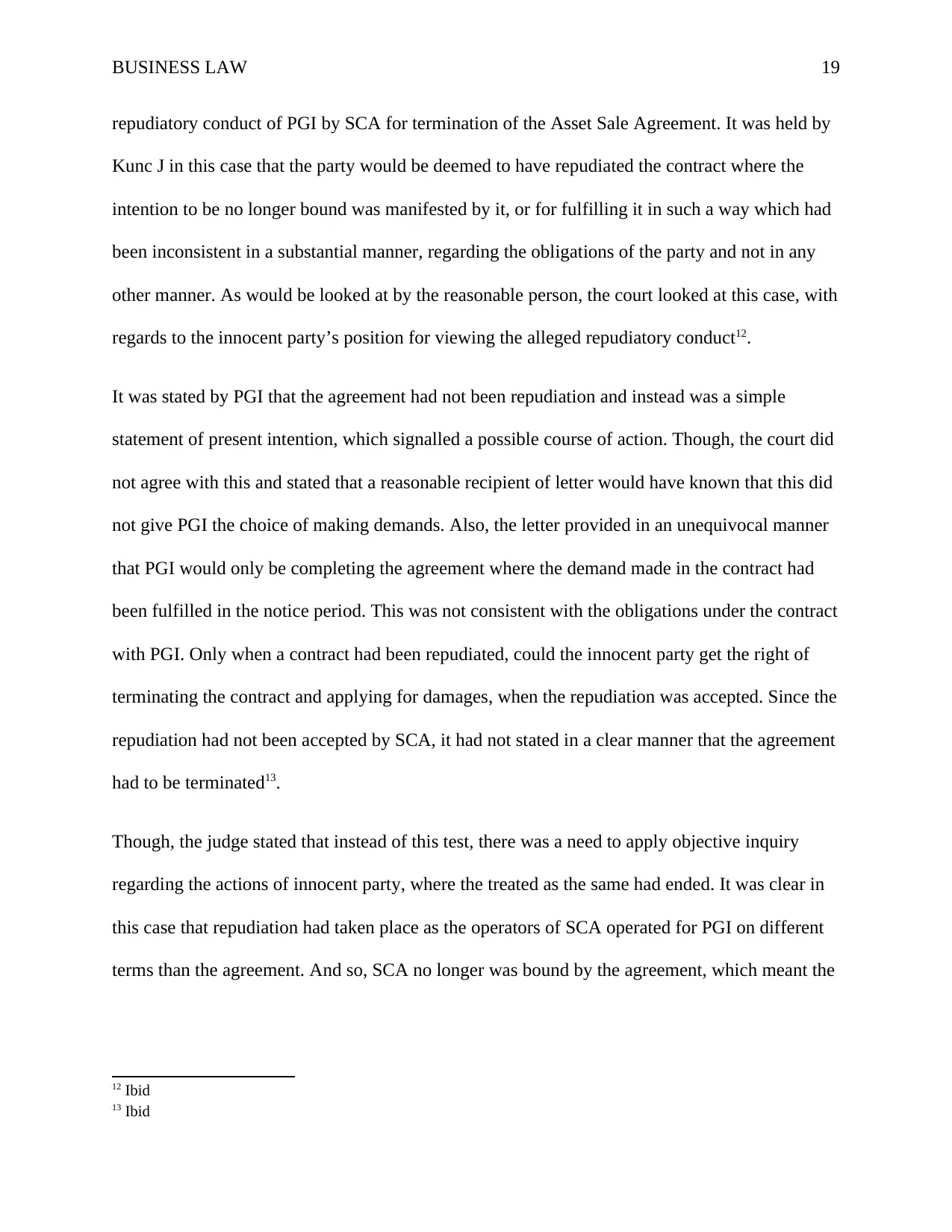
BUSINESS LAW 19
repudiatory conduct of PGI by SCA for termination of the Asset Sale Agreement. It was held by
Kunc J in this case that the party would be deemed to have repudiated the contract where the
intention to be no longer bound was manifested by it, or for fulfilling it in such a way which had
been inconsistent in a substantial manner, regarding the obligations of the party and not in any
other manner. As would be looked at by the reasonable person, the court looked at this case, with
regards to the innocent party’s position for viewing the alleged repudiatory conduct12.
It was stated by PGI that the agreement had not been repudiation and instead was a simple
statement of present intention, which signalled a possible course of action. Though, the court did
not agree with this and stated that a reasonable recipient of letter would have known that this did
not give PGI the choice of making demands. Also, the letter provided in an unequivocal manner
that PGI would only be completing the agreement where the demand made in the contract had
been fulfilled in the notice period. This was not consistent with the obligations under the contract
with PGI. Only when a contract had been repudiated, could the innocent party get the right of
terminating the contract and applying for damages, when the repudiation was accepted. Since the
repudiation had not been accepted by SCA, it had not stated in a clear manner that the agreement
had to be terminated13.
Though, the judge stated that instead of this test, there was a need to apply objective inquiry
regarding the actions of innocent party, where the treated as the same had ended. It was clear in
this case that repudiation had taken place as the operators of SCA operated for PGI on different
terms than the agreement. And so, SCA no longer was bound by the agreement, which meant the
12 Ibid
13 Ibid
repudiatory conduct of PGI by SCA for termination of the Asset Sale Agreement. It was held by
Kunc J in this case that the party would be deemed to have repudiated the contract where the
intention to be no longer bound was manifested by it, or for fulfilling it in such a way which had
been inconsistent in a substantial manner, regarding the obligations of the party and not in any
other manner. As would be looked at by the reasonable person, the court looked at this case, with
regards to the innocent party’s position for viewing the alleged repudiatory conduct12.
It was stated by PGI that the agreement had not been repudiation and instead was a simple
statement of present intention, which signalled a possible course of action. Though, the court did
not agree with this and stated that a reasonable recipient of letter would have known that this did
not give PGI the choice of making demands. Also, the letter provided in an unequivocal manner
that PGI would only be completing the agreement where the demand made in the contract had
been fulfilled in the notice period. This was not consistent with the obligations under the contract
with PGI. Only when a contract had been repudiated, could the innocent party get the right of
terminating the contract and applying for damages, when the repudiation was accepted. Since the
repudiation had not been accepted by SCA, it had not stated in a clear manner that the agreement
had to be terminated13.
Though, the judge stated that instead of this test, there was a need to apply objective inquiry
regarding the actions of innocent party, where the treated as the same had ended. It was clear in
this case that repudiation had taken place as the operators of SCA operated for PGI on different
terms than the agreement. And so, SCA no longer was bound by the agreement, which meant the
12 Ibid
13 Ibid
Paraphrase This Document
Need a fresh take? Get an instant paraphrase of this document with our AI Paraphraser
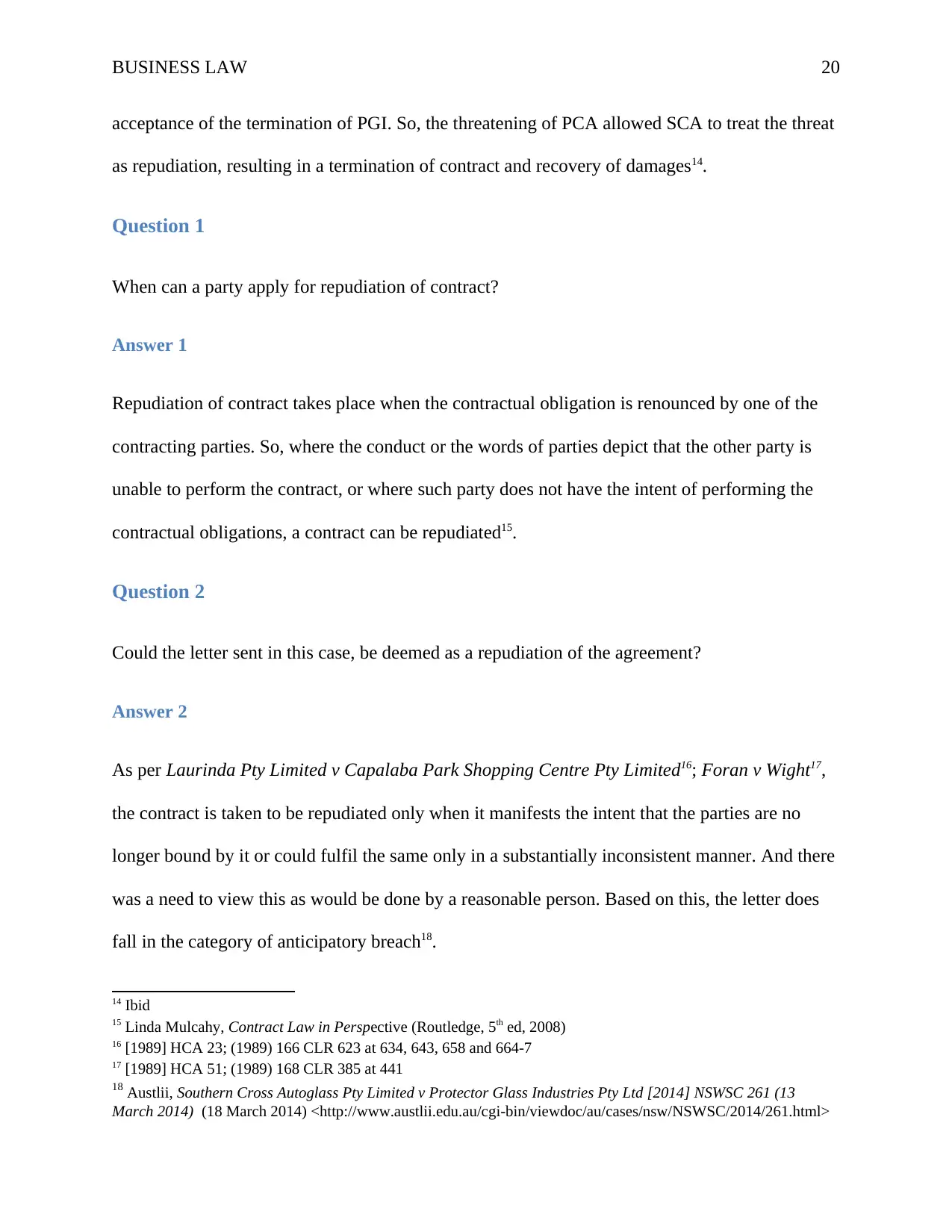
BUSINESS LAW 20
acceptance of the termination of PGI. So, the threatening of PCA allowed SCA to treat the threat
as repudiation, resulting in a termination of contract and recovery of damages14.
Question 1
When can a party apply for repudiation of contract?
Answer 1
Repudiation of contract takes place when the contractual obligation is renounced by one of the
contracting parties. So, where the conduct or the words of parties depict that the other party is
unable to perform the contract, or where such party does not have the intent of performing the
contractual obligations, a contract can be repudiated15.
Question 2
Could the letter sent in this case, be deemed as a repudiation of the agreement?
Answer 2
As per Laurinda Pty Limited v Capalaba Park Shopping Centre Pty Limited16; Foran v Wight17,
the contract is taken to be repudiated only when it manifests the intent that the parties are no
longer bound by it or could fulfil the same only in a substantially inconsistent manner. And there
was a need to view this as would be done by a reasonable person. Based on this, the letter does
fall in the category of anticipatory breach18.
14 Ibid
15 Linda Mulcahy, Contract Law in Perspective (Routledge, 5th ed, 2008)
16 [1989] HCA 23; (1989) 166 CLR 623 at 634, 643, 658 and 664-7
17 [1989] HCA 51; (1989) 168 CLR 385 at 441
18 Austlii, Southern Cross Autoglass Pty Limited v Protector Glass Industries Pty Ltd [2014] NSWSC 261 (13
March 2014) (18 March 2014) <http://www.austlii.edu.au/cgi-bin/viewdoc/au/cases/nsw/NSWSC/2014/261.html>
acceptance of the termination of PGI. So, the threatening of PCA allowed SCA to treat the threat
as repudiation, resulting in a termination of contract and recovery of damages14.
Question 1
When can a party apply for repudiation of contract?
Answer 1
Repudiation of contract takes place when the contractual obligation is renounced by one of the
contracting parties. So, where the conduct or the words of parties depict that the other party is
unable to perform the contract, or where such party does not have the intent of performing the
contractual obligations, a contract can be repudiated15.
Question 2
Could the letter sent in this case, be deemed as a repudiation of the agreement?
Answer 2
As per Laurinda Pty Limited v Capalaba Park Shopping Centre Pty Limited16; Foran v Wight17,
the contract is taken to be repudiated only when it manifests the intent that the parties are no
longer bound by it or could fulfil the same only in a substantially inconsistent manner. And there
was a need to view this as would be done by a reasonable person. Based on this, the letter does
fall in the category of anticipatory breach18.
14 Ibid
15 Linda Mulcahy, Contract Law in Perspective (Routledge, 5th ed, 2008)
16 [1989] HCA 23; (1989) 166 CLR 623 at 634, 643, 658 and 664-7
17 [1989] HCA 51; (1989) 168 CLR 385 at 441
18 Austlii, Southern Cross Autoglass Pty Limited v Protector Glass Industries Pty Ltd [2014] NSWSC 261 (13
March 2014) (18 March 2014) <http://www.austlii.edu.au/cgi-bin/viewdoc/au/cases/nsw/NSWSC/2014/261.html>

BUSINESS LAW 21
Question 3
Whether the proffering of termination deed, a repudiation of the agreement?
Answer 3
For this also, the conduct of PGI had to be considered, on which the plaintiff relied. The request
submitted by PGI to execute the termination deed, which showed that PGI was not bound by the
agreement would show that the termination deed was repudiation19.
Question 4
Was the repudiatory conduct accepted by the plaintiff to terminate the agreement?
Answer 4
As per Sargent v AFL Developments Pty Limited20, it was no mandatory to communicate the
acceptance of repudiation. The conduct and words communicate the acceptance only when they
are aligned with the election of termination of contract and on the basis of Wood Factory Pty
Limited v Kiritos Pty Limited21 it was enough to make election manifest to the relevant party. The
plaintiff here not only accepted the repudiation but also communicated the same to the
defendant.
Question 5
Whether SCA should be allowed to apply for damages?
19 Ibid
20 [1974] HCA 40; (1974) 131 CLR 634 at 646)
21 (1985) 2 NSWLR 105
Question 3
Whether the proffering of termination deed, a repudiation of the agreement?
Answer 3
For this also, the conduct of PGI had to be considered, on which the plaintiff relied. The request
submitted by PGI to execute the termination deed, which showed that PGI was not bound by the
agreement would show that the termination deed was repudiation19.
Question 4
Was the repudiatory conduct accepted by the plaintiff to terminate the agreement?
Answer 4
As per Sargent v AFL Developments Pty Limited20, it was no mandatory to communicate the
acceptance of repudiation. The conduct and words communicate the acceptance only when they
are aligned with the election of termination of contract and on the basis of Wood Factory Pty
Limited v Kiritos Pty Limited21 it was enough to make election manifest to the relevant party. The
plaintiff here not only accepted the repudiation but also communicated the same to the
defendant.
Question 5
Whether SCA should be allowed to apply for damages?
19 Ibid
20 [1974] HCA 40; (1974) 131 CLR 634 at 646)
21 (1985) 2 NSWLR 105
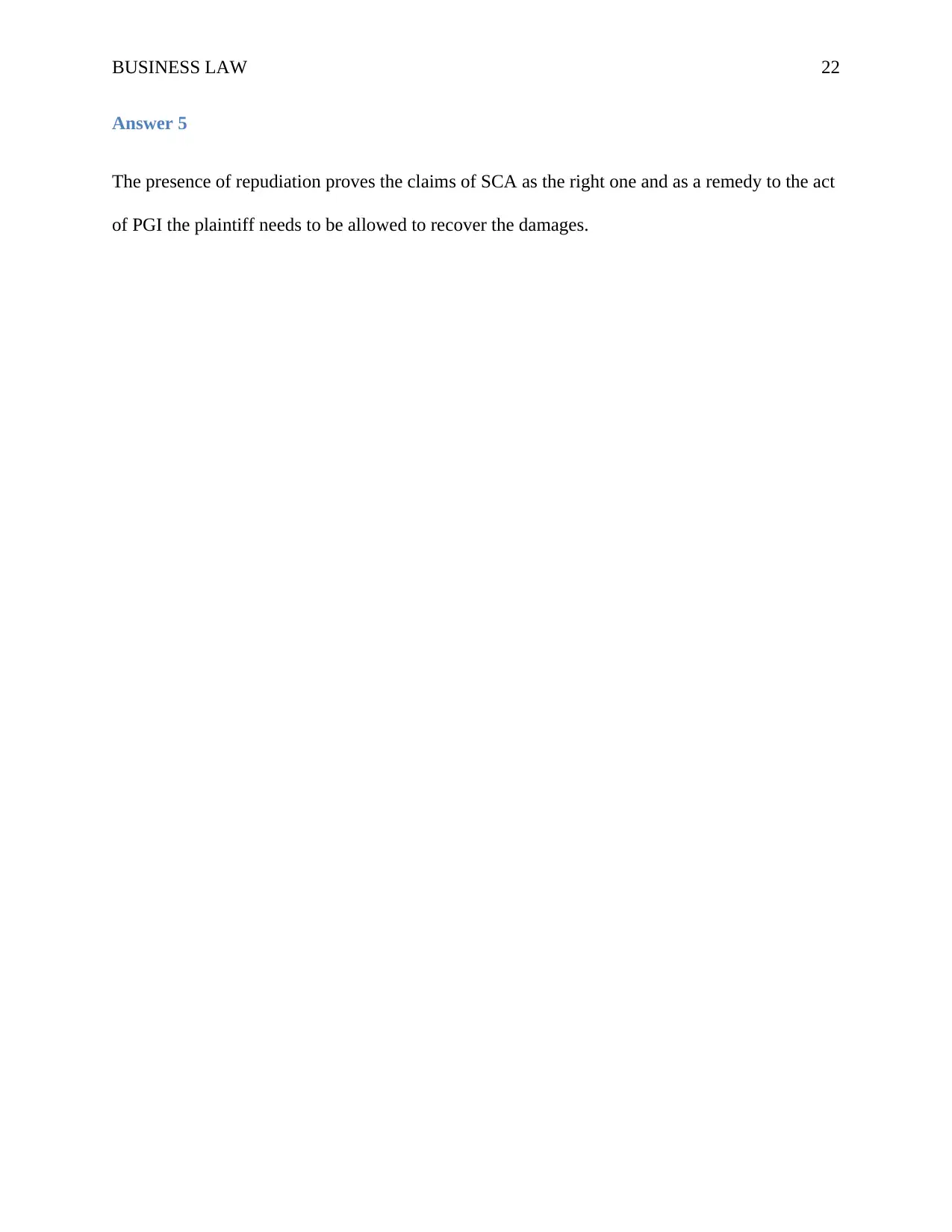
BUSINESS LAW 22
Answer 5
The presence of repudiation proves the claims of SCA as the right one and as a remedy to the act
of PGI the plaintiff needs to be allowed to recover the damages.
Answer 5
The presence of repudiation proves the claims of SCA as the right one and as a remedy to the act
of PGI the plaintiff needs to be allowed to recover the damages.
Secure Best Marks with AI Grader
Need help grading? Try our AI Grader for instant feedback on your assignments.
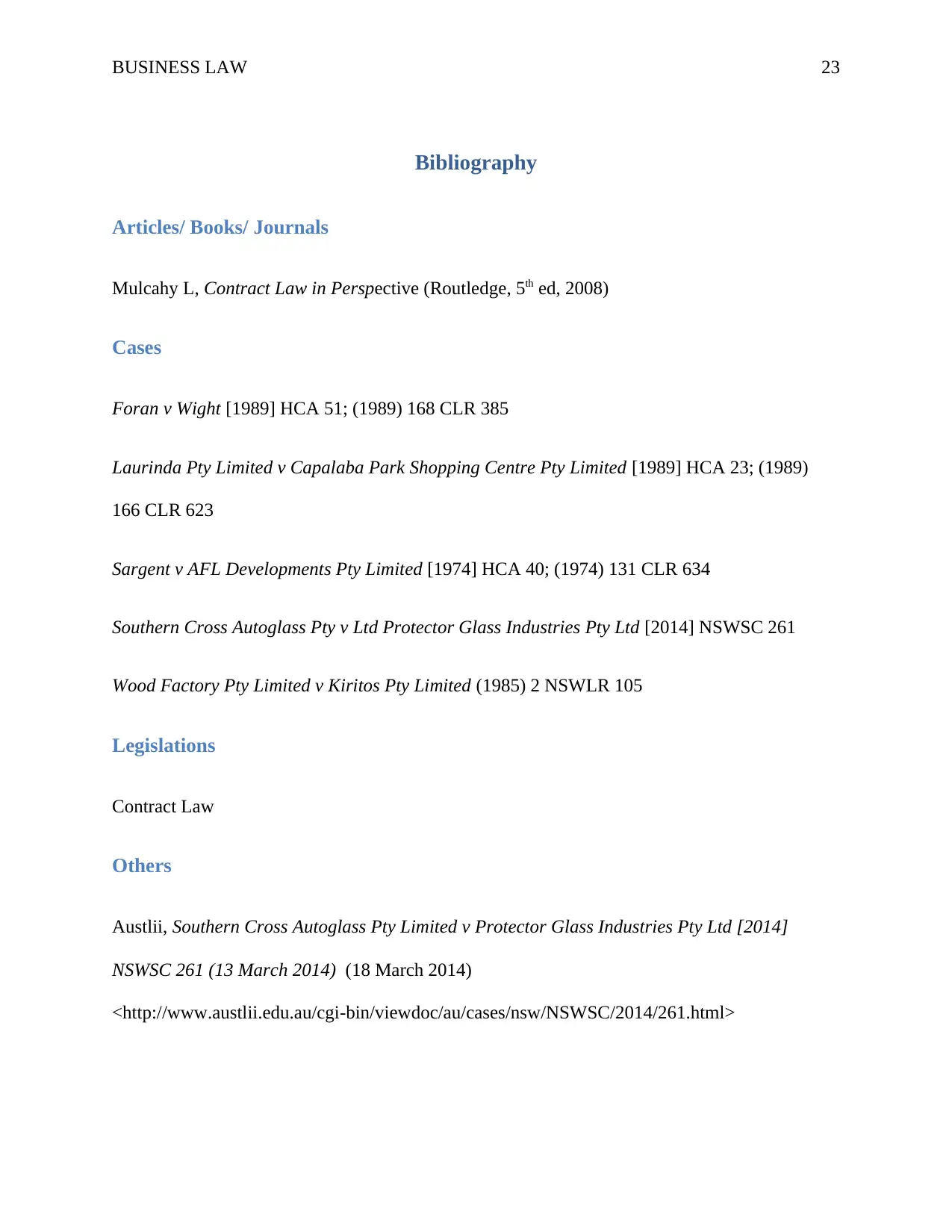
BUSINESS LAW 23
Bibliography
Articles/ Books/ Journals
Mulcahy L, Contract Law in Perspective (Routledge, 5th ed, 2008)
Cases
Foran v Wight [1989] HCA 51; (1989) 168 CLR 385
Laurinda Pty Limited v Capalaba Park Shopping Centre Pty Limited [1989] HCA 23; (1989)
166 CLR 623
Sargent v AFL Developments Pty Limited [1974] HCA 40; (1974) 131 CLR 634
Southern Cross Autoglass Pty v Ltd Protector Glass Industries Pty Ltd [2014] NSWSC 261
Wood Factory Pty Limited v Kiritos Pty Limited (1985) 2 NSWLR 105
Legislations
Contract Law
Others
Austlii, Southern Cross Autoglass Pty Limited v Protector Glass Industries Pty Ltd [2014]
NSWSC 261 (13 March 2014) (18 March 2014)
<http://www.austlii.edu.au/cgi-bin/viewdoc/au/cases/nsw/NSWSC/2014/261.html>
Bibliography
Articles/ Books/ Journals
Mulcahy L, Contract Law in Perspective (Routledge, 5th ed, 2008)
Cases
Foran v Wight [1989] HCA 51; (1989) 168 CLR 385
Laurinda Pty Limited v Capalaba Park Shopping Centre Pty Limited [1989] HCA 23; (1989)
166 CLR 623
Sargent v AFL Developments Pty Limited [1974] HCA 40; (1974) 131 CLR 634
Southern Cross Autoglass Pty v Ltd Protector Glass Industries Pty Ltd [2014] NSWSC 261
Wood Factory Pty Limited v Kiritos Pty Limited (1985) 2 NSWLR 105
Legislations
Contract Law
Others
Austlii, Southern Cross Autoglass Pty Limited v Protector Glass Industries Pty Ltd [2014]
NSWSC 261 (13 March 2014) (18 March 2014)
<http://www.austlii.edu.au/cgi-bin/viewdoc/au/cases/nsw/NSWSC/2014/261.html>
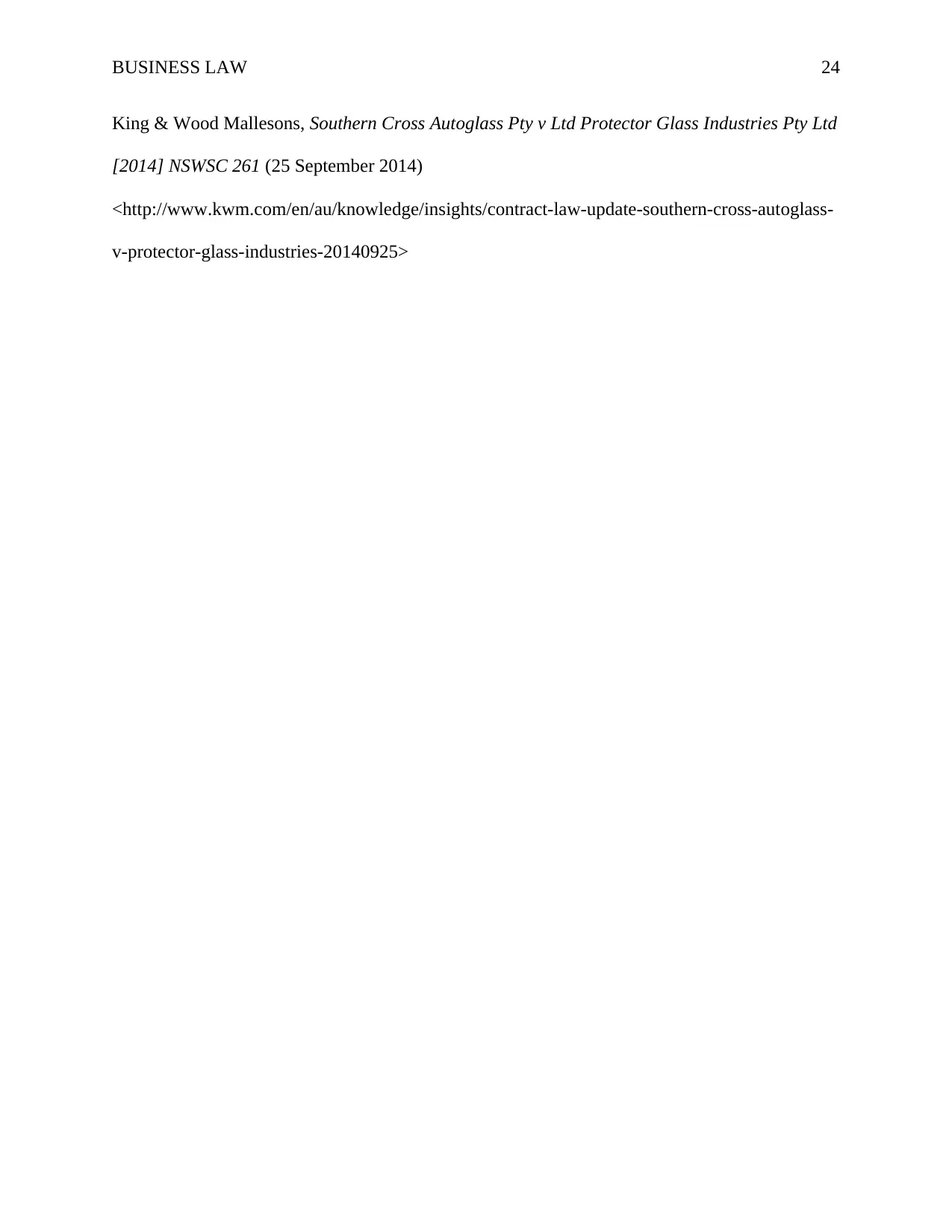
BUSINESS LAW 24
King & Wood Mallesons, Southern Cross Autoglass Pty v Ltd Protector Glass Industries Pty Ltd
[2014] NSWSC 261 (25 September 2014)
<http://www.kwm.com/en/au/knowledge/insights/contract-law-update-southern-cross-autoglass-
v-protector-glass-industries-20140925>
King & Wood Mallesons, Southern Cross Autoglass Pty v Ltd Protector Glass Industries Pty Ltd
[2014] NSWSC 261 (25 September 2014)
<http://www.kwm.com/en/au/knowledge/insights/contract-law-update-southern-cross-autoglass-
v-protector-glass-industries-20140925>

BUSINESS LAW 25
Case 3
Reveille Independent LLC v Anotech International (UK) Ltd 22
Background
In this case, the Court of Appeal considered the contract in which a stipulation was covered
regarding signature and yet the contract was deemed to be formed, without the signature being
done on the contract. In this case, the plaintiff was a cookware distributor and the defendant was
a television company of US. An agreement was started to be negotiated in 2011 where the
defendant was set to integrate and promote the cookware products of the plaintiff in three
episodes of the TV series and would also be getting a licence to the plaintiff for some of the US
intellectual property rights23.
A deal memo was sent in Feb 2011 by the defendant to the plaintiff stating that the same would
not be binding till the time the same was signed. The plaintiff returned this memo later that
month and this covered some handwritten amendments and additions. This memo was deemed to
be replaced through a detailed long form agreement. However, in July 2012 the negotiations
broke and the defendant treated the contract as repudiated. The main issue to be decided in this
case whether the parties had signified through their conduct that they accepted the amendments,
which would be enough to waive the signature requirement off and resulting in a binding
agreement.
22 [2016] EWCA Civ 443
23 St John’s Chambers, Contract Law Case Law Update (June 2016)
<http://www.stjohnschambers.co.uk/dashboard/wp-content/uploads/Contract-law-case-law-update.pdf>
Case 3
Reveille Independent LLC v Anotech International (UK) Ltd 22
Background
In this case, the Court of Appeal considered the contract in which a stipulation was covered
regarding signature and yet the contract was deemed to be formed, without the signature being
done on the contract. In this case, the plaintiff was a cookware distributor and the defendant was
a television company of US. An agreement was started to be negotiated in 2011 where the
defendant was set to integrate and promote the cookware products of the plaintiff in three
episodes of the TV series and would also be getting a licence to the plaintiff for some of the US
intellectual property rights23.
A deal memo was sent in Feb 2011 by the defendant to the plaintiff stating that the same would
not be binding till the time the same was signed. The plaintiff returned this memo later that
month and this covered some handwritten amendments and additions. This memo was deemed to
be replaced through a detailed long form agreement. However, in July 2012 the negotiations
broke and the defendant treated the contract as repudiated. The main issue to be decided in this
case whether the parties had signified through their conduct that they accepted the amendments,
which would be enough to waive the signature requirement off and resulting in a binding
agreement.
22 [2016] EWCA Civ 443
23 St John’s Chambers, Contract Law Case Law Update (June 2016)
<http://www.stjohnschambers.co.uk/dashboard/wp-content/uploads/Contract-law-case-law-update.pdf>
Paraphrase This Document
Need a fresh take? Get an instant paraphrase of this document with our AI Paraphraser
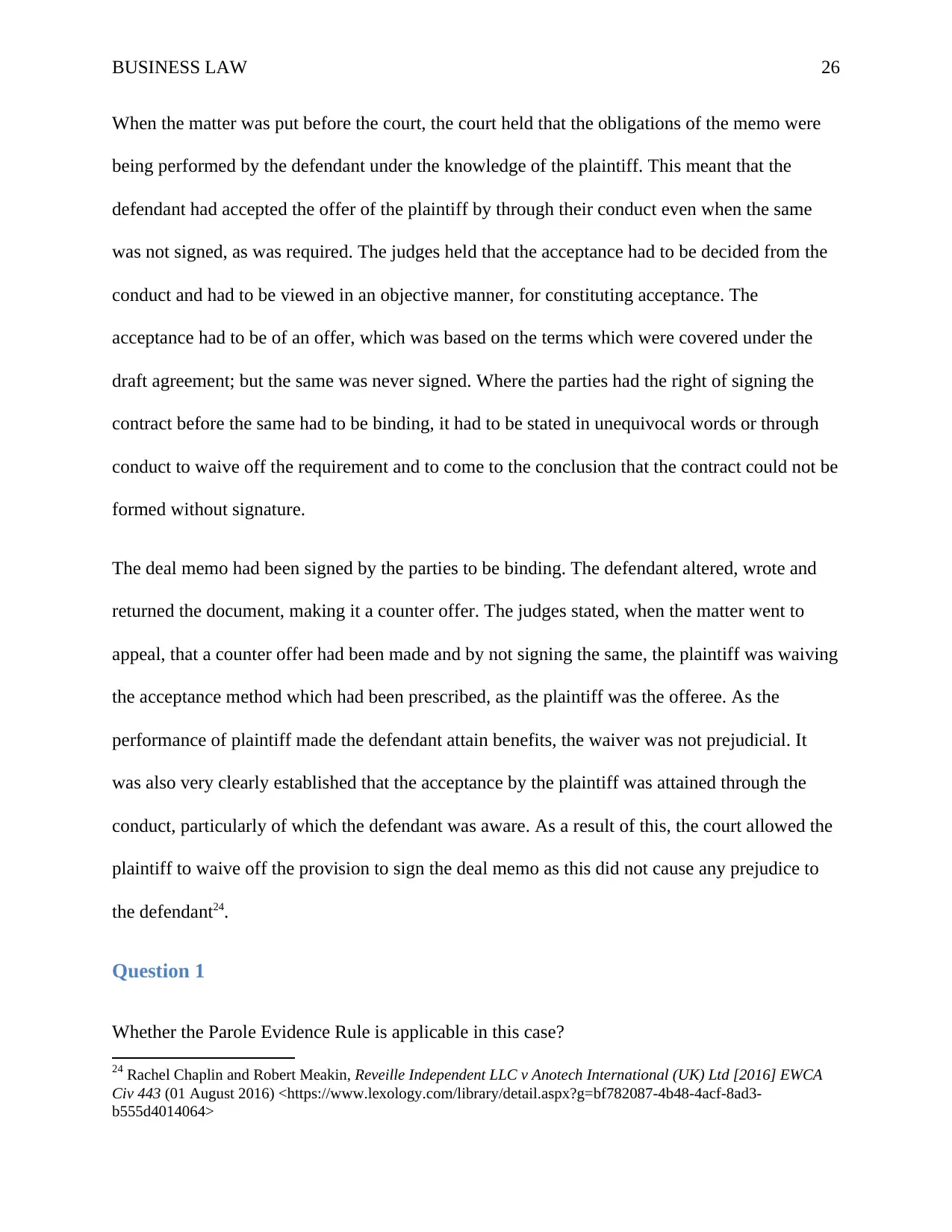
BUSINESS LAW 26
When the matter was put before the court, the court held that the obligations of the memo were
being performed by the defendant under the knowledge of the plaintiff. This meant that the
defendant had accepted the offer of the plaintiff by through their conduct even when the same
was not signed, as was required. The judges held that the acceptance had to be decided from the
conduct and had to be viewed in an objective manner, for constituting acceptance. The
acceptance had to be of an offer, which was based on the terms which were covered under the
draft agreement; but the same was never signed. Where the parties had the right of signing the
contract before the same had to be binding, it had to be stated in unequivocal words or through
conduct to waive off the requirement and to come to the conclusion that the contract could not be
formed without signature.
The deal memo had been signed by the parties to be binding. The defendant altered, wrote and
returned the document, making it a counter offer. The judges stated, when the matter went to
appeal, that a counter offer had been made and by not signing the same, the plaintiff was waiving
the acceptance method which had been prescribed, as the plaintiff was the offeree. As the
performance of plaintiff made the defendant attain benefits, the waiver was not prejudicial. It
was also very clearly established that the acceptance by the plaintiff was attained through the
conduct, particularly of which the defendant was aware. As a result of this, the court allowed the
plaintiff to waive off the provision to sign the deal memo as this did not cause any prejudice to
the defendant24.
Question 1
Whether the Parole Evidence Rule is applicable in this case?
24 Rachel Chaplin and Robert Meakin, Reveille Independent LLC v Anotech International (UK) Ltd [2016] EWCA
Civ 443 (01 August 2016) <https://www.lexology.com/library/detail.aspx?g=bf782087-4b48-4acf-8ad3-
b555d4014064>
When the matter was put before the court, the court held that the obligations of the memo were
being performed by the defendant under the knowledge of the plaintiff. This meant that the
defendant had accepted the offer of the plaintiff by through their conduct even when the same
was not signed, as was required. The judges held that the acceptance had to be decided from the
conduct and had to be viewed in an objective manner, for constituting acceptance. The
acceptance had to be of an offer, which was based on the terms which were covered under the
draft agreement; but the same was never signed. Where the parties had the right of signing the
contract before the same had to be binding, it had to be stated in unequivocal words or through
conduct to waive off the requirement and to come to the conclusion that the contract could not be
formed without signature.
The deal memo had been signed by the parties to be binding. The defendant altered, wrote and
returned the document, making it a counter offer. The judges stated, when the matter went to
appeal, that a counter offer had been made and by not signing the same, the plaintiff was waiving
the acceptance method which had been prescribed, as the plaintiff was the offeree. As the
performance of plaintiff made the defendant attain benefits, the waiver was not prejudicial. It
was also very clearly established that the acceptance by the plaintiff was attained through the
conduct, particularly of which the defendant was aware. As a result of this, the court allowed the
plaintiff to waive off the provision to sign the deal memo as this did not cause any prejudice to
the defendant24.
Question 1
Whether the Parole Evidence Rule is applicable in this case?
24 Rachel Chaplin and Robert Meakin, Reveille Independent LLC v Anotech International (UK) Ltd [2016] EWCA
Civ 443 (01 August 2016) <https://www.lexology.com/library/detail.aspx?g=bf782087-4b48-4acf-8ad3-
b555d4014064>

BUSINESS LAW 27
Answer 1
Parole Evidence Rule provides that the written terms of the contract are to be given supremacy,
irrespective of the oral terms which led to the formation of the contract25. In this case, the written
terms dictated that the contract had to be signed to be valid. And the parole evidence rule dictates
that irrespective of what was discussed before, something which was put down in writing had to
be followed. However, here no contract had been formed, as the same was the issue of dispute.
So, the parole evidence rule cannot be applied to hold the plaintiff liable for not signing the
contract.
Question 2
Whether a counter offer was made in this case?
Answer 2
An essential element of contract formation is that when a term is offered to another party, such
another party has to accept the same. This has to be done in the manner which is provided by the
offering party26. Where the terms of offer are altered or changed when the acceptance is being
granted, it is deemed as a counter offer. And when such happens, as per Hyde v. Wrench27, the
original offer expires.
In this case, the handwritten amendments were counter offer as some additions were made and
this would make it a counter offer.
25 Jeffrey A. Helewitz, Basic Contract Law for Paralegals (Aspen Publishers Online, 5th ed, 2007)
26 Linda Mulcahy, Contract Law in Perspective (Routledge, 5th ed, 2008)
27 (1840) 3 Beav 334
Answer 1
Parole Evidence Rule provides that the written terms of the contract are to be given supremacy,
irrespective of the oral terms which led to the formation of the contract25. In this case, the written
terms dictated that the contract had to be signed to be valid. And the parole evidence rule dictates
that irrespective of what was discussed before, something which was put down in writing had to
be followed. However, here no contract had been formed, as the same was the issue of dispute.
So, the parole evidence rule cannot be applied to hold the plaintiff liable for not signing the
contract.
Question 2
Whether a counter offer was made in this case?
Answer 2
An essential element of contract formation is that when a term is offered to another party, such
another party has to accept the same. This has to be done in the manner which is provided by the
offering party26. Where the terms of offer are altered or changed when the acceptance is being
granted, it is deemed as a counter offer. And when such happens, as per Hyde v. Wrench27, the
original offer expires.
In this case, the handwritten amendments were counter offer as some additions were made and
this would make it a counter offer.
25 Jeffrey A. Helewitz, Basic Contract Law for Paralegals (Aspen Publishers Online, 5th ed, 2007)
26 Linda Mulcahy, Contract Law in Perspective (Routledge, 5th ed, 2008)
27 (1840) 3 Beav 334
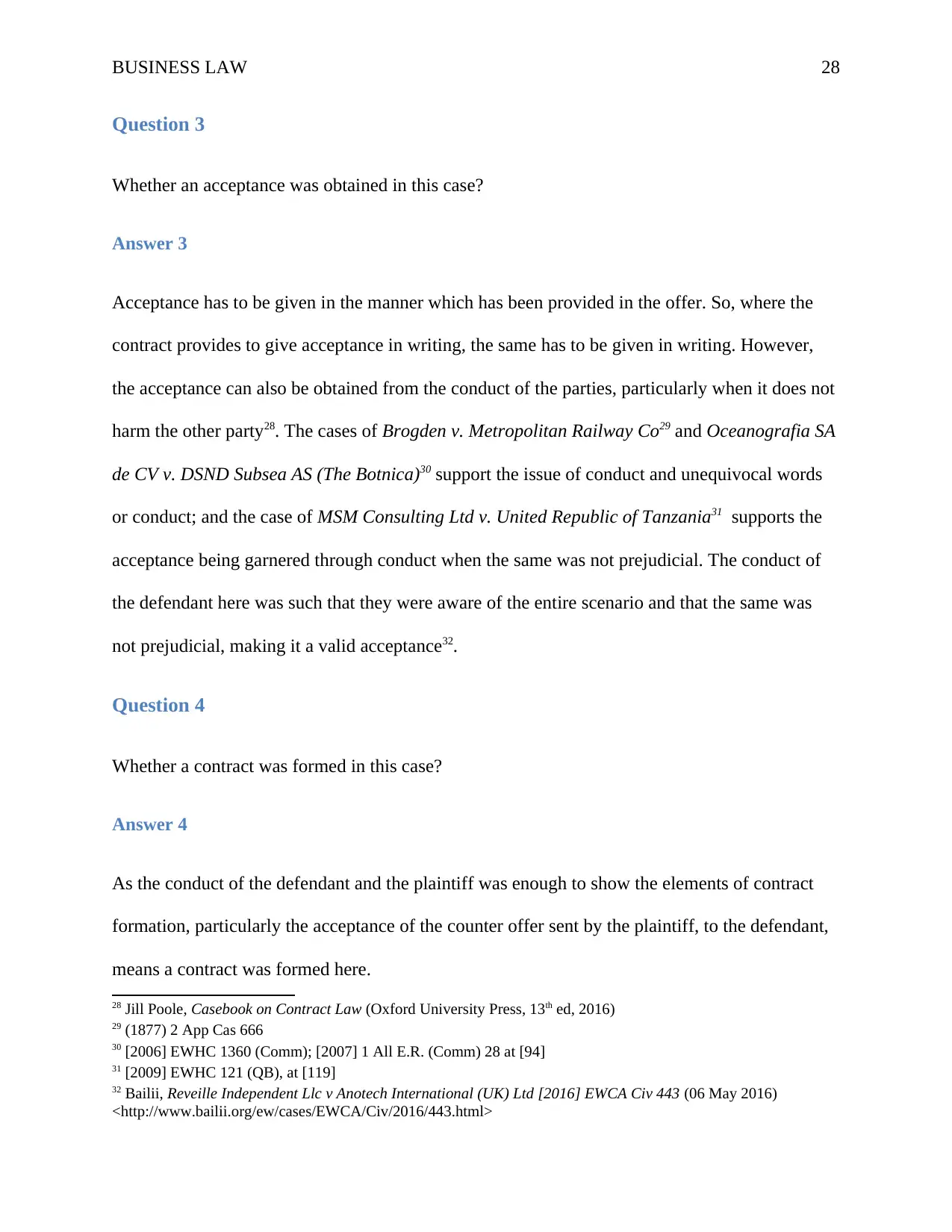
BUSINESS LAW 28
Question 3
Whether an acceptance was obtained in this case?
Answer 3
Acceptance has to be given in the manner which has been provided in the offer. So, where the
contract provides to give acceptance in writing, the same has to be given in writing. However,
the acceptance can also be obtained from the conduct of the parties, particularly when it does not
harm the other party28. The cases of Brogden v. Metropolitan Railway Co29 and Oceanografia SA
de CV v. DSND Subsea AS (The Botnica)30 support the issue of conduct and unequivocal words
or conduct; and the case of MSM Consulting Ltd v. United Republic of Tanzania31 supports the
acceptance being garnered through conduct when the same was not prejudicial. The conduct of
the defendant here was such that they were aware of the entire scenario and that the same was
not prejudicial, making it a valid acceptance32.
Question 4
Whether a contract was formed in this case?
Answer 4
As the conduct of the defendant and the plaintiff was enough to show the elements of contract
formation, particularly the acceptance of the counter offer sent by the plaintiff, to the defendant,
means a contract was formed here.
28 Jill Poole, Casebook on Contract Law (Oxford University Press, 13th ed, 2016)
29 (1877) 2 App Cas 666
30 [2006] EWHC 1360 (Comm); [2007] 1 All E.R. (Comm) 28 at [94]
31 [2009] EWHC 121 (QB), at [119]
32 Bailii, Reveille Independent Llc v Anotech International (UK) Ltd [2016] EWCA Civ 443 (06 May 2016)
<http://www.bailii.org/ew/cases/EWCA/Civ/2016/443.html>
Question 3
Whether an acceptance was obtained in this case?
Answer 3
Acceptance has to be given in the manner which has been provided in the offer. So, where the
contract provides to give acceptance in writing, the same has to be given in writing. However,
the acceptance can also be obtained from the conduct of the parties, particularly when it does not
harm the other party28. The cases of Brogden v. Metropolitan Railway Co29 and Oceanografia SA
de CV v. DSND Subsea AS (The Botnica)30 support the issue of conduct and unequivocal words
or conduct; and the case of MSM Consulting Ltd v. United Republic of Tanzania31 supports the
acceptance being garnered through conduct when the same was not prejudicial. The conduct of
the defendant here was such that they were aware of the entire scenario and that the same was
not prejudicial, making it a valid acceptance32.
Question 4
Whether a contract was formed in this case?
Answer 4
As the conduct of the defendant and the plaintiff was enough to show the elements of contract
formation, particularly the acceptance of the counter offer sent by the plaintiff, to the defendant,
means a contract was formed here.
28 Jill Poole, Casebook on Contract Law (Oxford University Press, 13th ed, 2016)
29 (1877) 2 App Cas 666
30 [2006] EWHC 1360 (Comm); [2007] 1 All E.R. (Comm) 28 at [94]
31 [2009] EWHC 121 (QB), at [119]
32 Bailii, Reveille Independent Llc v Anotech International (UK) Ltd [2016] EWCA Civ 443 (06 May 2016)
<http://www.bailii.org/ew/cases/EWCA/Civ/2016/443.html>
Secure Best Marks with AI Grader
Need help grading? Try our AI Grader for instant feedback on your assignments.

BUSINESS LAW 29
Question 5
Can the defendant cite invalid acceptance here?
Answer 5
The defendant can opt for supremacy of signature over conduct, based on the trial judge verdict
where the contract was deemed not to be formed, though the same was reversed in the appeal
made, where the contract was deemed to be properly formed.
Question 5
Can the defendant cite invalid acceptance here?
Answer 5
The defendant can opt for supremacy of signature over conduct, based on the trial judge verdict
where the contract was deemed not to be formed, though the same was reversed in the appeal
made, where the contract was deemed to be properly formed.
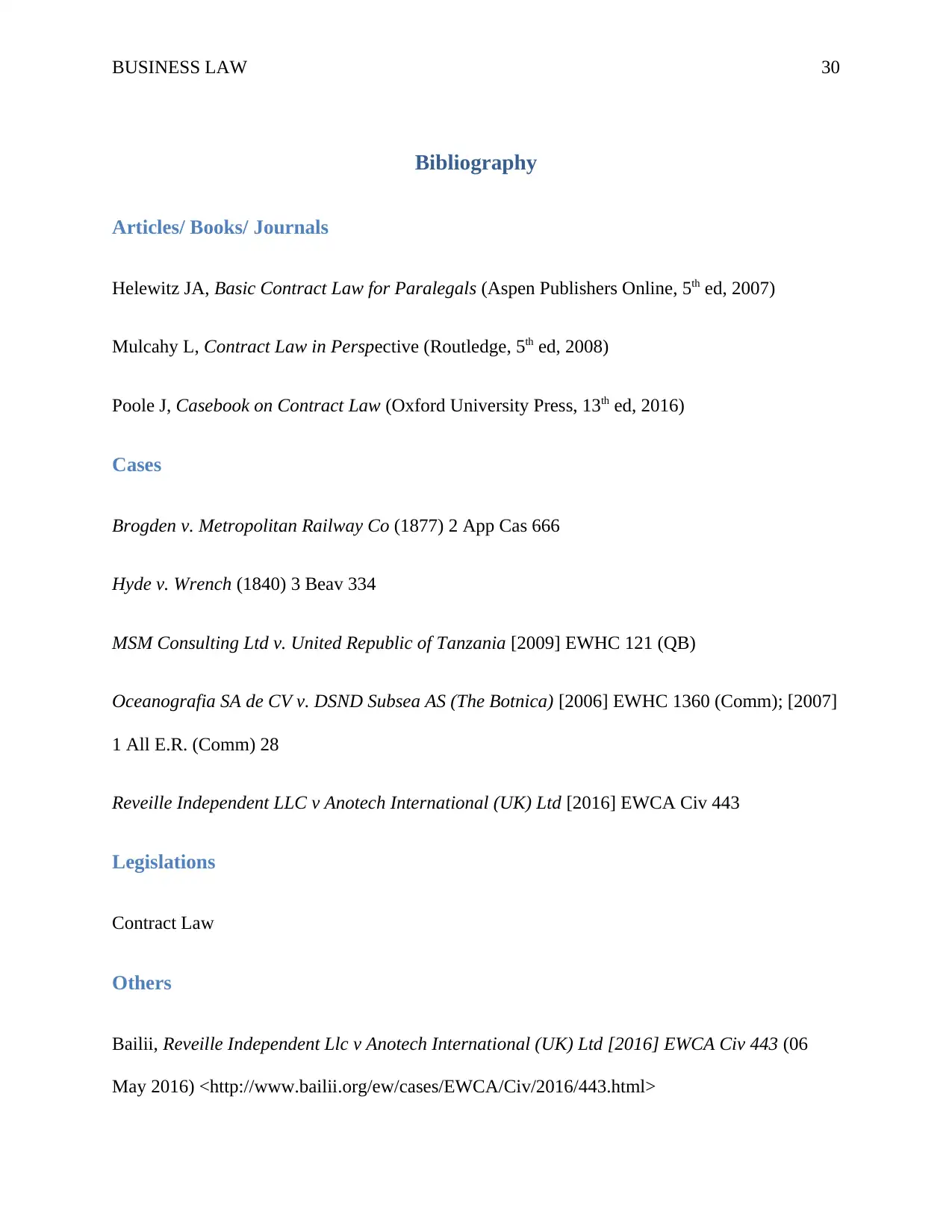
BUSINESS LAW 30
Bibliography
Articles/ Books/ Journals
Helewitz JA, Basic Contract Law for Paralegals (Aspen Publishers Online, 5th ed, 2007)
Mulcahy L, Contract Law in Perspective (Routledge, 5th ed, 2008)
Poole J, Casebook on Contract Law (Oxford University Press, 13th ed, 2016)
Cases
Brogden v. Metropolitan Railway Co (1877) 2 App Cas 666
Hyde v. Wrench (1840) 3 Beav 334
MSM Consulting Ltd v. United Republic of Tanzania [2009] EWHC 121 (QB)
Oceanografia SA de CV v. DSND Subsea AS (The Botnica) [2006] EWHC 1360 (Comm); [2007]
1 All E.R. (Comm) 28
Reveille Independent LLC v Anotech International (UK) Ltd [2016] EWCA Civ 443
Legislations
Contract Law
Others
Bailii, Reveille Independent Llc v Anotech International (UK) Ltd [2016] EWCA Civ 443 (06
May 2016) <http://www.bailii.org/ew/cases/EWCA/Civ/2016/443.html>
Bibliography
Articles/ Books/ Journals
Helewitz JA, Basic Contract Law for Paralegals (Aspen Publishers Online, 5th ed, 2007)
Mulcahy L, Contract Law in Perspective (Routledge, 5th ed, 2008)
Poole J, Casebook on Contract Law (Oxford University Press, 13th ed, 2016)
Cases
Brogden v. Metropolitan Railway Co (1877) 2 App Cas 666
Hyde v. Wrench (1840) 3 Beav 334
MSM Consulting Ltd v. United Republic of Tanzania [2009] EWHC 121 (QB)
Oceanografia SA de CV v. DSND Subsea AS (The Botnica) [2006] EWHC 1360 (Comm); [2007]
1 All E.R. (Comm) 28
Reveille Independent LLC v Anotech International (UK) Ltd [2016] EWCA Civ 443
Legislations
Contract Law
Others
Bailii, Reveille Independent Llc v Anotech International (UK) Ltd [2016] EWCA Civ 443 (06
May 2016) <http://www.bailii.org/ew/cases/EWCA/Civ/2016/443.html>
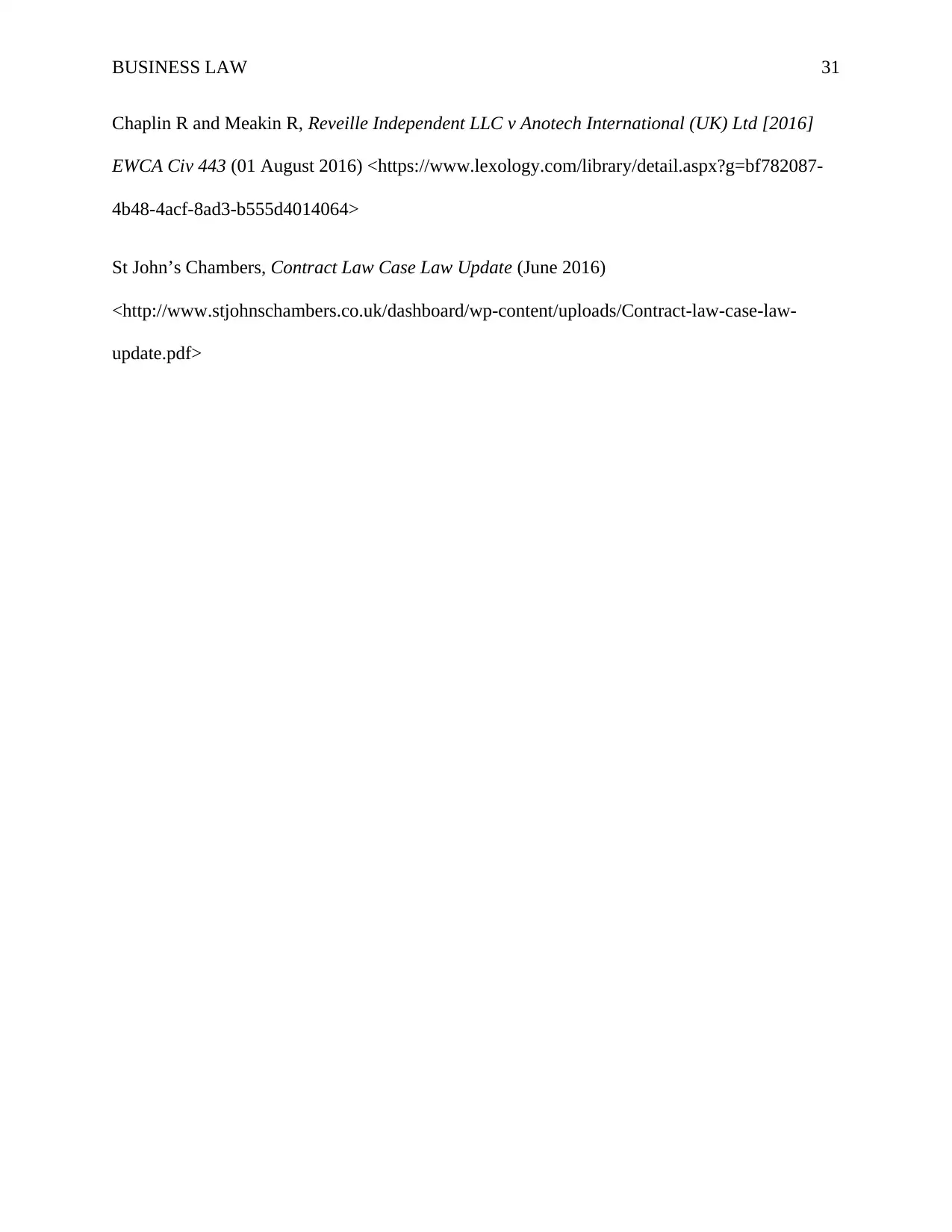
BUSINESS LAW 31
Chaplin R and Meakin R, Reveille Independent LLC v Anotech International (UK) Ltd [2016]
EWCA Civ 443 (01 August 2016) <https://www.lexology.com/library/detail.aspx?g=bf782087-
4b48-4acf-8ad3-b555d4014064>
St John’s Chambers, Contract Law Case Law Update (June 2016)
<http://www.stjohnschambers.co.uk/dashboard/wp-content/uploads/Contract-law-case-law-
update.pdf>
Chaplin R and Meakin R, Reveille Independent LLC v Anotech International (UK) Ltd [2016]
EWCA Civ 443 (01 August 2016) <https://www.lexology.com/library/detail.aspx?g=bf782087-
4b48-4acf-8ad3-b555d4014064>
St John’s Chambers, Contract Law Case Law Update (June 2016)
<http://www.stjohnschambers.co.uk/dashboard/wp-content/uploads/Contract-law-case-law-
update.pdf>
Paraphrase This Document
Need a fresh take? Get an instant paraphrase of this document with our AI Paraphraser
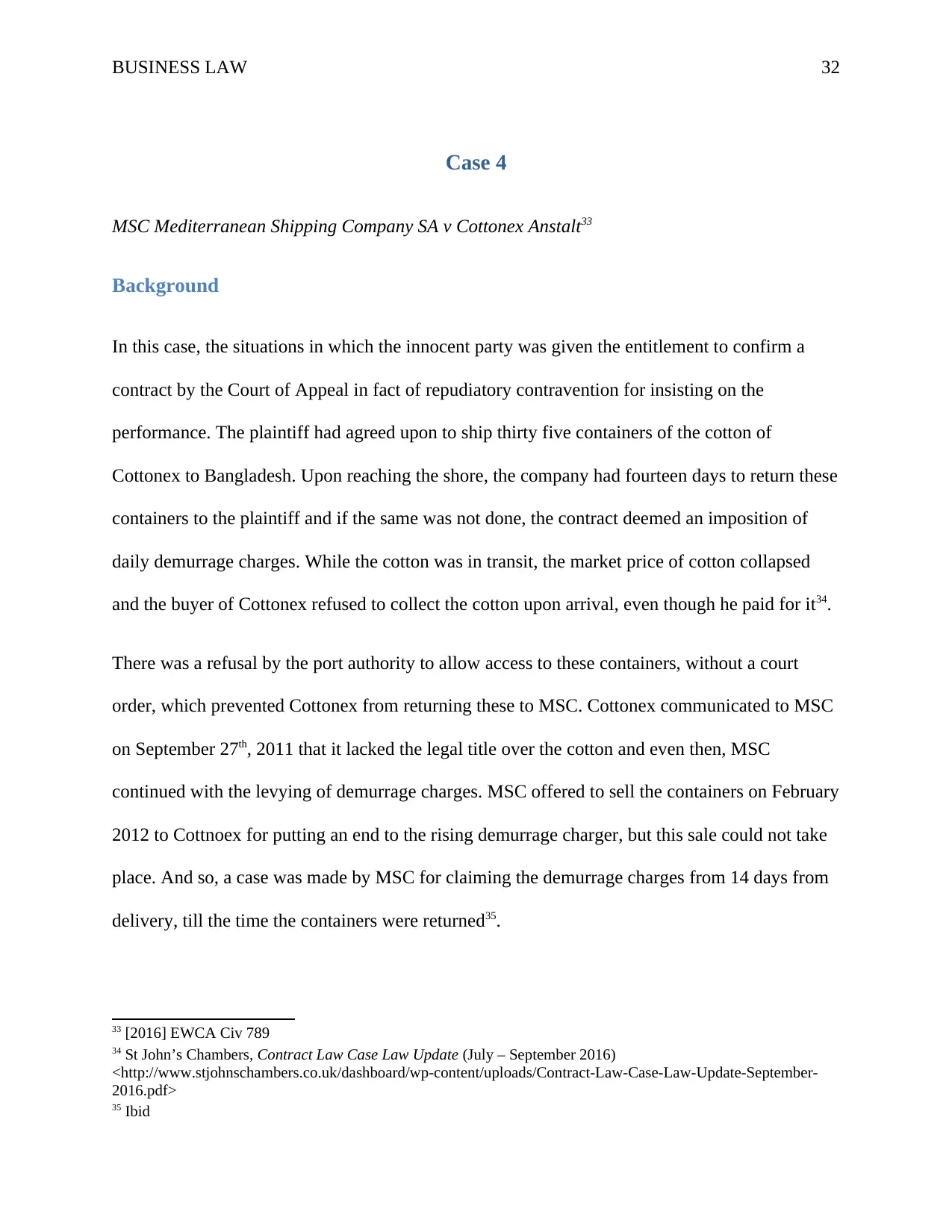
BUSINESS LAW 32
Case 4
MSC Mediterranean Shipping Company SA v Cottonex Anstalt33
Background
In this case, the situations in which the innocent party was given the entitlement to confirm a
contract by the Court of Appeal in fact of repudiatory contravention for insisting on the
performance. The plaintiff had agreed upon to ship thirty five containers of the cotton of
Cottonex to Bangladesh. Upon reaching the shore, the company had fourteen days to return these
containers to the plaintiff and if the same was not done, the contract deemed an imposition of
daily demurrage charges. While the cotton was in transit, the market price of cotton collapsed
and the buyer of Cottonex refused to collect the cotton upon arrival, even though he paid for it34.
There was a refusal by the port authority to allow access to these containers, without a court
order, which prevented Cottonex from returning these to MSC. Cottonex communicated to MSC
on September 27th, 2011 that it lacked the legal title over the cotton and even then, MSC
continued with the levying of demurrage charges. MSC offered to sell the containers on February
2012 to Cottnoex for putting an end to the rising demurrage charger, but this sale could not take
place. And so, a case was made by MSC for claiming the demurrage charges from 14 days from
delivery, till the time the containers were returned35.
33 [2016] EWCA Civ 789
34 St John’s Chambers, Contract Law Case Law Update (July – September 2016)
<http://www.stjohnschambers.co.uk/dashboard/wp-content/uploads/Contract-Law-Case-Law-Update-September-
2016.pdf>
35 Ibid
Case 4
MSC Mediterranean Shipping Company SA v Cottonex Anstalt33
Background
In this case, the situations in which the innocent party was given the entitlement to confirm a
contract by the Court of Appeal in fact of repudiatory contravention for insisting on the
performance. The plaintiff had agreed upon to ship thirty five containers of the cotton of
Cottonex to Bangladesh. Upon reaching the shore, the company had fourteen days to return these
containers to the plaintiff and if the same was not done, the contract deemed an imposition of
daily demurrage charges. While the cotton was in transit, the market price of cotton collapsed
and the buyer of Cottonex refused to collect the cotton upon arrival, even though he paid for it34.
There was a refusal by the port authority to allow access to these containers, without a court
order, which prevented Cottonex from returning these to MSC. Cottonex communicated to MSC
on September 27th, 2011 that it lacked the legal title over the cotton and even then, MSC
continued with the levying of demurrage charges. MSC offered to sell the containers on February
2012 to Cottnoex for putting an end to the rising demurrage charger, but this sale could not take
place. And so, a case was made by MSC for claiming the demurrage charges from 14 days from
delivery, till the time the containers were returned35.
33 [2016] EWCA Civ 789
34 St John’s Chambers, Contract Law Case Law Update (July – September 2016)
<http://www.stjohnschambers.co.uk/dashboard/wp-content/uploads/Contract-Law-Case-Law-Update-September-
2016.pdf>
35 Ibid
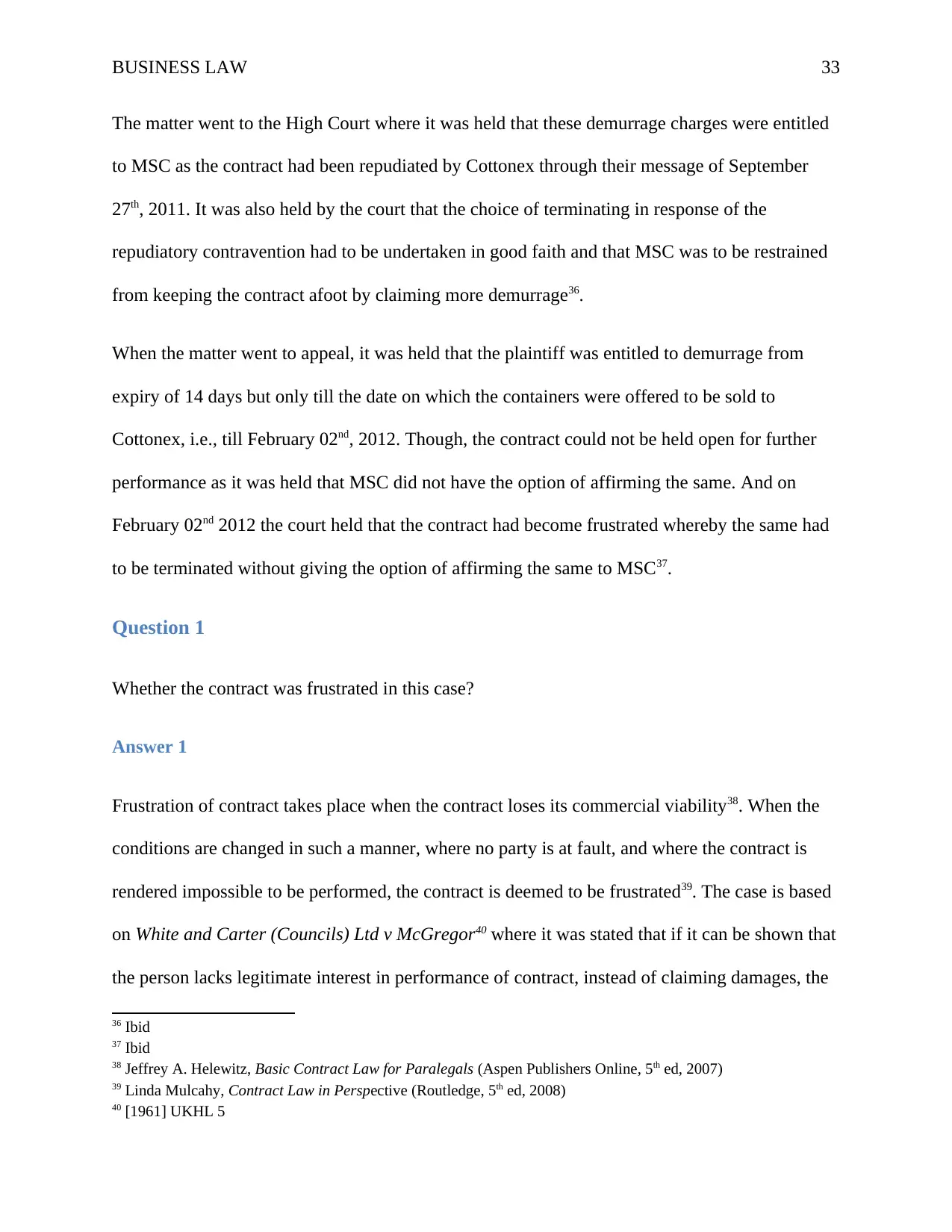
BUSINESS LAW 33
The matter went to the High Court where it was held that these demurrage charges were entitled
to MSC as the contract had been repudiated by Cottonex through their message of September
27th, 2011. It was also held by the court that the choice of terminating in response of the
repudiatory contravention had to be undertaken in good faith and that MSC was to be restrained
from keeping the contract afoot by claiming more demurrage36.
When the matter went to appeal, it was held that the plaintiff was entitled to demurrage from
expiry of 14 days but only till the date on which the containers were offered to be sold to
Cottonex, i.e., till February 02nd, 2012. Though, the contract could not be held open for further
performance as it was held that MSC did not have the option of affirming the same. And on
February 02nd 2012 the court held that the contract had become frustrated whereby the same had
to be terminated without giving the option of affirming the same to MSC37.
Question 1
Whether the contract was frustrated in this case?
Answer 1
Frustration of contract takes place when the contract loses its commercial viability38. When the
conditions are changed in such a manner, where no party is at fault, and where the contract is
rendered impossible to be performed, the contract is deemed to be frustrated39. The case is based
on White and Carter (Councils) Ltd v McGregor40 where it was stated that if it can be shown that
the person lacks legitimate interest in performance of contract, instead of claiming damages, the
36 Ibid
37 Ibid
38 Jeffrey A. Helewitz, Basic Contract Law for Paralegals (Aspen Publishers Online, 5th ed, 2007)
39 Linda Mulcahy, Contract Law in Perspective (Routledge, 5th ed, 2008)
40 [1961] UKHL 5
The matter went to the High Court where it was held that these demurrage charges were entitled
to MSC as the contract had been repudiated by Cottonex through their message of September
27th, 2011. It was also held by the court that the choice of terminating in response of the
repudiatory contravention had to be undertaken in good faith and that MSC was to be restrained
from keeping the contract afoot by claiming more demurrage36.
When the matter went to appeal, it was held that the plaintiff was entitled to demurrage from
expiry of 14 days but only till the date on which the containers were offered to be sold to
Cottonex, i.e., till February 02nd, 2012. Though, the contract could not be held open for further
performance as it was held that MSC did not have the option of affirming the same. And on
February 02nd 2012 the court held that the contract had become frustrated whereby the same had
to be terminated without giving the option of affirming the same to MSC37.
Question 1
Whether the contract was frustrated in this case?
Answer 1
Frustration of contract takes place when the contract loses its commercial viability38. When the
conditions are changed in such a manner, where no party is at fault, and where the contract is
rendered impossible to be performed, the contract is deemed to be frustrated39. The case is based
on White and Carter (Councils) Ltd v McGregor40 where it was stated that if it can be shown that
the person lacks legitimate interest in performance of contract, instead of claiming damages, the
36 Ibid
37 Ibid
38 Jeffrey A. Helewitz, Basic Contract Law for Paralegals (Aspen Publishers Online, 5th ed, 2007)
39 Linda Mulcahy, Contract Law in Perspective (Routledge, 5th ed, 2008)
40 [1961] UKHL 5
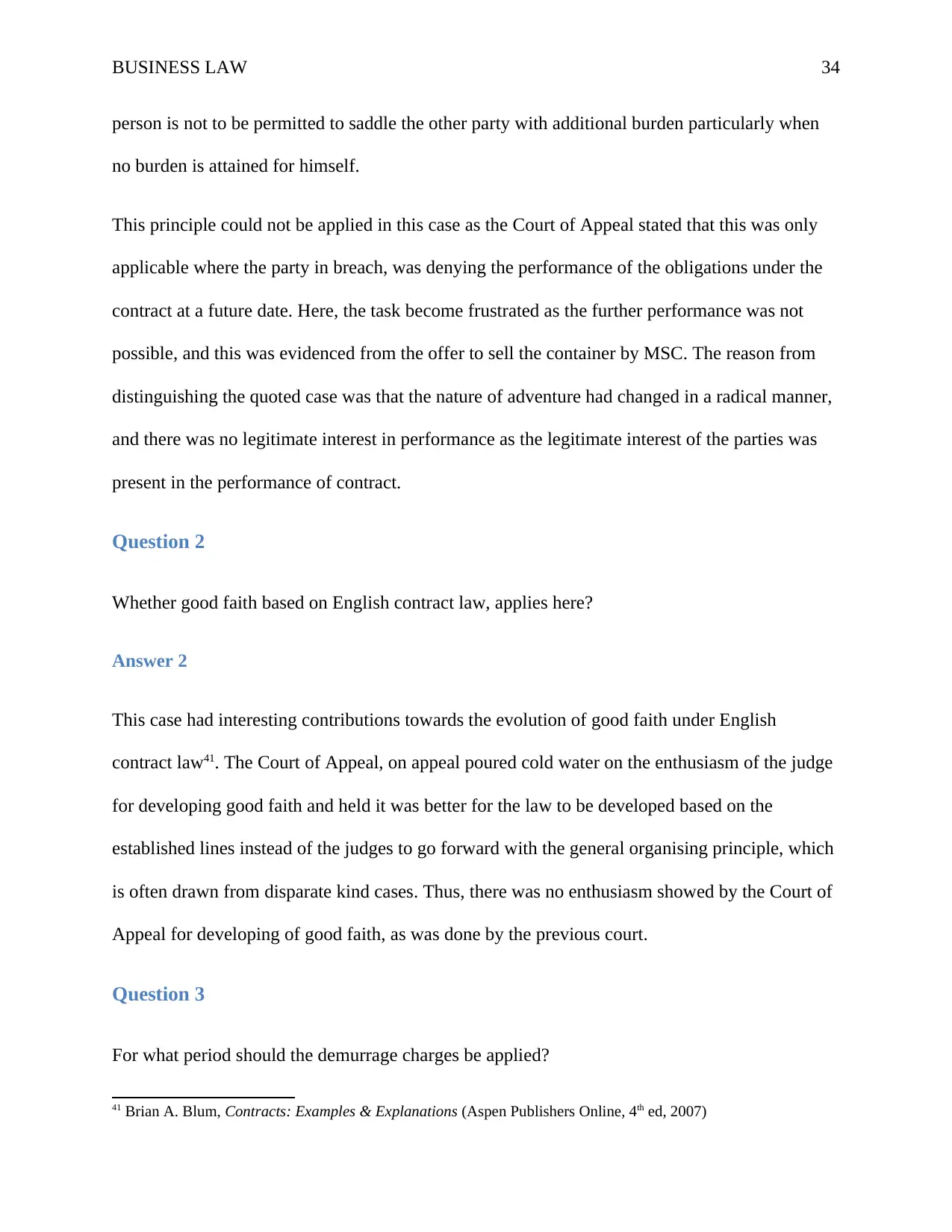
BUSINESS LAW 34
person is not to be permitted to saddle the other party with additional burden particularly when
no burden is attained for himself.
This principle could not be applied in this case as the Court of Appeal stated that this was only
applicable where the party in breach, was denying the performance of the obligations under the
contract at a future date. Here, the task become frustrated as the further performance was not
possible, and this was evidenced from the offer to sell the container by MSC. The reason from
distinguishing the quoted case was that the nature of adventure had changed in a radical manner,
and there was no legitimate interest in performance as the legitimate interest of the parties was
present in the performance of contract.
Question 2
Whether good faith based on English contract law, applies here?
Answer 2
This case had interesting contributions towards the evolution of good faith under English
contract law41. The Court of Appeal, on appeal poured cold water on the enthusiasm of the judge
for developing good faith and held it was better for the law to be developed based on the
established lines instead of the judges to go forward with the general organising principle, which
is often drawn from disparate kind cases. Thus, there was no enthusiasm showed by the Court of
Appeal for developing of good faith, as was done by the previous court.
Question 3
For what period should the demurrage charges be applied?
41 Brian A. Blum, Contracts: Examples & Explanations (Aspen Publishers Online, 4th ed, 2007)
person is not to be permitted to saddle the other party with additional burden particularly when
no burden is attained for himself.
This principle could not be applied in this case as the Court of Appeal stated that this was only
applicable where the party in breach, was denying the performance of the obligations under the
contract at a future date. Here, the task become frustrated as the further performance was not
possible, and this was evidenced from the offer to sell the container by MSC. The reason from
distinguishing the quoted case was that the nature of adventure had changed in a radical manner,
and there was no legitimate interest in performance as the legitimate interest of the parties was
present in the performance of contract.
Question 2
Whether good faith based on English contract law, applies here?
Answer 2
This case had interesting contributions towards the evolution of good faith under English
contract law41. The Court of Appeal, on appeal poured cold water on the enthusiasm of the judge
for developing good faith and held it was better for the law to be developed based on the
established lines instead of the judges to go forward with the general organising principle, which
is often drawn from disparate kind cases. Thus, there was no enthusiasm showed by the Court of
Appeal for developing of good faith, as was done by the previous court.
Question 3
For what period should the demurrage charges be applied?
41 Brian A. Blum, Contracts: Examples & Explanations (Aspen Publishers Online, 4th ed, 2007)
Secure Best Marks with AI Grader
Need help grading? Try our AI Grader for instant feedback on your assignments.

BUSINESS LAW 35
Answer 3
The demurrage charges had to be applied from 14 days until 02nd February 2012.
Question 4
Was there a repudiatory breach or frustration in this case?
Answer 4
In this case, there was an interface between frustration and repudiatory breach. Earlier, there was
a rarity in occurrence of these two concepts in a single case. Though, this case covered both
these aspects as the repudiatory breach created an option of terminating or affirming and the
result of this was frustration. The court thus was of the view that when a repudiatory breach
persisted for such a long period of time, where the nature of the contractual adventure of the
parties was changed in a radical manner, the contract would be deemed to be frustrated and the
right of affirming would no longer be available with the innocent party.
Question 5
Could MSG be successful in claiming the demurrage charges?
Answer 5
As per the verdict given by the Court of Appeals, MSG would be successful in claiming the
demurrage charges from 14 days until 02nd February 2012.
Answer 3
The demurrage charges had to be applied from 14 days until 02nd February 2012.
Question 4
Was there a repudiatory breach or frustration in this case?
Answer 4
In this case, there was an interface between frustration and repudiatory breach. Earlier, there was
a rarity in occurrence of these two concepts in a single case. Though, this case covered both
these aspects as the repudiatory breach created an option of terminating or affirming and the
result of this was frustration. The court thus was of the view that when a repudiatory breach
persisted for such a long period of time, where the nature of the contractual adventure of the
parties was changed in a radical manner, the contract would be deemed to be frustrated and the
right of affirming would no longer be available with the innocent party.
Question 5
Could MSG be successful in claiming the demurrage charges?
Answer 5
As per the verdict given by the Court of Appeals, MSG would be successful in claiming the
demurrage charges from 14 days until 02nd February 2012.
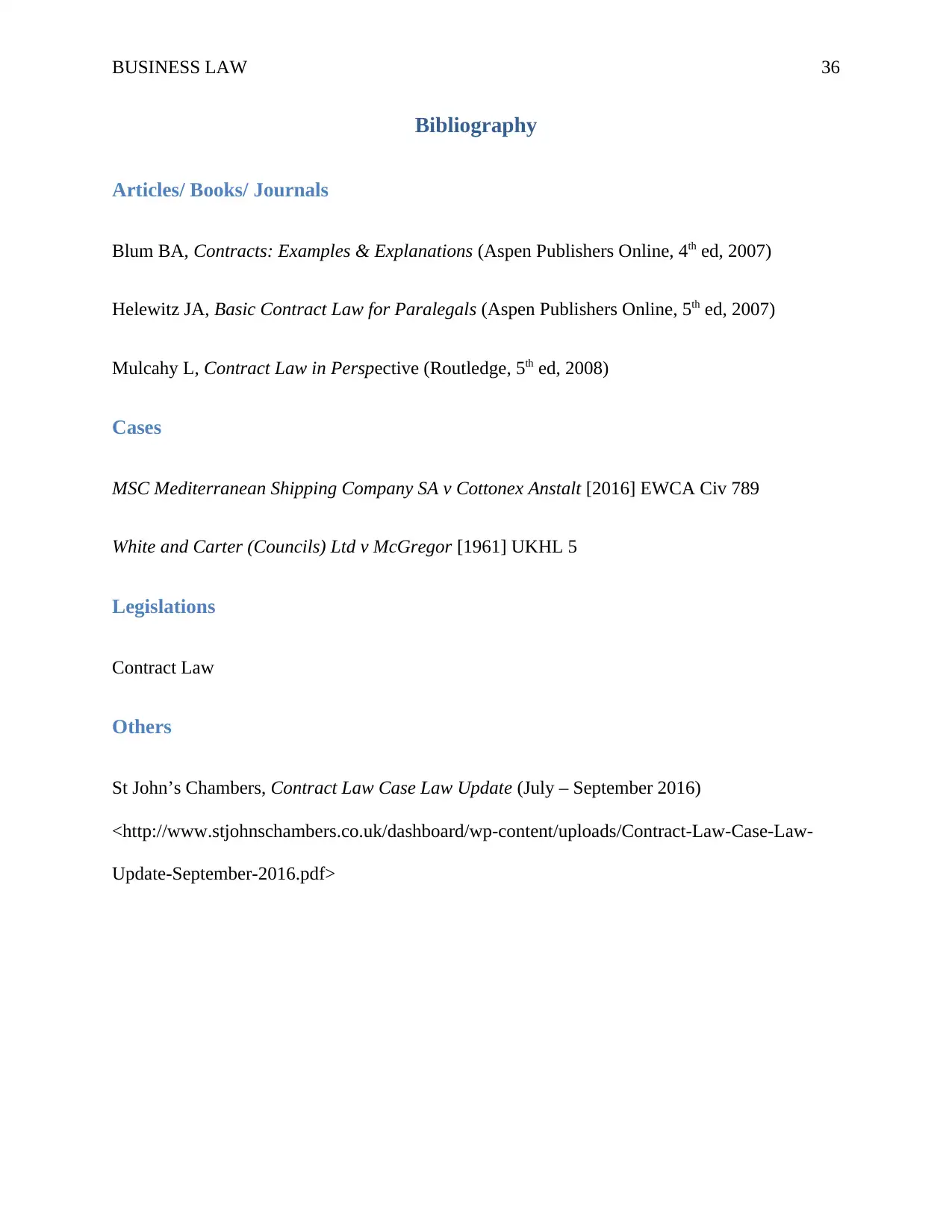
BUSINESS LAW 36
Bibliography
Articles/ Books/ Journals
Blum BA, Contracts: Examples & Explanations (Aspen Publishers Online, 4th ed, 2007)
Helewitz JA, Basic Contract Law for Paralegals (Aspen Publishers Online, 5th ed, 2007)
Mulcahy L, Contract Law in Perspective (Routledge, 5th ed, 2008)
Cases
MSC Mediterranean Shipping Company SA v Cottonex Anstalt [2016] EWCA Civ 789
White and Carter (Councils) Ltd v McGregor [1961] UKHL 5
Legislations
Contract Law
Others
St John’s Chambers, Contract Law Case Law Update (July – September 2016)
<http://www.stjohnschambers.co.uk/dashboard/wp-content/uploads/Contract-Law-Case-Law-
Update-September-2016.pdf>
Bibliography
Articles/ Books/ Journals
Blum BA, Contracts: Examples & Explanations (Aspen Publishers Online, 4th ed, 2007)
Helewitz JA, Basic Contract Law for Paralegals (Aspen Publishers Online, 5th ed, 2007)
Mulcahy L, Contract Law in Perspective (Routledge, 5th ed, 2008)
Cases
MSC Mediterranean Shipping Company SA v Cottonex Anstalt [2016] EWCA Civ 789
White and Carter (Councils) Ltd v McGregor [1961] UKHL 5
Legislations
Contract Law
Others
St John’s Chambers, Contract Law Case Law Update (July – September 2016)
<http://www.stjohnschambers.co.uk/dashboard/wp-content/uploads/Contract-Law-Case-Law-
Update-September-2016.pdf>
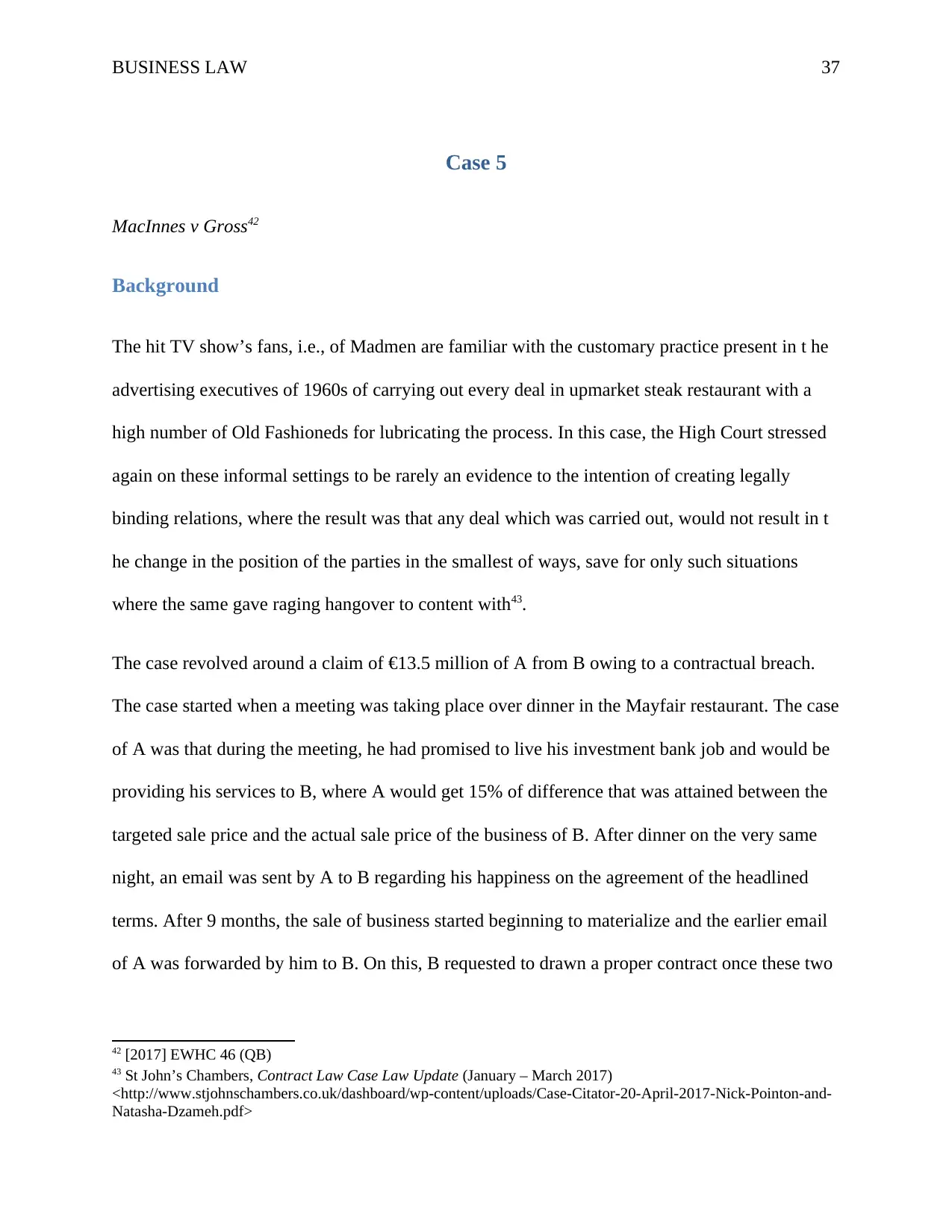
BUSINESS LAW 37
Case 5
MacInnes v Gross42
Background
The hit TV show’s fans, i.e., of Madmen are familiar with the customary practice present in t he
advertising executives of 1960s of carrying out every deal in upmarket steak restaurant with a
high number of Old Fashioneds for lubricating the process. In this case, the High Court stressed
again on these informal settings to be rarely an evidence to the intention of creating legally
binding relations, where the result was that any deal which was carried out, would not result in t
he change in the position of the parties in the smallest of ways, save for only such situations
where the same gave raging hangover to content with43.
The case revolved around a claim of €13.5 million of A from B owing to a contractual breach.
The case started when a meeting was taking place over dinner in the Mayfair restaurant. The case
of A was that during the meeting, he had promised to live his investment bank job and would be
providing his services to B, where A would get 15% of difference that was attained between the
targeted sale price and the actual sale price of the business of B. After dinner on the very same
night, an email was sent by A to B regarding his happiness on the agreement of the headlined
terms. After 9 months, the sale of business started beginning to materialize and the earlier email
of A was forwarded by him to B. On this, B requested to drawn a proper contract once these two
42 [2017] EWHC 46 (QB)
43 St John’s Chambers, Contract Law Case Law Update (January – March 2017)
<http://www.stjohnschambers.co.uk/dashboard/wp-content/uploads/Case-Citator-20-April-2017-Nick-Pointon-and-
Natasha-Dzameh.pdf>
Case 5
MacInnes v Gross42
Background
The hit TV show’s fans, i.e., of Madmen are familiar with the customary practice present in t he
advertising executives of 1960s of carrying out every deal in upmarket steak restaurant with a
high number of Old Fashioneds for lubricating the process. In this case, the High Court stressed
again on these informal settings to be rarely an evidence to the intention of creating legally
binding relations, where the result was that any deal which was carried out, would not result in t
he change in the position of the parties in the smallest of ways, save for only such situations
where the same gave raging hangover to content with43.
The case revolved around a claim of €13.5 million of A from B owing to a contractual breach.
The case started when a meeting was taking place over dinner in the Mayfair restaurant. The case
of A was that during the meeting, he had promised to live his investment bank job and would be
providing his services to B, where A would get 15% of difference that was attained between the
targeted sale price and the actual sale price of the business of B. After dinner on the very same
night, an email was sent by A to B regarding his happiness on the agreement of the headlined
terms. After 9 months, the sale of business started beginning to materialize and the earlier email
of A was forwarded by him to B. On this, B requested to drawn a proper contract once these two
42 [2017] EWHC 46 (QB)
43 St John’s Chambers, Contract Law Case Law Update (January – March 2017)
<http://www.stjohnschambers.co.uk/dashboard/wp-content/uploads/Case-Citator-20-April-2017-Nick-Pointon-and-
Natasha-Dzameh.pdf>
Paraphrase This Document
Need a fresh take? Get an instant paraphrase of this document with our AI Paraphraser
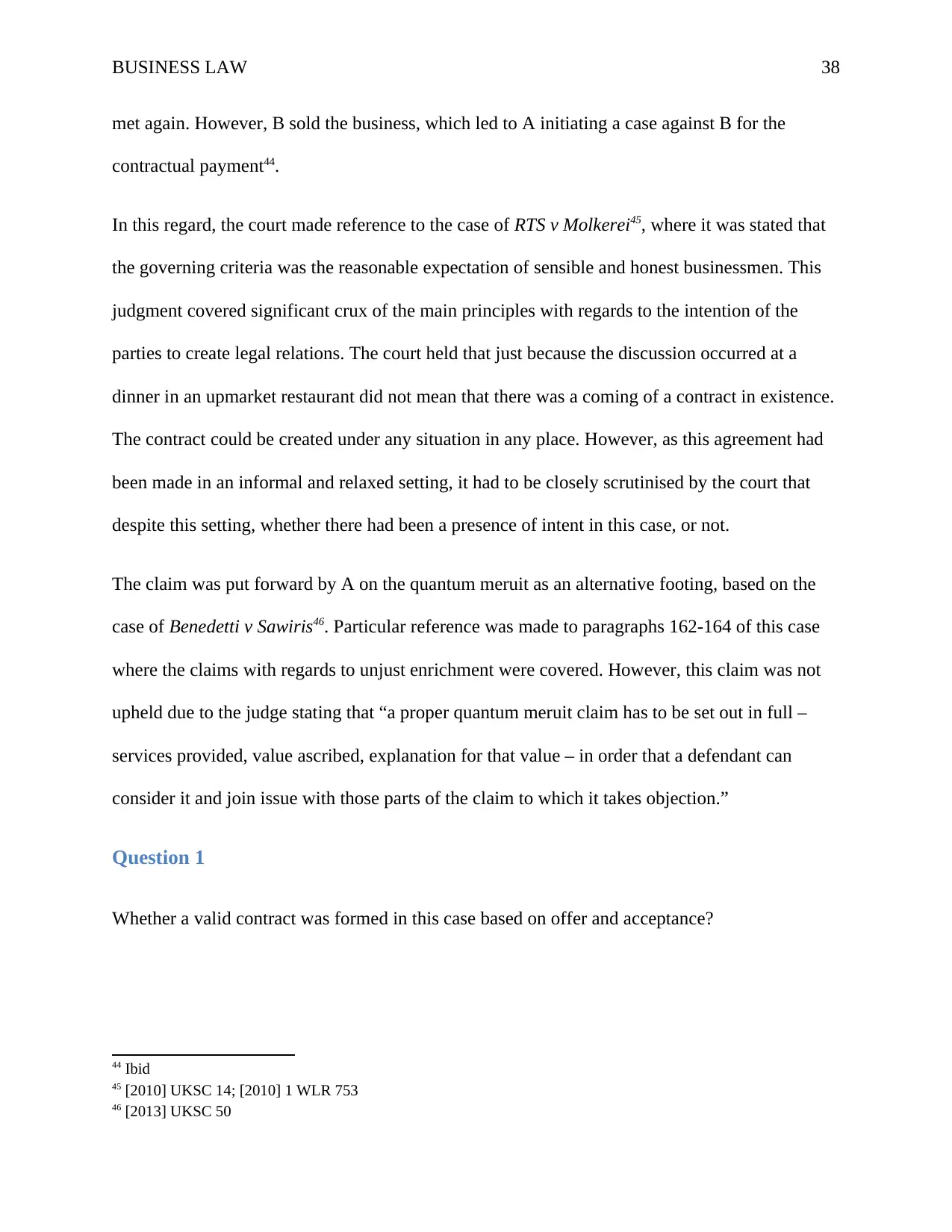
BUSINESS LAW 38
met again. However, B sold the business, which led to A initiating a case against B for the
contractual payment44.
In this regard, the court made reference to the case of RTS v Molkerei45, where it was stated that
the governing criteria was the reasonable expectation of sensible and honest businessmen. This
judgment covered significant crux of the main principles with regards to the intention of the
parties to create legal relations. The court held that just because the discussion occurred at a
dinner in an upmarket restaurant did not mean that there was a coming of a contract in existence.
The contract could be created under any situation in any place. However, as this agreement had
been made in an informal and relaxed setting, it had to be closely scrutinised by the court that
despite this setting, whether there had been a presence of intent in this case, or not.
The claim was put forward by A on the quantum meruit as an alternative footing, based on the
case of Benedetti v Sawiris46. Particular reference was made to paragraphs 162-164 of this case
where the claims with regards to unjust enrichment were covered. However, this claim was not
upheld due to the judge stating that “a proper quantum meruit claim has to be set out in full –
services provided, value ascribed, explanation for that value – in order that a defendant can
consider it and join issue with those parts of the claim to which it takes objection.”
Question 1
Whether a valid contract was formed in this case based on offer and acceptance?
44 Ibid
45 [2010] UKSC 14; [2010] 1 WLR 753
46 [2013] UKSC 50
met again. However, B sold the business, which led to A initiating a case against B for the
contractual payment44.
In this regard, the court made reference to the case of RTS v Molkerei45, where it was stated that
the governing criteria was the reasonable expectation of sensible and honest businessmen. This
judgment covered significant crux of the main principles with regards to the intention of the
parties to create legal relations. The court held that just because the discussion occurred at a
dinner in an upmarket restaurant did not mean that there was a coming of a contract in existence.
The contract could be created under any situation in any place. However, as this agreement had
been made in an informal and relaxed setting, it had to be closely scrutinised by the court that
despite this setting, whether there had been a presence of intent in this case, or not.
The claim was put forward by A on the quantum meruit as an alternative footing, based on the
case of Benedetti v Sawiris46. Particular reference was made to paragraphs 162-164 of this case
where the claims with regards to unjust enrichment were covered. However, this claim was not
upheld due to the judge stating that “a proper quantum meruit claim has to be set out in full –
services provided, value ascribed, explanation for that value – in order that a defendant can
consider it and join issue with those parts of the claim to which it takes objection.”
Question 1
Whether a valid contract was formed in this case based on offer and acceptance?
44 Ibid
45 [2010] UKSC 14; [2010] 1 WLR 753
46 [2013] UKSC 50
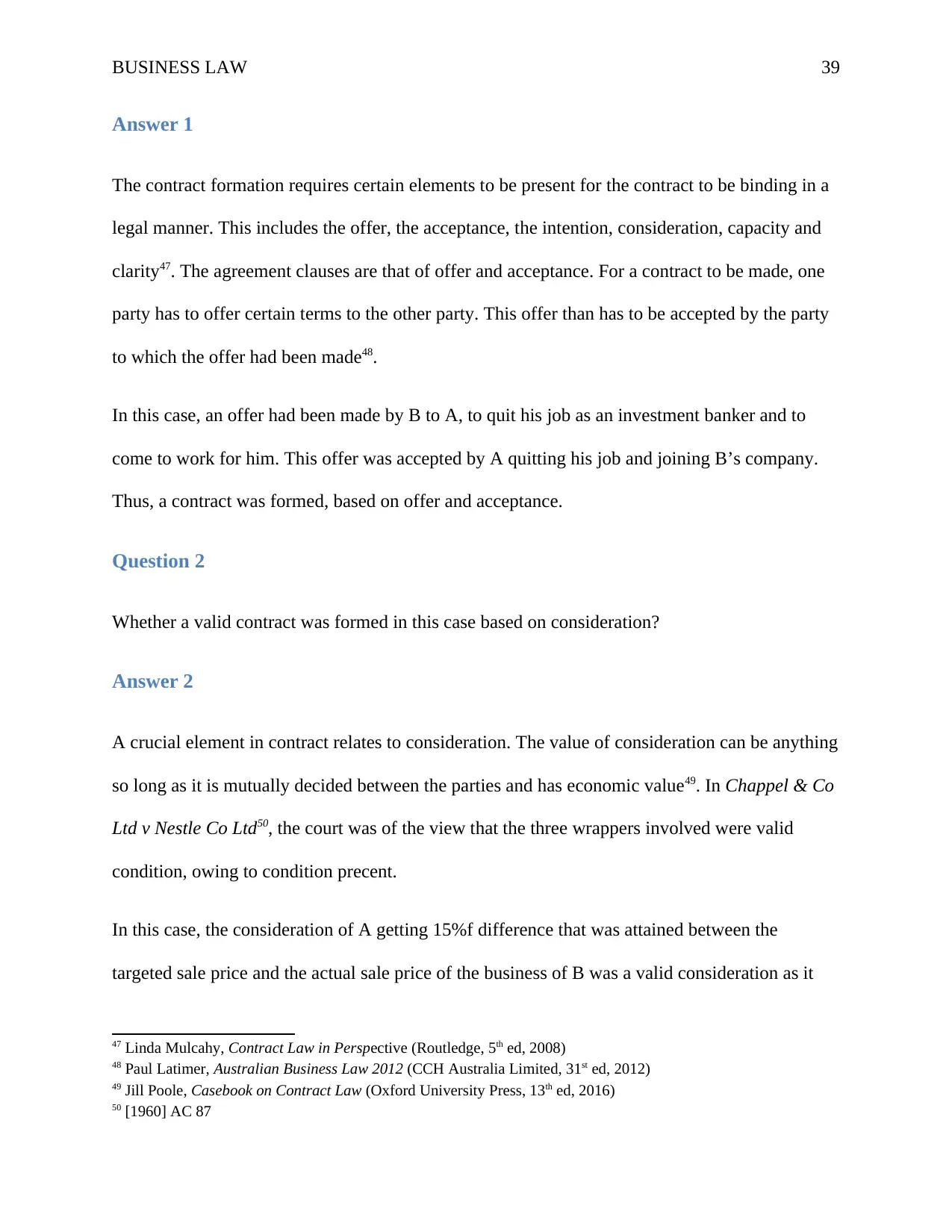
BUSINESS LAW 39
Answer 1
The contract formation requires certain elements to be present for the contract to be binding in a
legal manner. This includes the offer, the acceptance, the intention, consideration, capacity and
clarity47. The agreement clauses are that of offer and acceptance. For a contract to be made, one
party has to offer certain terms to the other party. This offer than has to be accepted by the party
to which the offer had been made48.
In this case, an offer had been made by B to A, to quit his job as an investment banker and to
come to work for him. This offer was accepted by A quitting his job and joining B’s company.
Thus, a contract was formed, based on offer and acceptance.
Question 2
Whether a valid contract was formed in this case based on consideration?
Answer 2
A crucial element in contract relates to consideration. The value of consideration can be anything
so long as it is mutually decided between the parties and has economic value49. In Chappel & Co
Ltd v Nestle Co Ltd50, the court was of the view that the three wrappers involved were valid
condition, owing to condition precent.
In this case, the consideration of A getting 15%f difference that was attained between the
targeted sale price and the actual sale price of the business of B was a valid consideration as it
47 Linda Mulcahy, Contract Law in Perspective (Routledge, 5th ed, 2008)
48 Paul Latimer, Australian Business Law 2012 (CCH Australia Limited, 31st ed, 2012)
49 Jill Poole, Casebook on Contract Law (Oxford University Press, 13th ed, 2016)
50 [1960] AC 87
Answer 1
The contract formation requires certain elements to be present for the contract to be binding in a
legal manner. This includes the offer, the acceptance, the intention, consideration, capacity and
clarity47. The agreement clauses are that of offer and acceptance. For a contract to be made, one
party has to offer certain terms to the other party. This offer than has to be accepted by the party
to which the offer had been made48.
In this case, an offer had been made by B to A, to quit his job as an investment banker and to
come to work for him. This offer was accepted by A quitting his job and joining B’s company.
Thus, a contract was formed, based on offer and acceptance.
Question 2
Whether a valid contract was formed in this case based on consideration?
Answer 2
A crucial element in contract relates to consideration. The value of consideration can be anything
so long as it is mutually decided between the parties and has economic value49. In Chappel & Co
Ltd v Nestle Co Ltd50, the court was of the view that the three wrappers involved were valid
condition, owing to condition precent.
In this case, the consideration of A getting 15%f difference that was attained between the
targeted sale price and the actual sale price of the business of B was a valid consideration as it
47 Linda Mulcahy, Contract Law in Perspective (Routledge, 5th ed, 2008)
48 Paul Latimer, Australian Business Law 2012 (CCH Australia Limited, 31st ed, 2012)
49 Jill Poole, Casebook on Contract Law (Oxford University Press, 13th ed, 2016)
50 [1960] AC 87
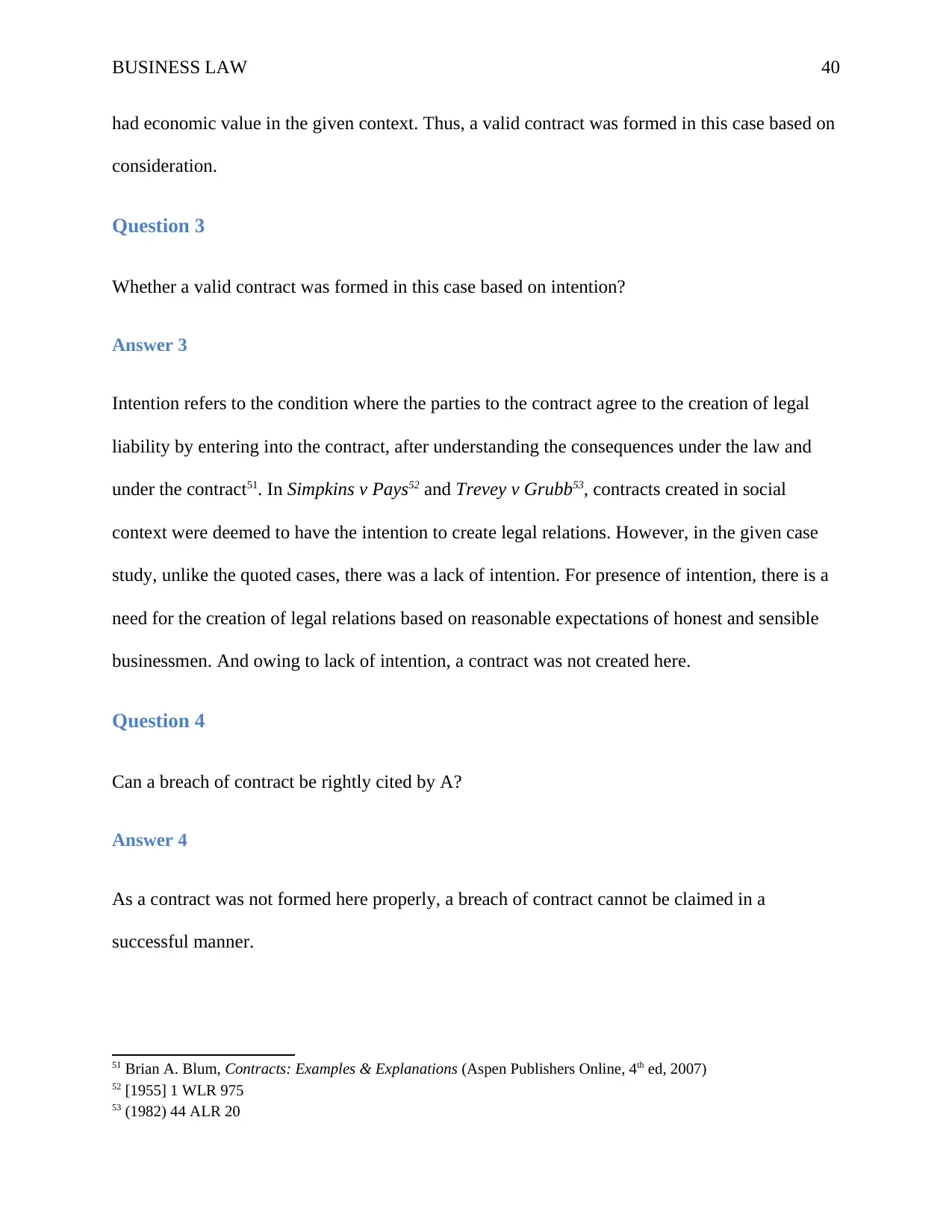
BUSINESS LAW 40
had economic value in the given context. Thus, a valid contract was formed in this case based on
consideration.
Question 3
Whether a valid contract was formed in this case based on intention?
Answer 3
Intention refers to the condition where the parties to the contract agree to the creation of legal
liability by entering into the contract, after understanding the consequences under the law and
under the contract51. In Simpkins v Pays52 and Trevey v Grubb53, contracts created in social
context were deemed to have the intention to create legal relations. However, in the given case
study, unlike the quoted cases, there was a lack of intention. For presence of intention, there is a
need for the creation of legal relations based on reasonable expectations of honest and sensible
businessmen. And owing to lack of intention, a contract was not created here.
Question 4
Can a breach of contract be rightly cited by A?
Answer 4
As a contract was not formed here properly, a breach of contract cannot be claimed in a
successful manner.
51 Brian A. Blum, Contracts: Examples & Explanations (Aspen Publishers Online, 4th ed, 2007)
52 [1955] 1 WLR 975
53 (1982) 44 ALR 20
had economic value in the given context. Thus, a valid contract was formed in this case based on
consideration.
Question 3
Whether a valid contract was formed in this case based on intention?
Answer 3
Intention refers to the condition where the parties to the contract agree to the creation of legal
liability by entering into the contract, after understanding the consequences under the law and
under the contract51. In Simpkins v Pays52 and Trevey v Grubb53, contracts created in social
context were deemed to have the intention to create legal relations. However, in the given case
study, unlike the quoted cases, there was a lack of intention. For presence of intention, there is a
need for the creation of legal relations based on reasonable expectations of honest and sensible
businessmen. And owing to lack of intention, a contract was not created here.
Question 4
Can a breach of contract be rightly cited by A?
Answer 4
As a contract was not formed here properly, a breach of contract cannot be claimed in a
successful manner.
51 Brian A. Blum, Contracts: Examples & Explanations (Aspen Publishers Online, 4th ed, 2007)
52 [1955] 1 WLR 975
53 (1982) 44 ALR 20
Secure Best Marks with AI Grader
Need help grading? Try our AI Grader for instant feedback on your assignments.
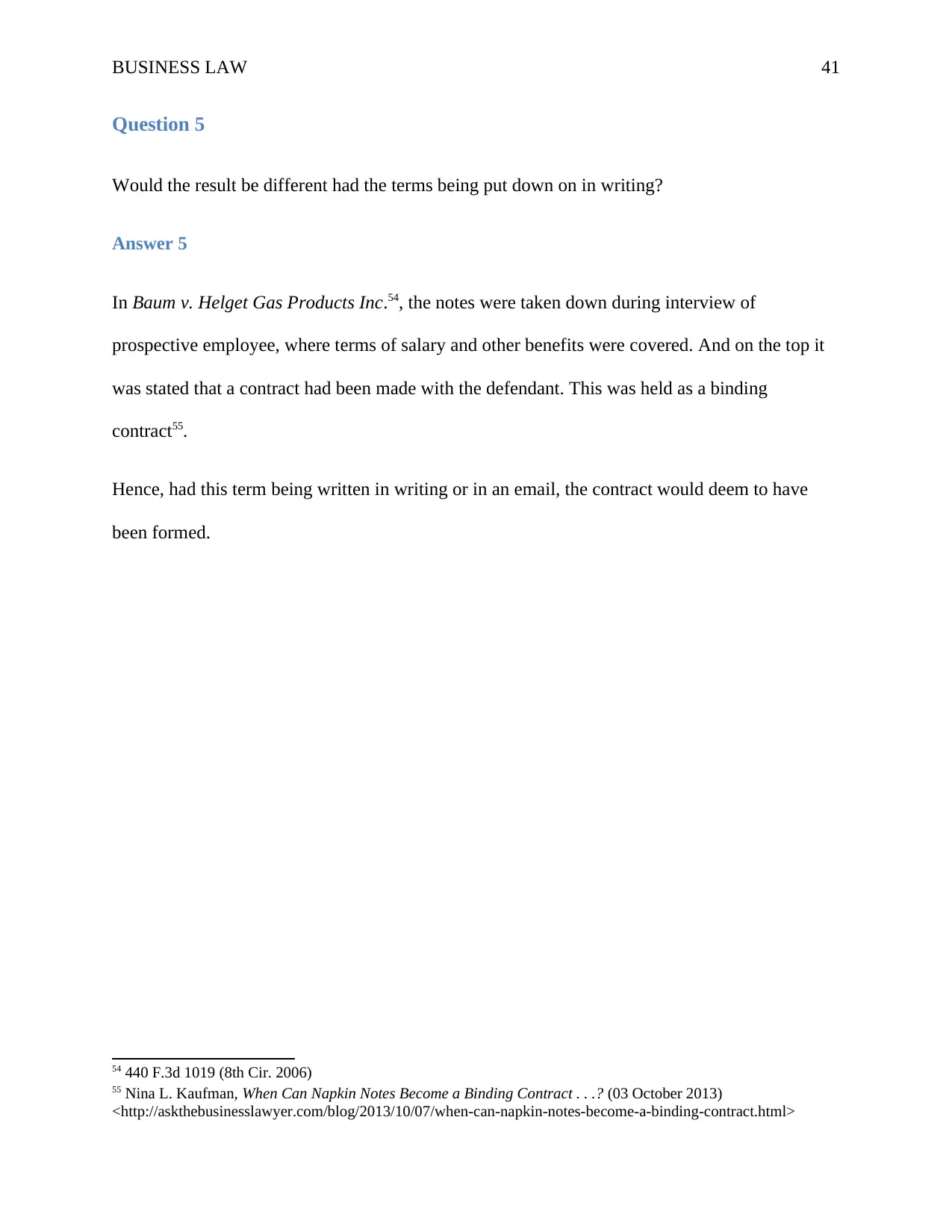
BUSINESS LAW 41
Question 5
Would the result be different had the terms being put down on in writing?
Answer 5
In Baum v. Helget Gas Products Inc.54, the notes were taken down during interview of
prospective employee, where terms of salary and other benefits were covered. And on the top it
was stated that a contract had been made with the defendant. This was held as a binding
contract55.
Hence, had this term being written in writing or in an email, the contract would deem to have
been formed.
54 440 F.3d 1019 (8th Cir. 2006)
55 Nina L. Kaufman, When Can Napkin Notes Become a Binding Contract . . .? (03 October 2013)
<http://askthebusinesslawyer.com/blog/2013/10/07/when-can-napkin-notes-become-a-binding-contract.html>
Question 5
Would the result be different had the terms being put down on in writing?
Answer 5
In Baum v. Helget Gas Products Inc.54, the notes were taken down during interview of
prospective employee, where terms of salary and other benefits were covered. And on the top it
was stated that a contract had been made with the defendant. This was held as a binding
contract55.
Hence, had this term being written in writing or in an email, the contract would deem to have
been formed.
54 440 F.3d 1019 (8th Cir. 2006)
55 Nina L. Kaufman, When Can Napkin Notes Become a Binding Contract . . .? (03 October 2013)
<http://askthebusinesslawyer.com/blog/2013/10/07/when-can-napkin-notes-become-a-binding-contract.html>
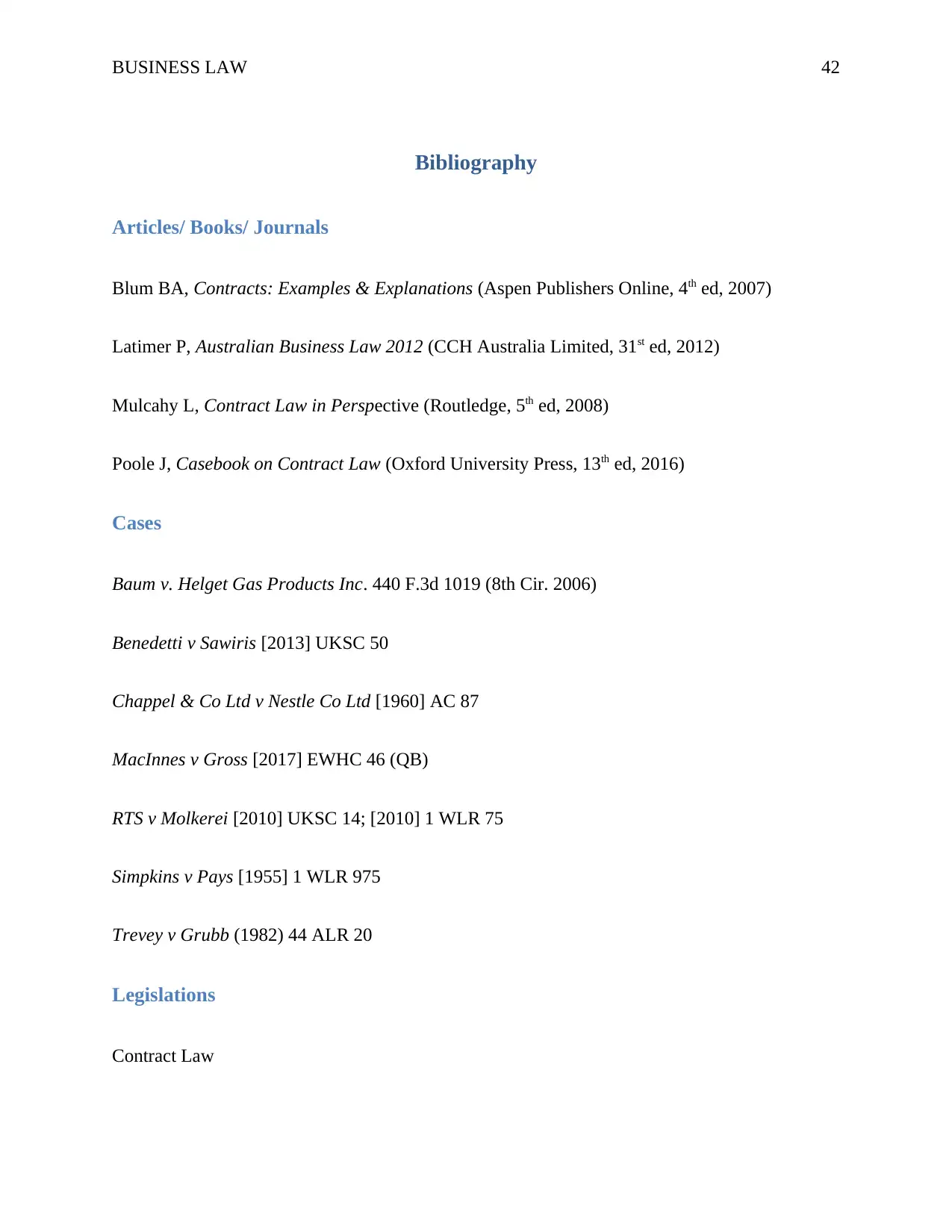
BUSINESS LAW 42
Bibliography
Articles/ Books/ Journals
Blum BA, Contracts: Examples & Explanations (Aspen Publishers Online, 4th ed, 2007)
Latimer P, Australian Business Law 2012 (CCH Australia Limited, 31st ed, 2012)
Mulcahy L, Contract Law in Perspective (Routledge, 5th ed, 2008)
Poole J, Casebook on Contract Law (Oxford University Press, 13th ed, 2016)
Cases
Baum v. Helget Gas Products Inc. 440 F.3d 1019 (8th Cir. 2006)
Benedetti v Sawiris [2013] UKSC 50
Chappel & Co Ltd v Nestle Co Ltd [1960] AC 87
MacInnes v Gross [2017] EWHC 46 (QB)
RTS v Molkerei [2010] UKSC 14; [2010] 1 WLR 75
Simpkins v Pays [1955] 1 WLR 975
Trevey v Grubb (1982) 44 ALR 20
Legislations
Contract Law
Bibliography
Articles/ Books/ Journals
Blum BA, Contracts: Examples & Explanations (Aspen Publishers Online, 4th ed, 2007)
Latimer P, Australian Business Law 2012 (CCH Australia Limited, 31st ed, 2012)
Mulcahy L, Contract Law in Perspective (Routledge, 5th ed, 2008)
Poole J, Casebook on Contract Law (Oxford University Press, 13th ed, 2016)
Cases
Baum v. Helget Gas Products Inc. 440 F.3d 1019 (8th Cir. 2006)
Benedetti v Sawiris [2013] UKSC 50
Chappel & Co Ltd v Nestle Co Ltd [1960] AC 87
MacInnes v Gross [2017] EWHC 46 (QB)
RTS v Molkerei [2010] UKSC 14; [2010] 1 WLR 75
Simpkins v Pays [1955] 1 WLR 975
Trevey v Grubb (1982) 44 ALR 20
Legislations
Contract Law
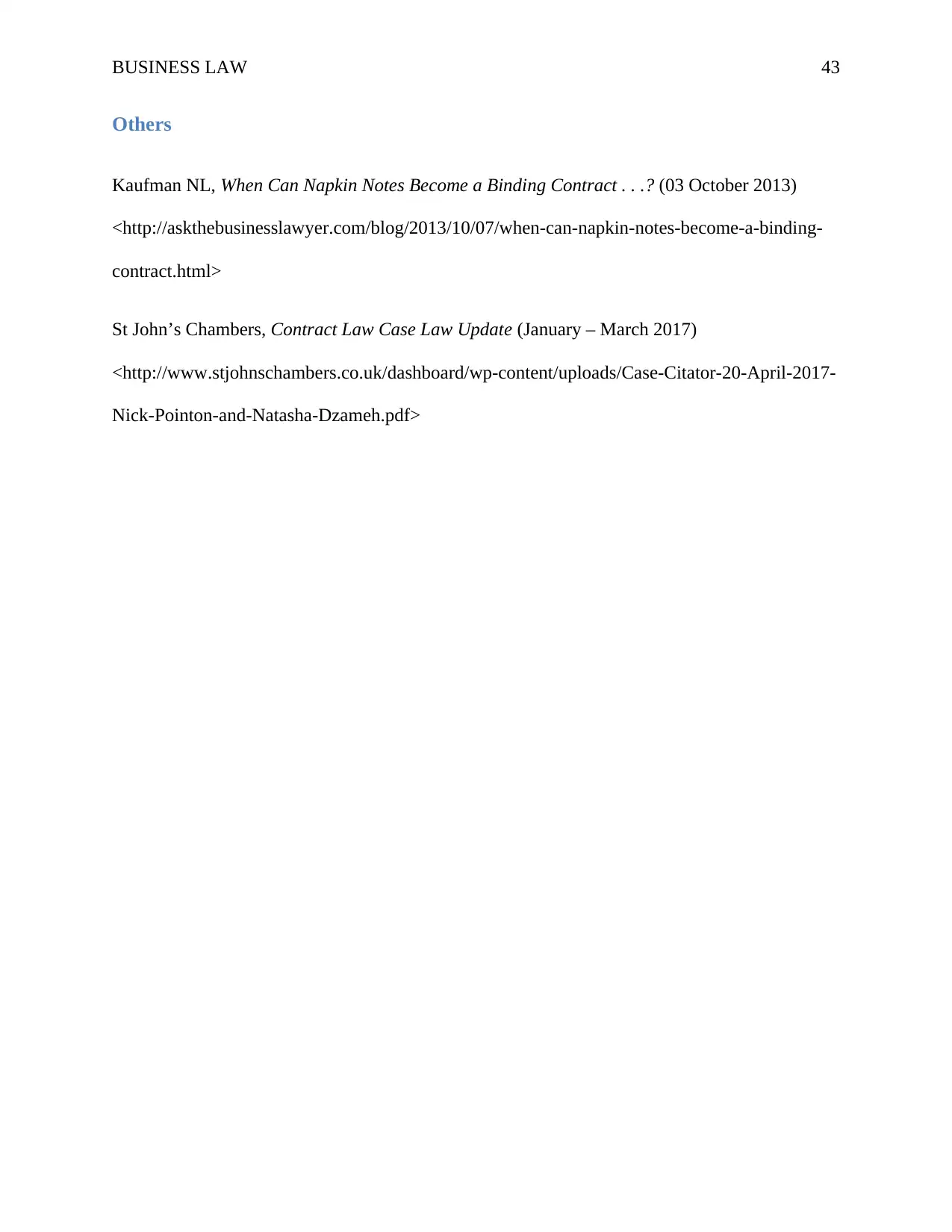
BUSINESS LAW 43
Others
Kaufman NL, When Can Napkin Notes Become a Binding Contract . . .? (03 October 2013)
<http://askthebusinesslawyer.com/blog/2013/10/07/when-can-napkin-notes-become-a-binding-
contract.html>
St John’s Chambers, Contract Law Case Law Update (January – March 2017)
<http://www.stjohnschambers.co.uk/dashboard/wp-content/uploads/Case-Citator-20-April-2017-
Nick-Pointon-and-Natasha-Dzameh.pdf>
Others
Kaufman NL, When Can Napkin Notes Become a Binding Contract . . .? (03 October 2013)
<http://askthebusinesslawyer.com/blog/2013/10/07/when-can-napkin-notes-become-a-binding-
contract.html>
St John’s Chambers, Contract Law Case Law Update (January – March 2017)
<http://www.stjohnschambers.co.uk/dashboard/wp-content/uploads/Case-Citator-20-April-2017-
Nick-Pointon-and-Natasha-Dzameh.pdf>
Paraphrase This Document
Need a fresh take? Get an instant paraphrase of this document with our AI Paraphraser
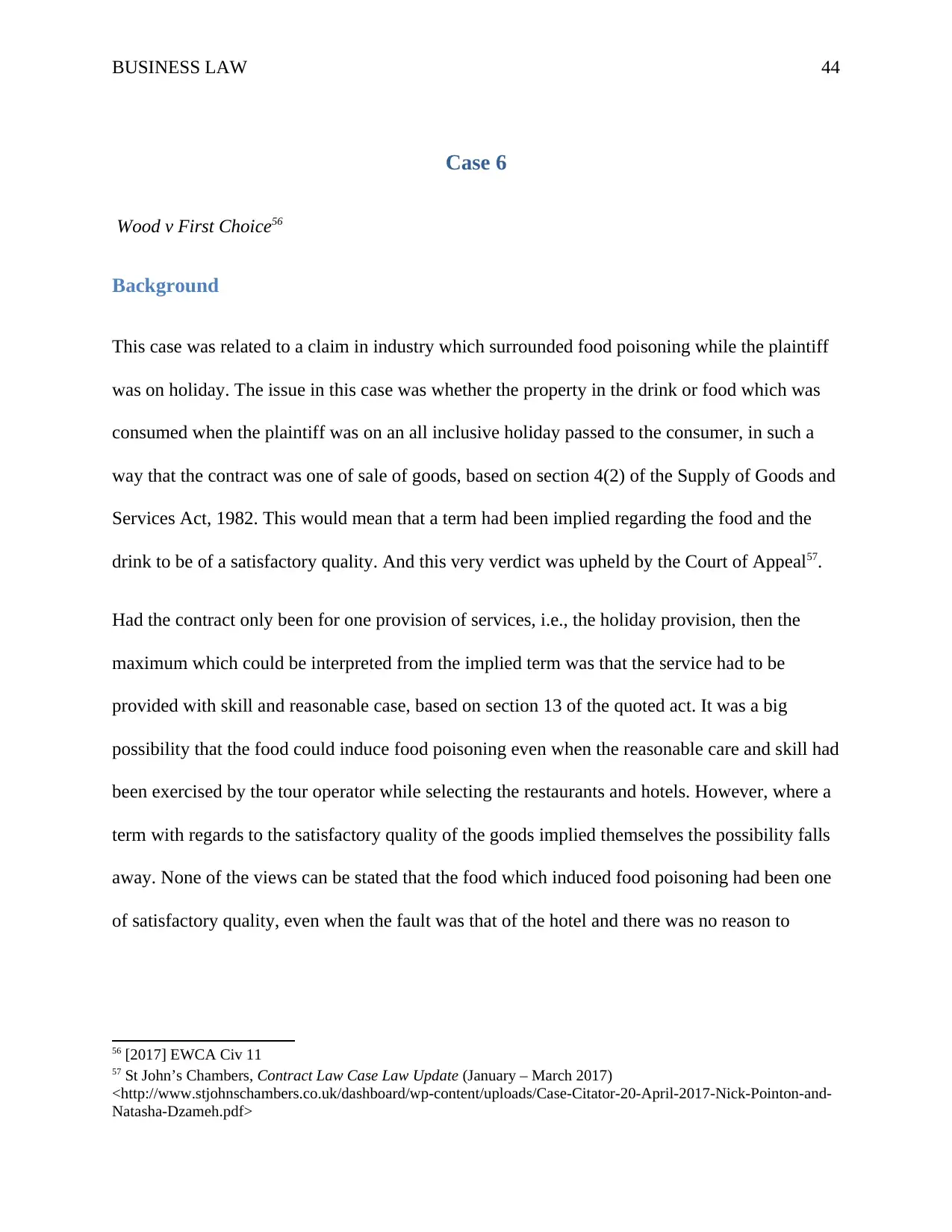
BUSINESS LAW 44
Case 6
Wood v First Choice56
Background
This case was related to a claim in industry which surrounded food poisoning while the plaintiff
was on holiday. The issue in this case was whether the property in the drink or food which was
consumed when the plaintiff was on an all inclusive holiday passed to the consumer, in such a
way that the contract was one of sale of goods, based on section 4(2) of the Supply of Goods and
Services Act, 1982. This would mean that a term had been implied regarding the food and the
drink to be of a satisfactory quality. And this very verdict was upheld by the Court of Appeal57.
Had the contract only been for one provision of services, i.e., the holiday provision, then the
maximum which could be interpreted from the implied term was that the service had to be
provided with skill and reasonable case, based on section 13 of the quoted act. It was a big
possibility that the food could induce food poisoning even when the reasonable care and skill had
been exercised by the tour operator while selecting the restaurants and hotels. However, where a
term with regards to the satisfactory quality of the goods implied themselves the possibility falls
away. None of the views can be stated that the food which induced food poisoning had been one
of satisfactory quality, even when the fault was that of the hotel and there was no reason to
56 [2017] EWCA Civ 11
57 St John’s Chambers, Contract Law Case Law Update (January – March 2017)
<http://www.stjohnschambers.co.uk/dashboard/wp-content/uploads/Case-Citator-20-April-2017-Nick-Pointon-and-
Natasha-Dzameh.pdf>
Case 6
Wood v First Choice56
Background
This case was related to a claim in industry which surrounded food poisoning while the plaintiff
was on holiday. The issue in this case was whether the property in the drink or food which was
consumed when the plaintiff was on an all inclusive holiday passed to the consumer, in such a
way that the contract was one of sale of goods, based on section 4(2) of the Supply of Goods and
Services Act, 1982. This would mean that a term had been implied regarding the food and the
drink to be of a satisfactory quality. And this very verdict was upheld by the Court of Appeal57.
Had the contract only been for one provision of services, i.e., the holiday provision, then the
maximum which could be interpreted from the implied term was that the service had to be
provided with skill and reasonable case, based on section 13 of the quoted act. It was a big
possibility that the food could induce food poisoning even when the reasonable care and skill had
been exercised by the tour operator while selecting the restaurants and hotels. However, where a
term with regards to the satisfactory quality of the goods implied themselves the possibility falls
away. None of the views can be stated that the food which induced food poisoning had been one
of satisfactory quality, even when the fault was that of the hotel and there was no reason to
56 [2017] EWCA Civ 11
57 St John’s Chambers, Contract Law Case Law Update (January – March 2017)
<http://www.stjohnschambers.co.uk/dashboard/wp-content/uploads/Case-Citator-20-April-2017-Nick-Pointon-and-
Natasha-Dzameh.pdf>
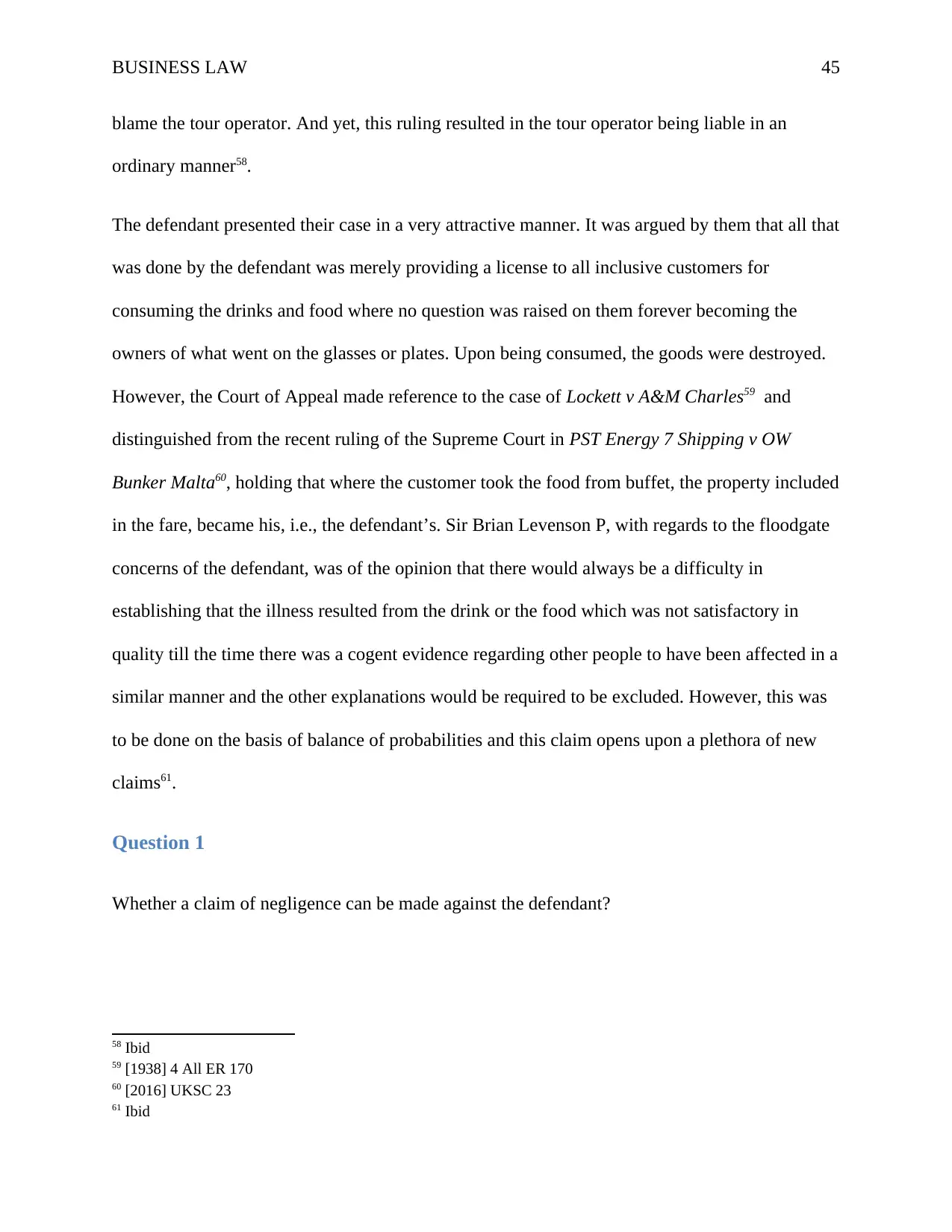
BUSINESS LAW 45
blame the tour operator. And yet, this ruling resulted in the tour operator being liable in an
ordinary manner58.
The defendant presented their case in a very attractive manner. It was argued by them that all that
was done by the defendant was merely providing a license to all inclusive customers for
consuming the drinks and food where no question was raised on them forever becoming the
owners of what went on the glasses or plates. Upon being consumed, the goods were destroyed.
However, the Court of Appeal made reference to the case of Lockett v A&M Charles59 and
distinguished from the recent ruling of the Supreme Court in PST Energy 7 Shipping v OW
Bunker Malta60, holding that where the customer took the food from buffet, the property included
in the fare, became his, i.e., the defendant’s. Sir Brian Levenson P, with regards to the floodgate
concerns of the defendant, was of the opinion that there would always be a difficulty in
establishing that the illness resulted from the drink or the food which was not satisfactory in
quality till the time there was a cogent evidence regarding other people to have been affected in a
similar manner and the other explanations would be required to be excluded. However, this was
to be done on the basis of balance of probabilities and this claim opens upon a plethora of new
claims61.
Question 1
Whether a claim of negligence can be made against the defendant?
58 Ibid
59 [1938] 4 All ER 170
60 [2016] UKSC 23
61 Ibid
blame the tour operator. And yet, this ruling resulted in the tour operator being liable in an
ordinary manner58.
The defendant presented their case in a very attractive manner. It was argued by them that all that
was done by the defendant was merely providing a license to all inclusive customers for
consuming the drinks and food where no question was raised on them forever becoming the
owners of what went on the glasses or plates. Upon being consumed, the goods were destroyed.
However, the Court of Appeal made reference to the case of Lockett v A&M Charles59 and
distinguished from the recent ruling of the Supreme Court in PST Energy 7 Shipping v OW
Bunker Malta60, holding that where the customer took the food from buffet, the property included
in the fare, became his, i.e., the defendant’s. Sir Brian Levenson P, with regards to the floodgate
concerns of the defendant, was of the opinion that there would always be a difficulty in
establishing that the illness resulted from the drink or the food which was not satisfactory in
quality till the time there was a cogent evidence regarding other people to have been affected in a
similar manner and the other explanations would be required to be excluded. However, this was
to be done on the basis of balance of probabilities and this claim opens upon a plethora of new
claims61.
Question 1
Whether a claim of negligence can be made against the defendant?
58 Ibid
59 [1938] 4 All ER 170
60 [2016] UKSC 23
61 Ibid
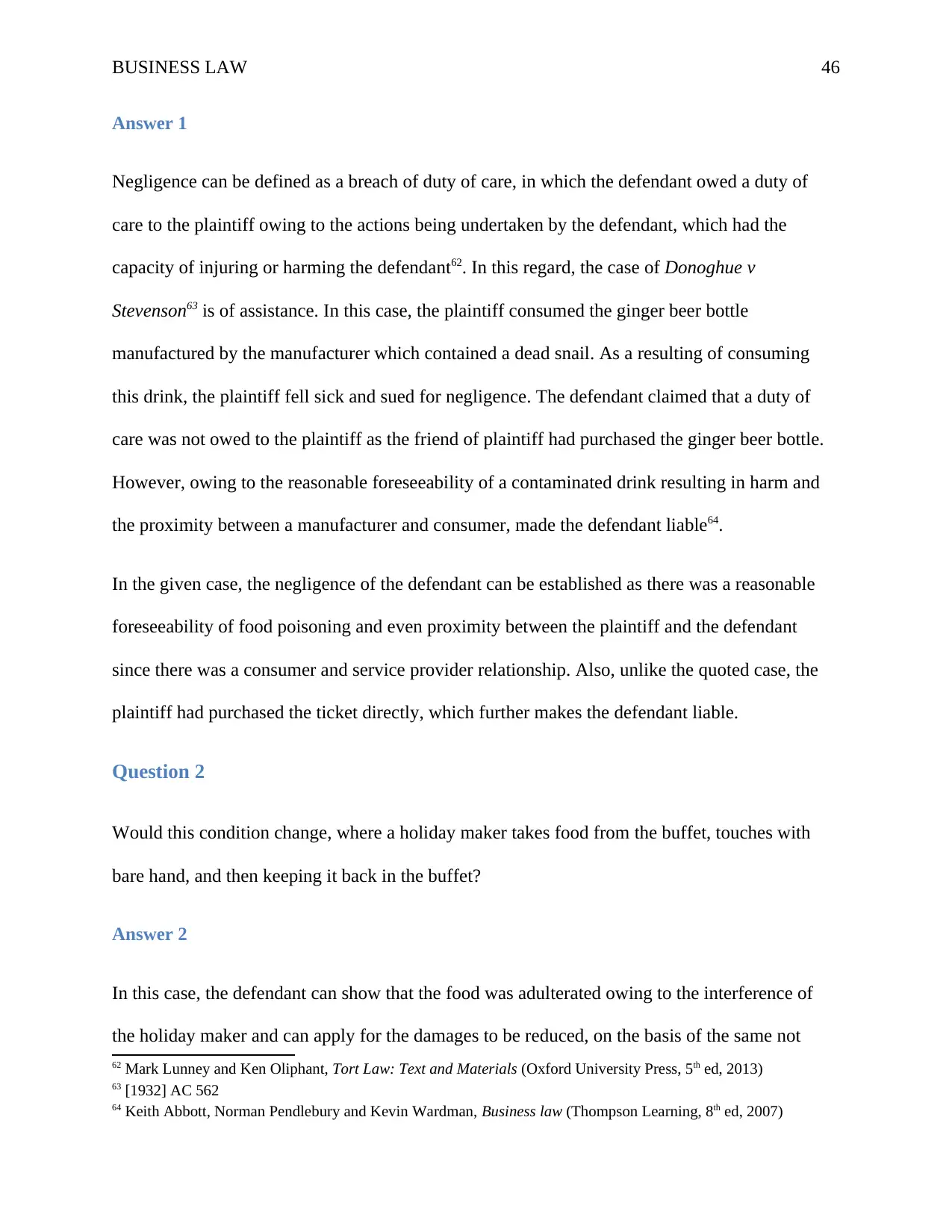
BUSINESS LAW 46
Answer 1
Negligence can be defined as a breach of duty of care, in which the defendant owed a duty of
care to the plaintiff owing to the actions being undertaken by the defendant, which had the
capacity of injuring or harming the defendant62. In this regard, the case of Donoghue v
Stevenson63 is of assistance. In this case, the plaintiff consumed the ginger beer bottle
manufactured by the manufacturer which contained a dead snail. As a resulting of consuming
this drink, the plaintiff fell sick and sued for negligence. The defendant claimed that a duty of
care was not owed to the plaintiff as the friend of plaintiff had purchased the ginger beer bottle.
However, owing to the reasonable foreseeability of a contaminated drink resulting in harm and
the proximity between a manufacturer and consumer, made the defendant liable64.
In the given case, the negligence of the defendant can be established as there was a reasonable
foreseeability of food poisoning and even proximity between the plaintiff and the defendant
since there was a consumer and service provider relationship. Also, unlike the quoted case, the
plaintiff had purchased the ticket directly, which further makes the defendant liable.
Question 2
Would this condition change, where a holiday maker takes food from the buffet, touches with
bare hand, and then keeping it back in the buffet?
Answer 2
In this case, the defendant can show that the food was adulterated owing to the interference of
the holiday maker and can apply for the damages to be reduced, on the basis of the same not
62 Mark Lunney and Ken Oliphant, Tort Law: Text and Materials (Oxford University Press, 5th ed, 2013)
63 [1932] AC 562
64 Keith Abbott, Norman Pendlebury and Kevin Wardman, Business law (Thompson Learning, 8th ed, 2007)
Answer 1
Negligence can be defined as a breach of duty of care, in which the defendant owed a duty of
care to the plaintiff owing to the actions being undertaken by the defendant, which had the
capacity of injuring or harming the defendant62. In this regard, the case of Donoghue v
Stevenson63 is of assistance. In this case, the plaintiff consumed the ginger beer bottle
manufactured by the manufacturer which contained a dead snail. As a resulting of consuming
this drink, the plaintiff fell sick and sued for negligence. The defendant claimed that a duty of
care was not owed to the plaintiff as the friend of plaintiff had purchased the ginger beer bottle.
However, owing to the reasonable foreseeability of a contaminated drink resulting in harm and
the proximity between a manufacturer and consumer, made the defendant liable64.
In the given case, the negligence of the defendant can be established as there was a reasonable
foreseeability of food poisoning and even proximity between the plaintiff and the defendant
since there was a consumer and service provider relationship. Also, unlike the quoted case, the
plaintiff had purchased the ticket directly, which further makes the defendant liable.
Question 2
Would this condition change, where a holiday maker takes food from the buffet, touches with
bare hand, and then keeping it back in the buffet?
Answer 2
In this case, the defendant can show that the food was adulterated owing to the interference of
the holiday maker and can apply for the damages to be reduced, on the basis of the same not
62 Mark Lunney and Ken Oliphant, Tort Law: Text and Materials (Oxford University Press, 5th ed, 2013)
63 [1932] AC 562
64 Keith Abbott, Norman Pendlebury and Kevin Wardman, Business law (Thompson Learning, 8th ed, 2007)
Secure Best Marks with AI Grader
Need help grading? Try our AI Grader for instant feedback on your assignments.
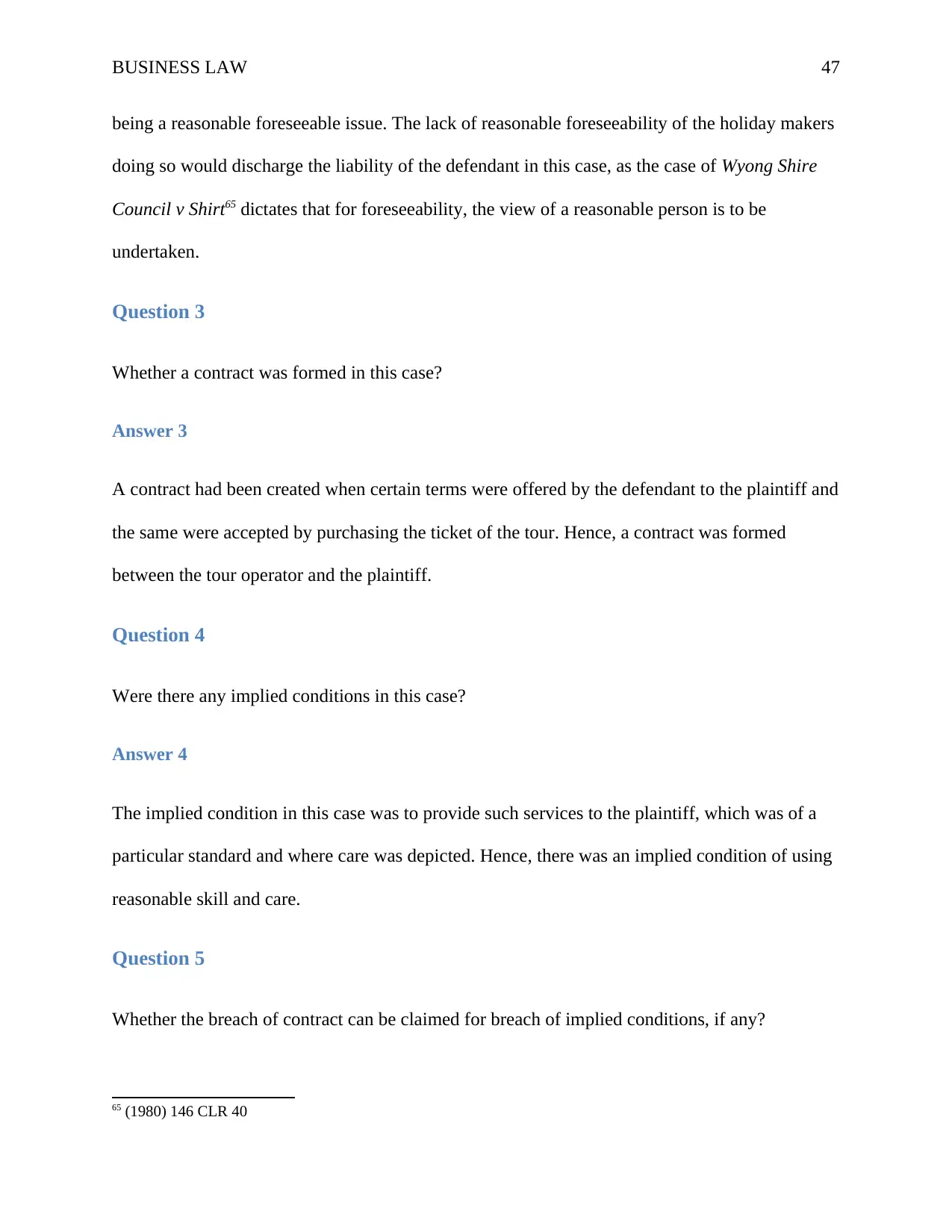
BUSINESS LAW 47
being a reasonable foreseeable issue. The lack of reasonable foreseeability of the holiday makers
doing so would discharge the liability of the defendant in this case, as the case of Wyong Shire
Council v Shirt65 dictates that for foreseeability, the view of a reasonable person is to be
undertaken.
Question 3
Whether a contract was formed in this case?
Answer 3
A contract had been created when certain terms were offered by the defendant to the plaintiff and
the same were accepted by purchasing the ticket of the tour. Hence, a contract was formed
between the tour operator and the plaintiff.
Question 4
Were there any implied conditions in this case?
Answer 4
The implied condition in this case was to provide such services to the plaintiff, which was of a
particular standard and where care was depicted. Hence, there was an implied condition of using
reasonable skill and care.
Question 5
Whether the breach of contract can be claimed for breach of implied conditions, if any?
65 (1980) 146 CLR 40
being a reasonable foreseeable issue. The lack of reasonable foreseeability of the holiday makers
doing so would discharge the liability of the defendant in this case, as the case of Wyong Shire
Council v Shirt65 dictates that for foreseeability, the view of a reasonable person is to be
undertaken.
Question 3
Whether a contract was formed in this case?
Answer 3
A contract had been created when certain terms were offered by the defendant to the plaintiff and
the same were accepted by purchasing the ticket of the tour. Hence, a contract was formed
between the tour operator and the plaintiff.
Question 4
Were there any implied conditions in this case?
Answer 4
The implied condition in this case was to provide such services to the plaintiff, which was of a
particular standard and where care was depicted. Hence, there was an implied condition of using
reasonable skill and care.
Question 5
Whether the breach of contract can be claimed for breach of implied conditions, if any?
65 (1980) 146 CLR 40
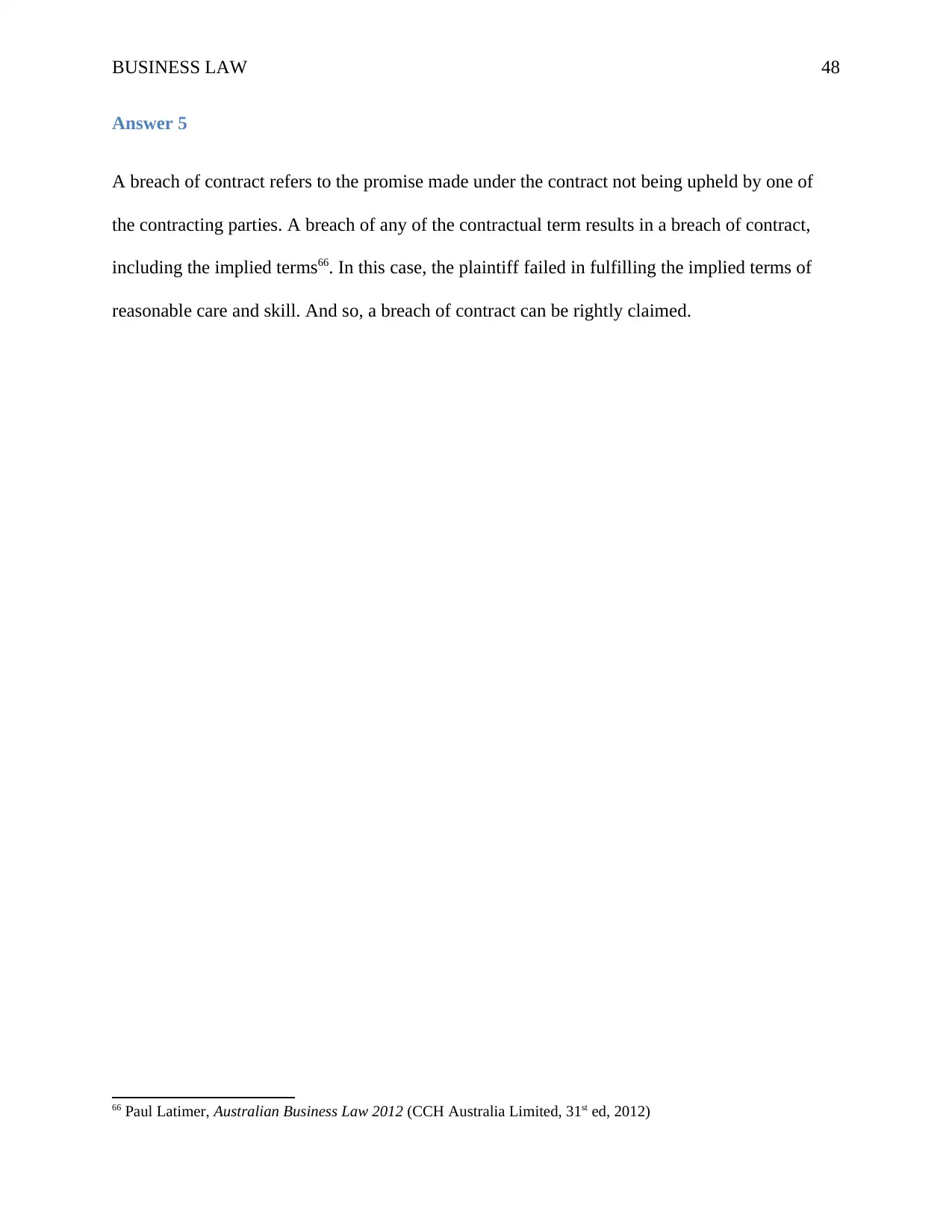
BUSINESS LAW 48
Answer 5
A breach of contract refers to the promise made under the contract not being upheld by one of
the contracting parties. A breach of any of the contractual term results in a breach of contract,
including the implied terms66. In this case, the plaintiff failed in fulfilling the implied terms of
reasonable care and skill. And so, a breach of contract can be rightly claimed.
66 Paul Latimer, Australian Business Law 2012 (CCH Australia Limited, 31st ed, 2012)
Answer 5
A breach of contract refers to the promise made under the contract not being upheld by one of
the contracting parties. A breach of any of the contractual term results in a breach of contract,
including the implied terms66. In this case, the plaintiff failed in fulfilling the implied terms of
reasonable care and skill. And so, a breach of contract can be rightly claimed.
66 Paul Latimer, Australian Business Law 2012 (CCH Australia Limited, 31st ed, 2012)
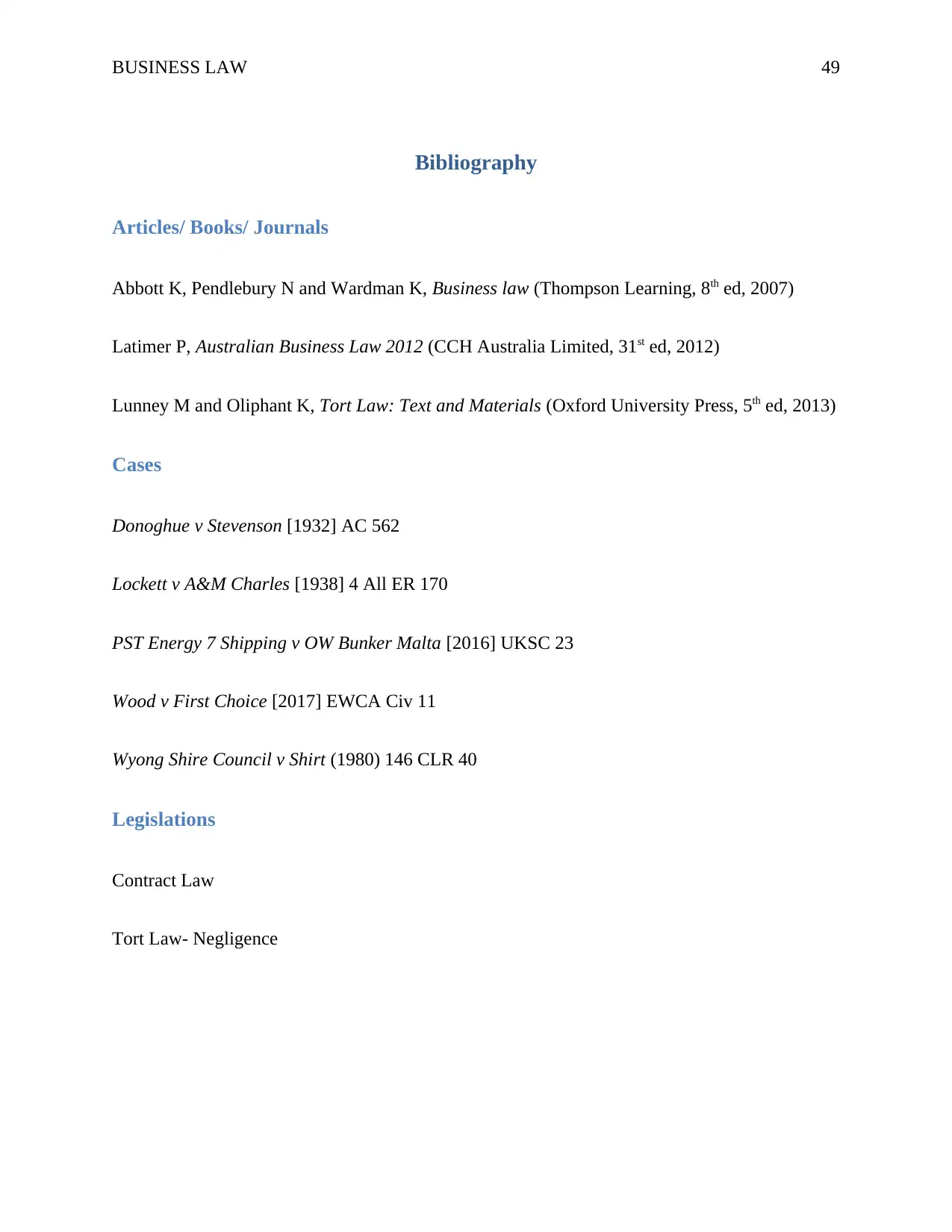
BUSINESS LAW 49
Bibliography
Articles/ Books/ Journals
Abbott K, Pendlebury N and Wardman K, Business law (Thompson Learning, 8th ed, 2007)
Latimer P, Australian Business Law 2012 (CCH Australia Limited, 31st ed, 2012)
Lunney M and Oliphant K, Tort Law: Text and Materials (Oxford University Press, 5th ed, 2013)
Cases
Donoghue v Stevenson [1932] AC 562
Lockett v A&M Charles [1938] 4 All ER 170
PST Energy 7 Shipping v OW Bunker Malta [2016] UKSC 23
Wood v First Choice [2017] EWCA Civ 11
Wyong Shire Council v Shirt (1980) 146 CLR 40
Legislations
Contract Law
Tort Law- Negligence
Bibliography
Articles/ Books/ Journals
Abbott K, Pendlebury N and Wardman K, Business law (Thompson Learning, 8th ed, 2007)
Latimer P, Australian Business Law 2012 (CCH Australia Limited, 31st ed, 2012)
Lunney M and Oliphant K, Tort Law: Text and Materials (Oxford University Press, 5th ed, 2013)
Cases
Donoghue v Stevenson [1932] AC 562
Lockett v A&M Charles [1938] 4 All ER 170
PST Energy 7 Shipping v OW Bunker Malta [2016] UKSC 23
Wood v First Choice [2017] EWCA Civ 11
Wyong Shire Council v Shirt (1980) 146 CLR 40
Legislations
Contract Law
Tort Law- Negligence
Paraphrase This Document
Need a fresh take? Get an instant paraphrase of this document with our AI Paraphraser
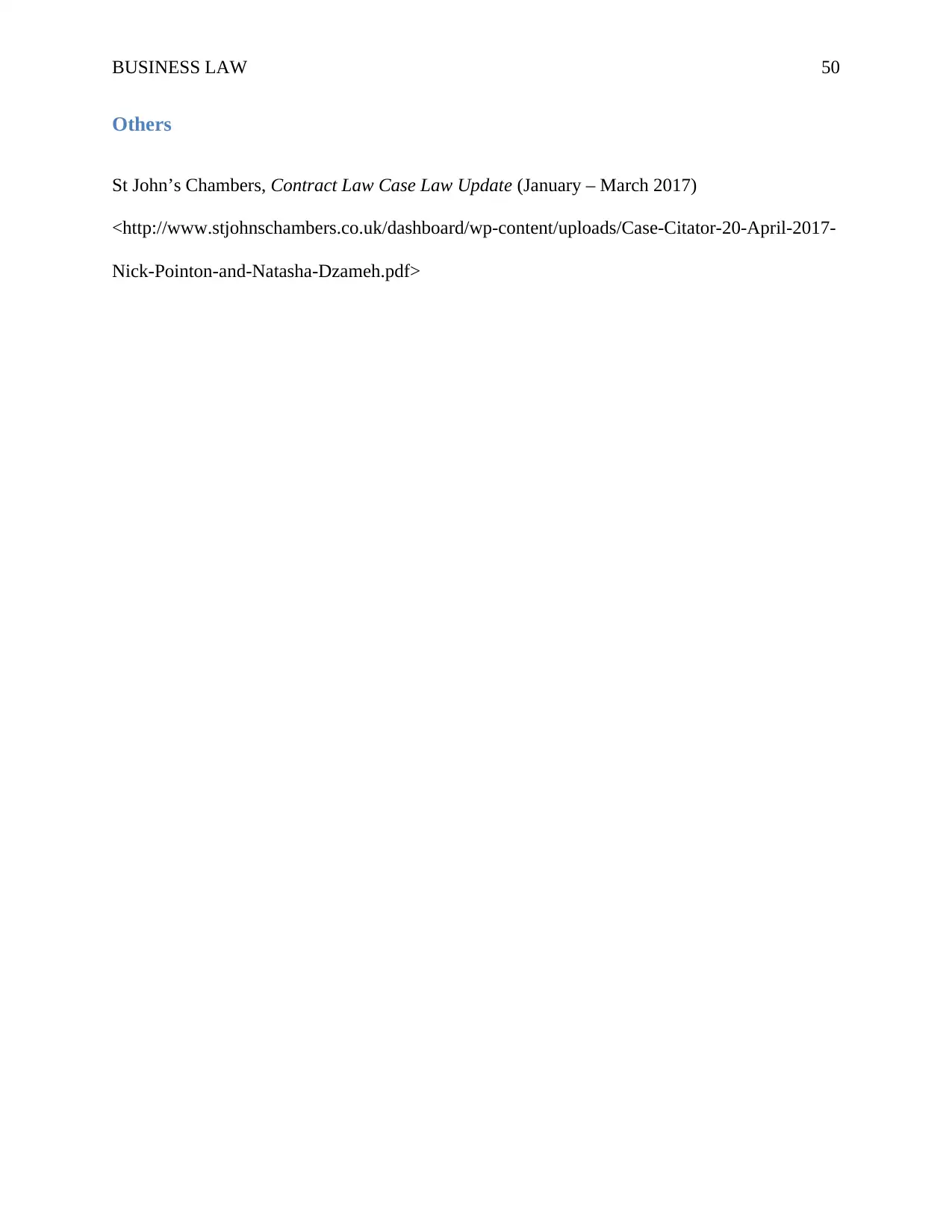
BUSINESS LAW 50
Others
St John’s Chambers, Contract Law Case Law Update (January – March 2017)
<http://www.stjohnschambers.co.uk/dashboard/wp-content/uploads/Case-Citator-20-April-2017-
Nick-Pointon-and-Natasha-Dzameh.pdf>
Others
St John’s Chambers, Contract Law Case Law Update (January – March 2017)
<http://www.stjohnschambers.co.uk/dashboard/wp-content/uploads/Case-Citator-20-April-2017-
Nick-Pointon-and-Natasha-Dzameh.pdf>
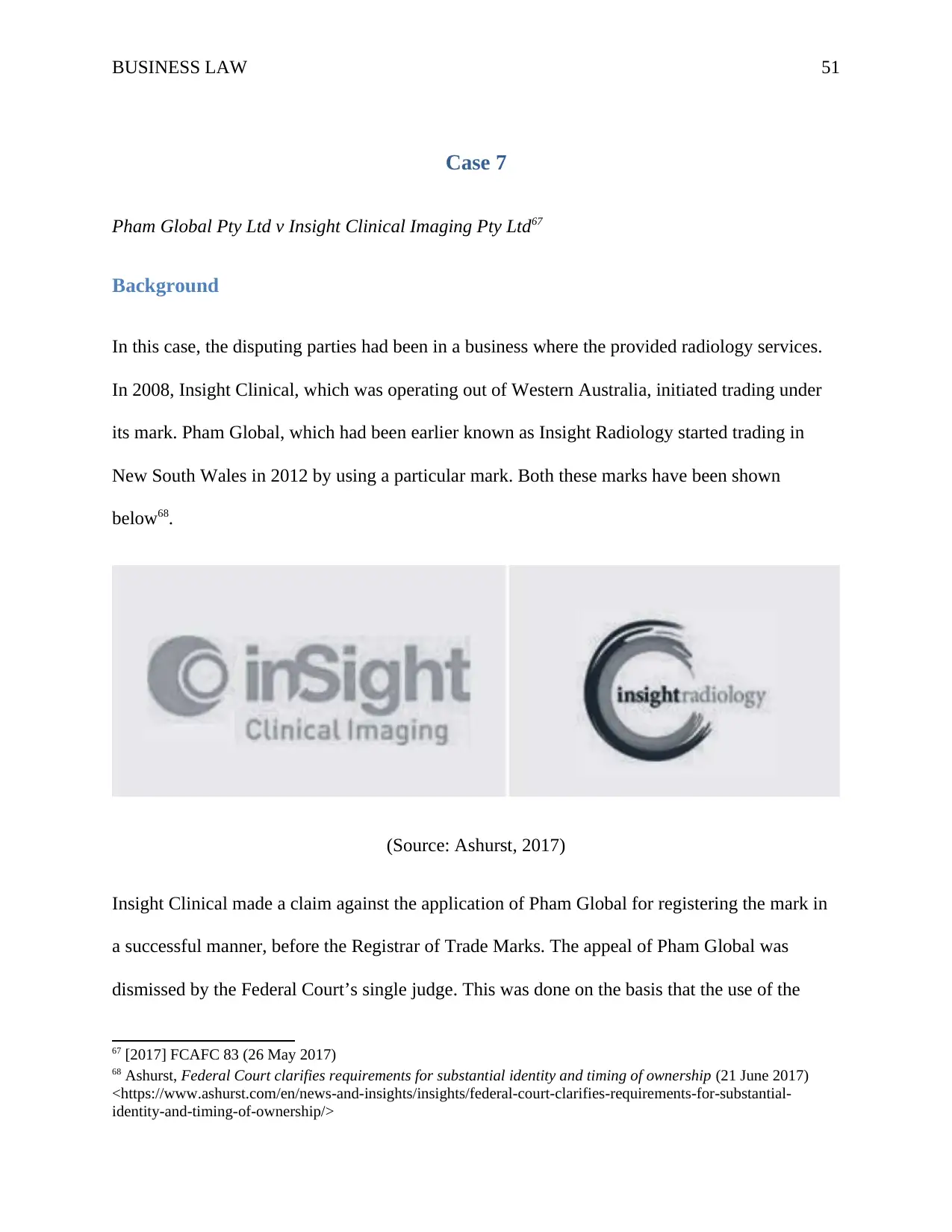
BUSINESS LAW 51
Case 7
Pham Global Pty Ltd v Insight Clinical Imaging Pty Ltd67
Background
In this case, the disputing parties had been in a business where the provided radiology services.
In 2008, Insight Clinical, which was operating out of Western Australia, initiated trading under
its mark. Pham Global, which had been earlier known as Insight Radiology started trading in
New South Wales in 2012 by using a particular mark. Both these marks have been shown
below68.
(Source: Ashurst, 2017)
Insight Clinical made a claim against the application of Pham Global for registering the mark in
a successful manner, before the Registrar of Trade Marks. The appeal of Pham Global was
dismissed by the Federal Court’s single judge. This was done on the basis that the use of the
67 [2017] FCAFC 83 (26 May 2017)
68 Ashurst, Federal Court clarifies requirements for substantial identity and timing of ownership (21 June 2017)
<https://www.ashurst.com/en/news-and-insights/insights/federal-court-clarifies-requirements-for-substantial-
identity-and-timing-of-ownership/>
Case 7
Pham Global Pty Ltd v Insight Clinical Imaging Pty Ltd67
Background
In this case, the disputing parties had been in a business where the provided radiology services.
In 2008, Insight Clinical, which was operating out of Western Australia, initiated trading under
its mark. Pham Global, which had been earlier known as Insight Radiology started trading in
New South Wales in 2012 by using a particular mark. Both these marks have been shown
below68.
(Source: Ashurst, 2017)
Insight Clinical made a claim against the application of Pham Global for registering the mark in
a successful manner, before the Registrar of Trade Marks. The appeal of Pham Global was
dismissed by the Federal Court’s single judge. This was done on the basis that the use of the
67 [2017] FCAFC 83 (26 May 2017)
68 Ashurst, Federal Court clarifies requirements for substantial identity and timing of ownership (21 June 2017)
<https://www.ashurst.com/en/news-and-insights/insights/federal-court-clarifies-requirements-for-substantial-
identity-and-timing-of-ownership/>
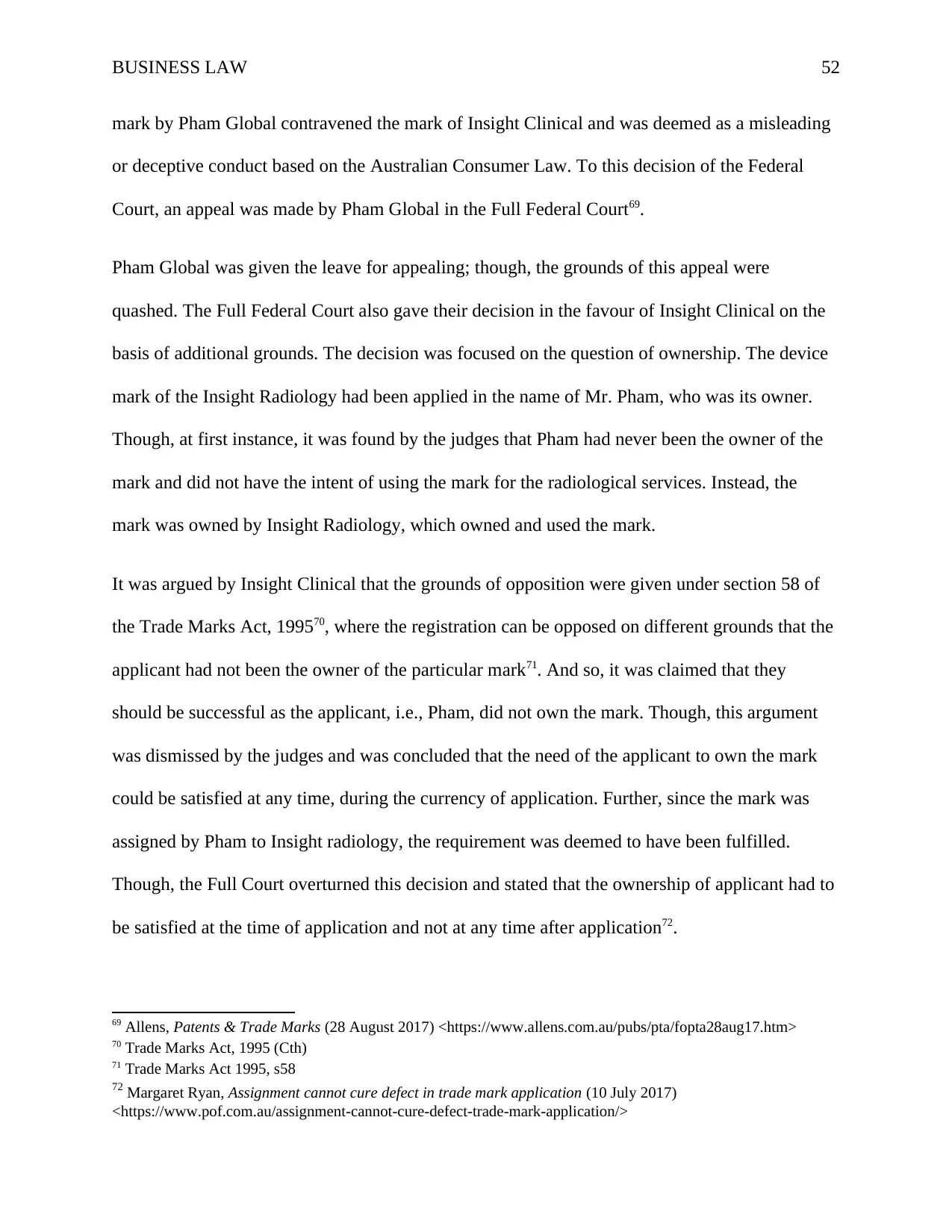
BUSINESS LAW 52
mark by Pham Global contravened the mark of Insight Clinical and was deemed as a misleading
or deceptive conduct based on the Australian Consumer Law. To this decision of the Federal
Court, an appeal was made by Pham Global in the Full Federal Court69.
Pham Global was given the leave for appealing; though, the grounds of this appeal were
quashed. The Full Federal Court also gave their decision in the favour of Insight Clinical on the
basis of additional grounds. The decision was focused on the question of ownership. The device
mark of the Insight Radiology had been applied in the name of Mr. Pham, who was its owner.
Though, at first instance, it was found by the judges that Pham had never been the owner of the
mark and did not have the intent of using the mark for the radiological services. Instead, the
mark was owned by Insight Radiology, which owned and used the mark.
It was argued by Insight Clinical that the grounds of opposition were given under section 58 of
the Trade Marks Act, 199570, where the registration can be opposed on different grounds that the
applicant had not been the owner of the particular mark71. And so, it was claimed that they
should be successful as the applicant, i.e., Pham, did not own the mark. Though, this argument
was dismissed by the judges and was concluded that the need of the applicant to own the mark
could be satisfied at any time, during the currency of application. Further, since the mark was
assigned by Pham to Insight radiology, the requirement was deemed to have been fulfilled.
Though, the Full Court overturned this decision and stated that the ownership of applicant had to
be satisfied at the time of application and not at any time after application72.
69 Allens, Patents & Trade Marks (28 August 2017) <https://www.allens.com.au/pubs/pta/fopta28aug17.htm>
70 Trade Marks Act, 1995 (Cth)
71 Trade Marks Act 1995, s58
72 Margaret Ryan, Assignment cannot cure defect in trade mark application (10 July 2017)
<https://www.pof.com.au/assignment-cannot-cure-defect-trade-mark-application/>
mark by Pham Global contravened the mark of Insight Clinical and was deemed as a misleading
or deceptive conduct based on the Australian Consumer Law. To this decision of the Federal
Court, an appeal was made by Pham Global in the Full Federal Court69.
Pham Global was given the leave for appealing; though, the grounds of this appeal were
quashed. The Full Federal Court also gave their decision in the favour of Insight Clinical on the
basis of additional grounds. The decision was focused on the question of ownership. The device
mark of the Insight Radiology had been applied in the name of Mr. Pham, who was its owner.
Though, at first instance, it was found by the judges that Pham had never been the owner of the
mark and did not have the intent of using the mark for the radiological services. Instead, the
mark was owned by Insight Radiology, which owned and used the mark.
It was argued by Insight Clinical that the grounds of opposition were given under section 58 of
the Trade Marks Act, 199570, where the registration can be opposed on different grounds that the
applicant had not been the owner of the particular mark71. And so, it was claimed that they
should be successful as the applicant, i.e., Pham, did not own the mark. Though, this argument
was dismissed by the judges and was concluded that the need of the applicant to own the mark
could be satisfied at any time, during the currency of application. Further, since the mark was
assigned by Pham to Insight radiology, the requirement was deemed to have been fulfilled.
Though, the Full Court overturned this decision and stated that the ownership of applicant had to
be satisfied at the time of application and not at any time after application72.
69 Allens, Patents & Trade Marks (28 August 2017) <https://www.allens.com.au/pubs/pta/fopta28aug17.htm>
70 Trade Marks Act, 1995 (Cth)
71 Trade Marks Act 1995, s58
72 Margaret Ryan, Assignment cannot cure defect in trade mark application (10 July 2017)
<https://www.pof.com.au/assignment-cannot-cure-defect-trade-mark-application/>
Secure Best Marks with AI Grader
Need help grading? Try our AI Grader for instant feedback on your assignments.

BUSINESS LAW 53
The Full Court also held that the device mark of Insight Radiology had been majorly identical to
Insight Clinical Imaging device mark. And it was stated by the judges that the process of
evaluation while assessing the major identity miscarried as the judge did not refer to the crucial
components of the marks, and even failed in assessing the relative significance of similarities and
difference with regards to these elements. The essential elements of both these marks covered a
circular device and the word insight. And so, there was held to be a resemblance between the
marks and that there were slight differences in the essential elements. As a result of this, based
on section 58 of this act, the conditions were satisfied and neither of the two, i.e., Pham nor
Insight Clinical, owned the Insight Radiology device mark.
Question 1
Whether the two marks were similar enough to breach any intellectual property laws?
Answer 1
In this case, the two marks are being questioned upon, which would attract the trademark related
intellectual property laws. In this regard, the Trade Marks Act, 1995 (Cth) would be applicable.
Question 2
What is the process of making a trade mark application?
Answer 2
In order to file a trade mark application in Australia, there is a need for the applicant to be the
owner of the trademark and is also required to fulfil one of the criteria laid down under section
27(1) of this act. As per this section, the applicant needs to be using or needs to have the intent of
The Full Court also held that the device mark of Insight Radiology had been majorly identical to
Insight Clinical Imaging device mark. And it was stated by the judges that the process of
evaluation while assessing the major identity miscarried as the judge did not refer to the crucial
components of the marks, and even failed in assessing the relative significance of similarities and
difference with regards to these elements. The essential elements of both these marks covered a
circular device and the word insight. And so, there was held to be a resemblance between the
marks and that there were slight differences in the essential elements. As a result of this, based
on section 58 of this act, the conditions were satisfied and neither of the two, i.e., Pham nor
Insight Clinical, owned the Insight Radiology device mark.
Question 1
Whether the two marks were similar enough to breach any intellectual property laws?
Answer 1
In this case, the two marks are being questioned upon, which would attract the trademark related
intellectual property laws. In this regard, the Trade Marks Act, 1995 (Cth) would be applicable.
Question 2
What is the process of making a trade mark application?
Answer 2
In order to file a trade mark application in Australia, there is a need for the applicant to be the
owner of the trademark and is also required to fulfil one of the criteria laid down under section
27(1) of this act. As per this section, the applicant needs to be using or needs to have the intent of
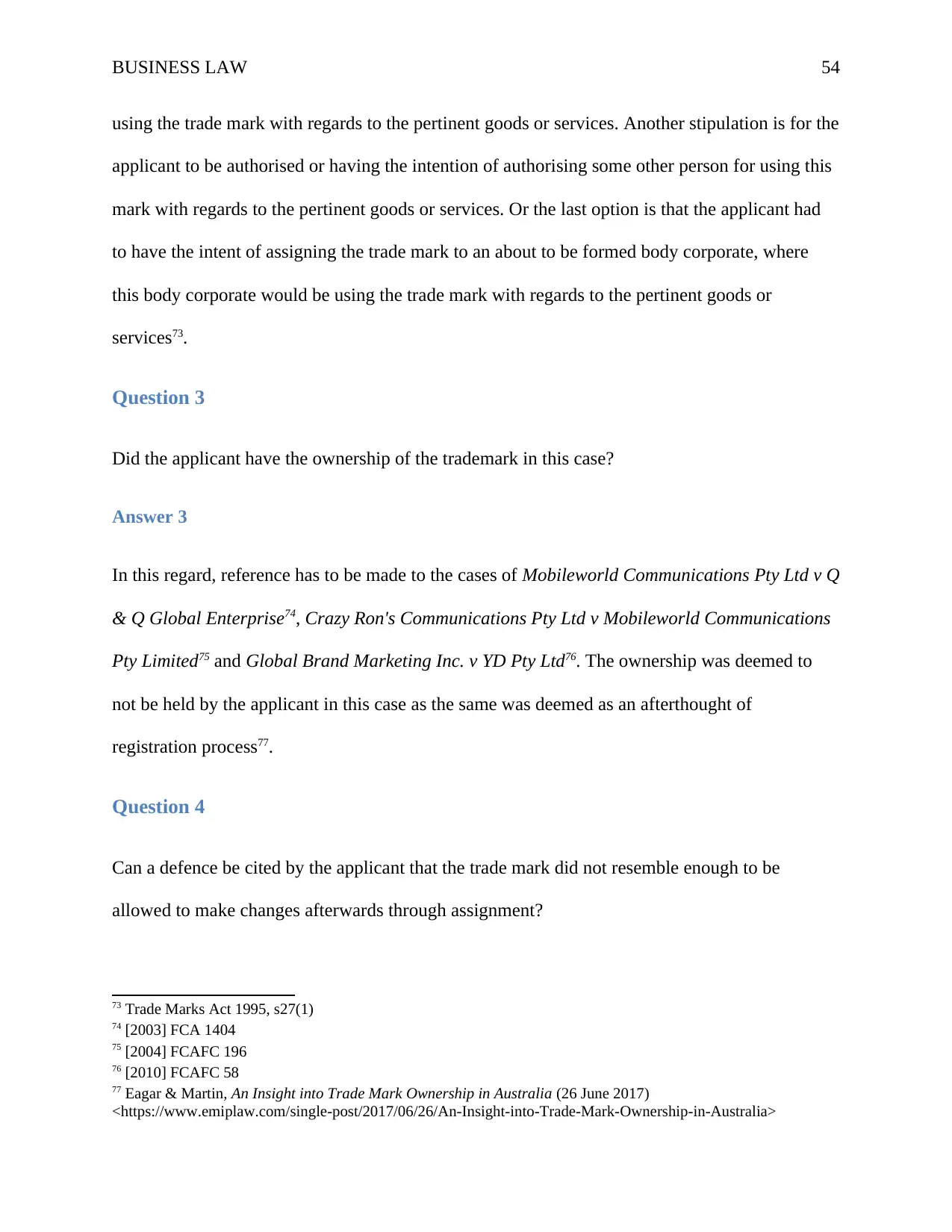
BUSINESS LAW 54
using the trade mark with regards to the pertinent goods or services. Another stipulation is for the
applicant to be authorised or having the intention of authorising some other person for using this
mark with regards to the pertinent goods or services. Or the last option is that the applicant had
to have the intent of assigning the trade mark to an about to be formed body corporate, where
this body corporate would be using the trade mark with regards to the pertinent goods or
services73.
Question 3
Did the applicant have the ownership of the trademark in this case?
Answer 3
In this regard, reference has to be made to the cases of Mobileworld Communications Pty Ltd v Q
& Q Global Enterprise74, Crazy Ron's Communications Pty Ltd v Mobileworld Communications
Pty Limited75 and Global Brand Marketing Inc. v YD Pty Ltd76. The ownership was deemed to
not be held by the applicant in this case as the same was deemed as an afterthought of
registration process77.
Question 4
Can a defence be cited by the applicant that the trade mark did not resemble enough to be
allowed to make changes afterwards through assignment?
73 Trade Marks Act 1995, s27(1)
74 [2003] FCA 1404
75 [2004] FCAFC 196
76 [2010] FCAFC 58
77 Eagar & Martin, An Insight into Trade Mark Ownership in Australia (26 June 2017)
<https://www.emiplaw.com/single-post/2017/06/26/An-Insight-into-Trade-Mark-Ownership-in-Australia>
using the trade mark with regards to the pertinent goods or services. Another stipulation is for the
applicant to be authorised or having the intention of authorising some other person for using this
mark with regards to the pertinent goods or services. Or the last option is that the applicant had
to have the intent of assigning the trade mark to an about to be formed body corporate, where
this body corporate would be using the trade mark with regards to the pertinent goods or
services73.
Question 3
Did the applicant have the ownership of the trademark in this case?
Answer 3
In this regard, reference has to be made to the cases of Mobileworld Communications Pty Ltd v Q
& Q Global Enterprise74, Crazy Ron's Communications Pty Ltd v Mobileworld Communications
Pty Limited75 and Global Brand Marketing Inc. v YD Pty Ltd76. The ownership was deemed to
not be held by the applicant in this case as the same was deemed as an afterthought of
registration process77.
Question 4
Can a defence be cited by the applicant that the trade mark did not resemble enough to be
allowed to make changes afterwards through assignment?
73 Trade Marks Act 1995, s27(1)
74 [2003] FCA 1404
75 [2004] FCAFC 196
76 [2010] FCAFC 58
77 Eagar & Martin, An Insight into Trade Mark Ownership in Australia (26 June 2017)
<https://www.emiplaw.com/single-post/2017/06/26/An-Insight-into-Trade-Mark-Ownership-in-Australia>
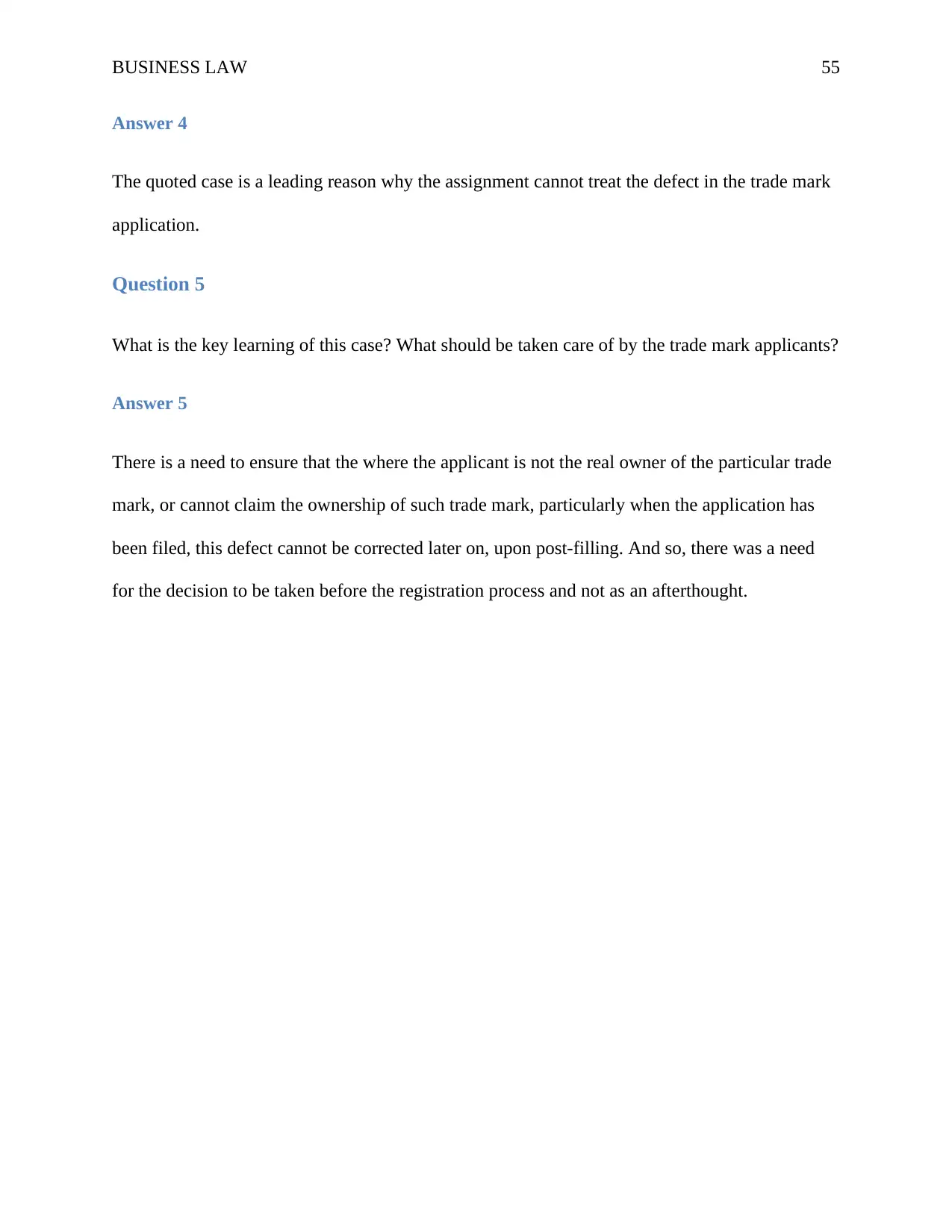
BUSINESS LAW 55
Answer 4
The quoted case is a leading reason why the assignment cannot treat the defect in the trade mark
application.
Question 5
What is the key learning of this case? What should be taken care of by the trade mark applicants?
Answer 5
There is a need to ensure that the where the applicant is not the real owner of the particular trade
mark, or cannot claim the ownership of such trade mark, particularly when the application has
been filed, this defect cannot be corrected later on, upon post-filling. And so, there was a need
for the decision to be taken before the registration process and not as an afterthought.
Answer 4
The quoted case is a leading reason why the assignment cannot treat the defect in the trade mark
application.
Question 5
What is the key learning of this case? What should be taken care of by the trade mark applicants?
Answer 5
There is a need to ensure that the where the applicant is not the real owner of the particular trade
mark, or cannot claim the ownership of such trade mark, particularly when the application has
been filed, this defect cannot be corrected later on, upon post-filling. And so, there was a need
for the decision to be taken before the registration process and not as an afterthought.
Paraphrase This Document
Need a fresh take? Get an instant paraphrase of this document with our AI Paraphraser
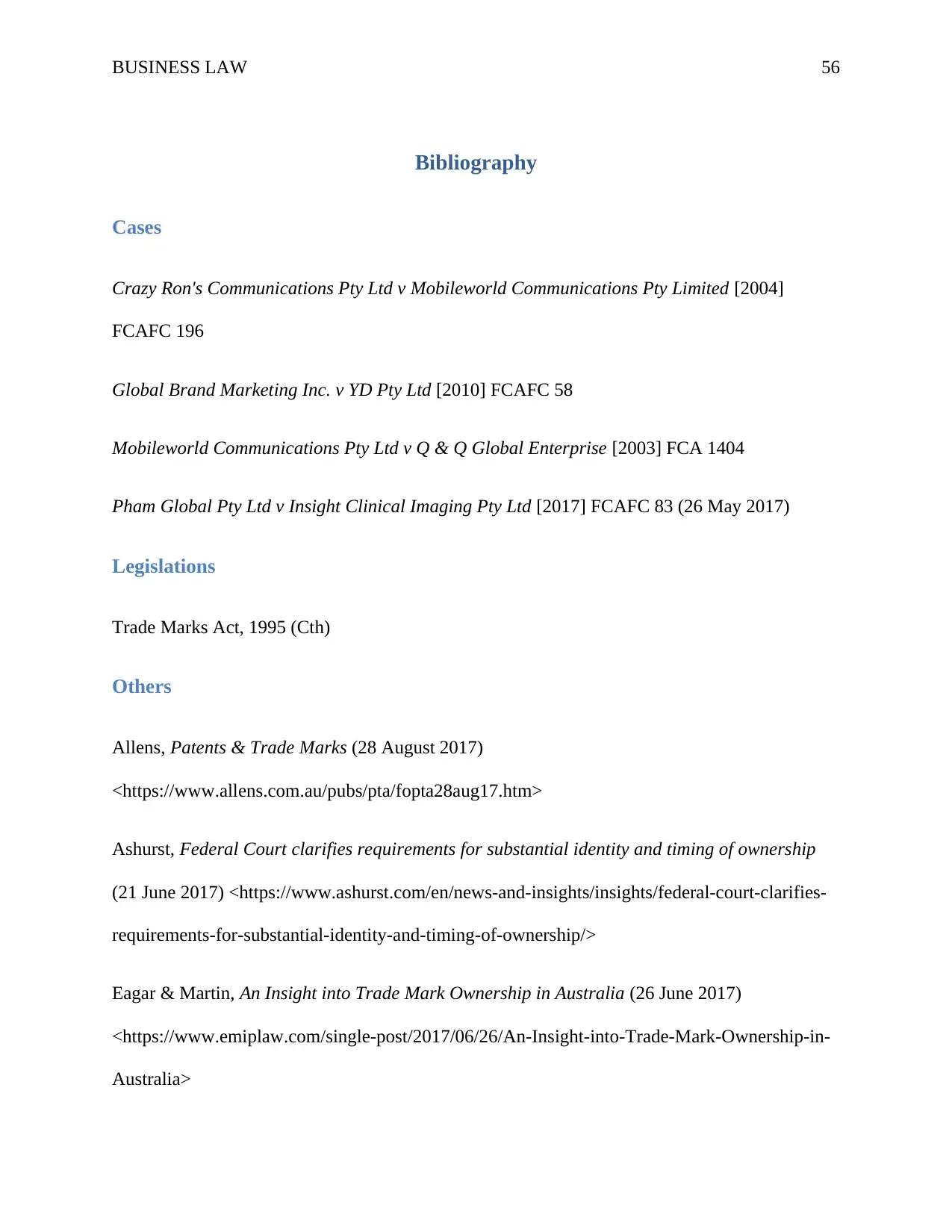
BUSINESS LAW 56
Bibliography
Cases
Crazy Ron's Communications Pty Ltd v Mobileworld Communications Pty Limited [2004]
FCAFC 196
Global Brand Marketing Inc. v YD Pty Ltd [2010] FCAFC 58
Mobileworld Communications Pty Ltd v Q & Q Global Enterprise [2003] FCA 1404
Pham Global Pty Ltd v Insight Clinical Imaging Pty Ltd [2017] FCAFC 83 (26 May 2017)
Legislations
Trade Marks Act, 1995 (Cth)
Others
Allens, Patents & Trade Marks (28 August 2017)
<https://www.allens.com.au/pubs/pta/fopta28aug17.htm>
Ashurst, Federal Court clarifies requirements for substantial identity and timing of ownership
(21 June 2017) <https://www.ashurst.com/en/news-and-insights/insights/federal-court-clarifies-
requirements-for-substantial-identity-and-timing-of-ownership/>
Eagar & Martin, An Insight into Trade Mark Ownership in Australia (26 June 2017)
<https://www.emiplaw.com/single-post/2017/06/26/An-Insight-into-Trade-Mark-Ownership-in-
Australia>
Bibliography
Cases
Crazy Ron's Communications Pty Ltd v Mobileworld Communications Pty Limited [2004]
FCAFC 196
Global Brand Marketing Inc. v YD Pty Ltd [2010] FCAFC 58
Mobileworld Communications Pty Ltd v Q & Q Global Enterprise [2003] FCA 1404
Pham Global Pty Ltd v Insight Clinical Imaging Pty Ltd [2017] FCAFC 83 (26 May 2017)
Legislations
Trade Marks Act, 1995 (Cth)
Others
Allens, Patents & Trade Marks (28 August 2017)
<https://www.allens.com.au/pubs/pta/fopta28aug17.htm>
Ashurst, Federal Court clarifies requirements for substantial identity and timing of ownership
(21 June 2017) <https://www.ashurst.com/en/news-and-insights/insights/federal-court-clarifies-
requirements-for-substantial-identity-and-timing-of-ownership/>
Eagar & Martin, An Insight into Trade Mark Ownership in Australia (26 June 2017)
<https://www.emiplaw.com/single-post/2017/06/26/An-Insight-into-Trade-Mark-Ownership-in-
Australia>
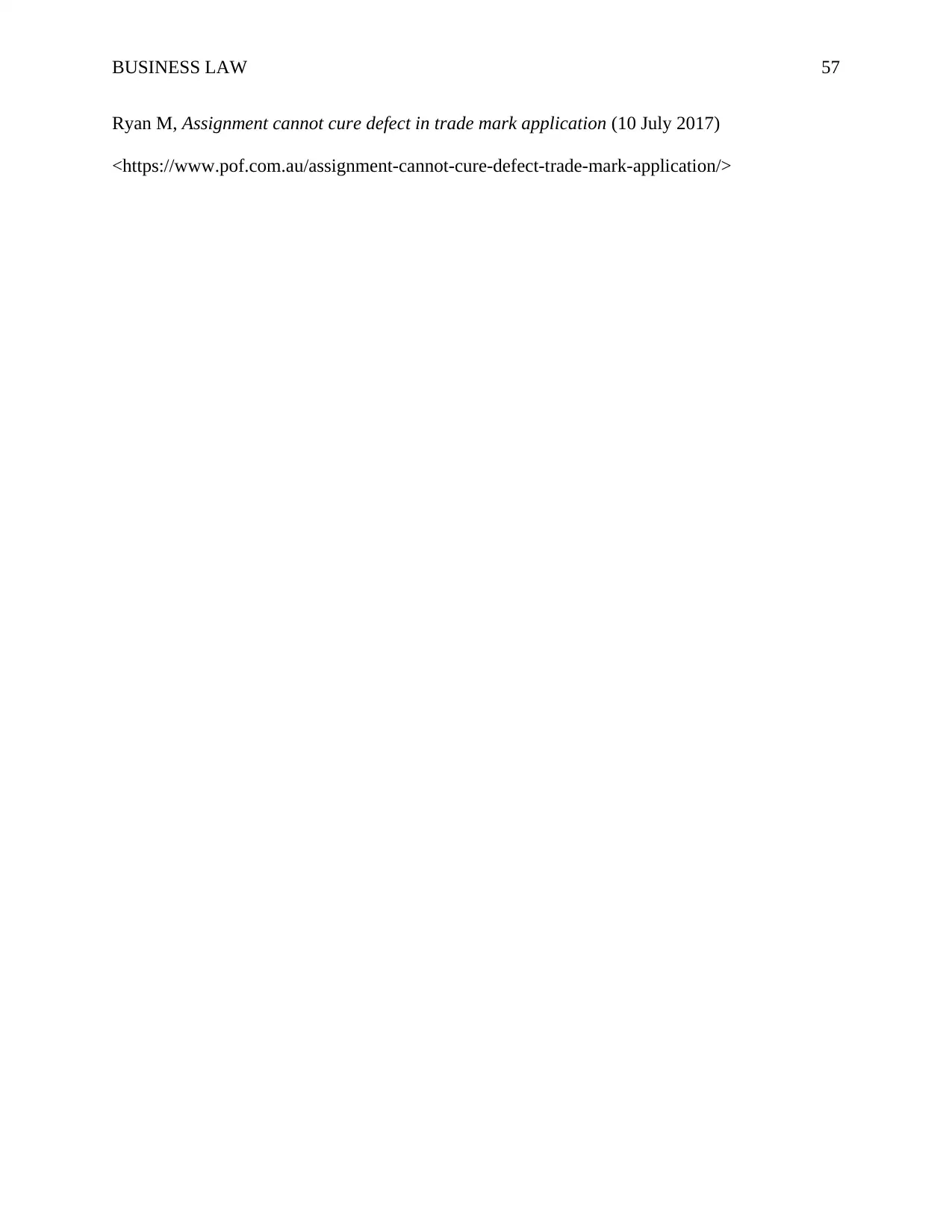
BUSINESS LAW 57
Ryan M, Assignment cannot cure defect in trade mark application (10 July 2017)
<https://www.pof.com.au/assignment-cannot-cure-defect-trade-mark-application/>
Ryan M, Assignment cannot cure defect in trade mark application (10 July 2017)
<https://www.pof.com.au/assignment-cannot-cure-defect-trade-mark-application/>
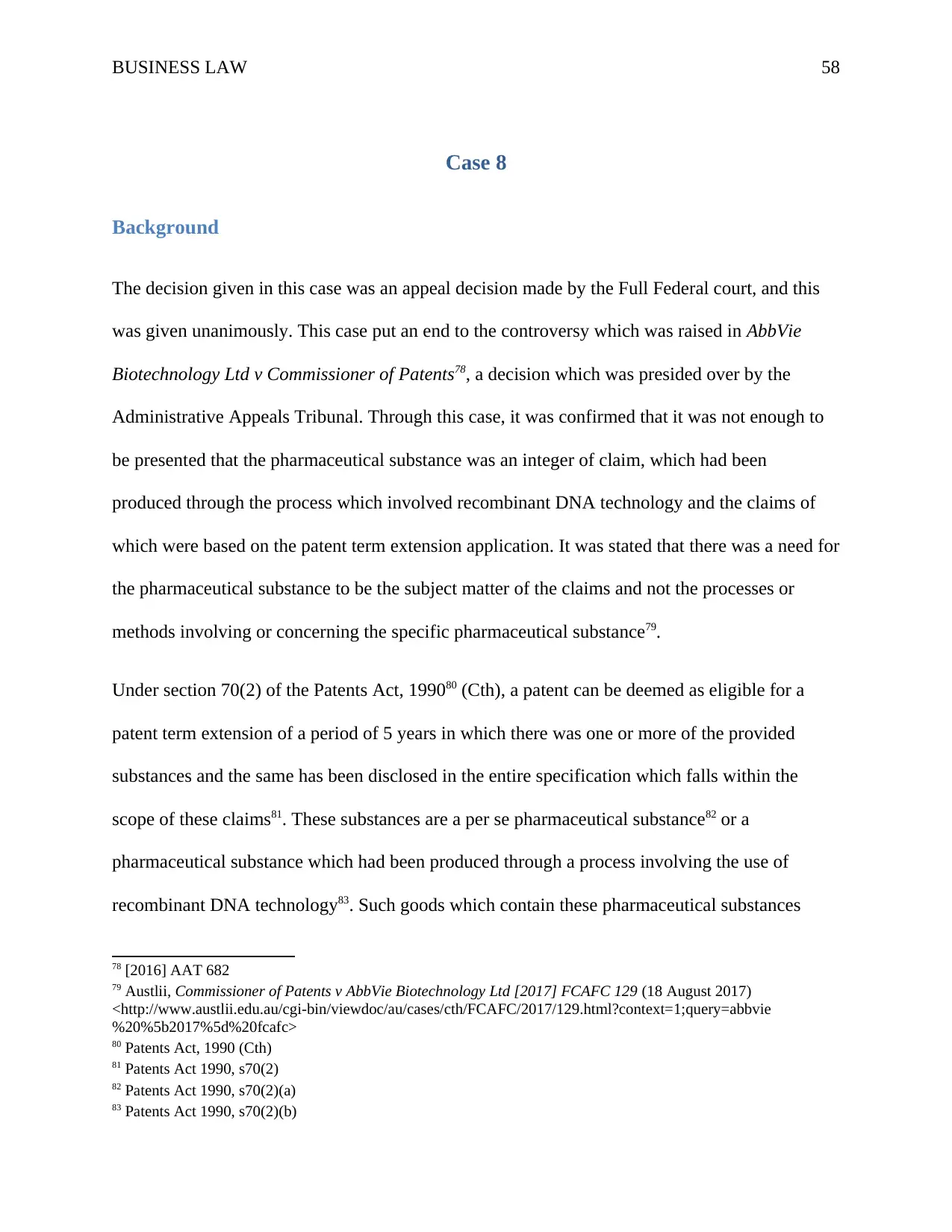
BUSINESS LAW 58
Case 8
Background
The decision given in this case was an appeal decision made by the Full Federal court, and this
was given unanimously. This case put an end to the controversy which was raised in AbbVie
Biotechnology Ltd v Commissioner of Patents78, a decision which was presided over by the
Administrative Appeals Tribunal. Through this case, it was confirmed that it was not enough to
be presented that the pharmaceutical substance was an integer of claim, which had been
produced through the process which involved recombinant DNA technology and the claims of
which were based on the patent term extension application. It was stated that there was a need for
the pharmaceutical substance to be the subject matter of the claims and not the processes or
methods involving or concerning the specific pharmaceutical substance79.
Under section 70(2) of the Patents Act, 199080 (Cth), a patent can be deemed as eligible for a
patent term extension of a period of 5 years in which there was one or more of the provided
substances and the same has been disclosed in the entire specification which falls within the
scope of these claims81. These substances are a per se pharmaceutical substance82 or a
pharmaceutical substance which had been produced through a process involving the use of
recombinant DNA technology83. Such goods which contain these pharmaceutical substances
78 [2016] AAT 682
79 Austlii, Commissioner of Patents v AbbVie Biotechnology Ltd [2017] FCAFC 129 (18 August 2017)
<http://www.austlii.edu.au/cgi-bin/viewdoc/au/cases/cth/FCAFC/2017/129.html?context=1;query=abbvie
%20%5b2017%5d%20fcafc>
80 Patents Act, 1990 (Cth)
81 Patents Act 1990, s70(2)
82 Patents Act 1990, s70(2)(a)
83 Patents Act 1990, s70(2)(b)
Case 8
Background
The decision given in this case was an appeal decision made by the Full Federal court, and this
was given unanimously. This case put an end to the controversy which was raised in AbbVie
Biotechnology Ltd v Commissioner of Patents78, a decision which was presided over by the
Administrative Appeals Tribunal. Through this case, it was confirmed that it was not enough to
be presented that the pharmaceutical substance was an integer of claim, which had been
produced through the process which involved recombinant DNA technology and the claims of
which were based on the patent term extension application. It was stated that there was a need for
the pharmaceutical substance to be the subject matter of the claims and not the processes or
methods involving or concerning the specific pharmaceutical substance79.
Under section 70(2) of the Patents Act, 199080 (Cth), a patent can be deemed as eligible for a
patent term extension of a period of 5 years in which there was one or more of the provided
substances and the same has been disclosed in the entire specification which falls within the
scope of these claims81. These substances are a per se pharmaceutical substance82 or a
pharmaceutical substance which had been produced through a process involving the use of
recombinant DNA technology83. Such goods which contain these pharmaceutical substances
78 [2016] AAT 682
79 Austlii, Commissioner of Patents v AbbVie Biotechnology Ltd [2017] FCAFC 129 (18 August 2017)
<http://www.austlii.edu.au/cgi-bin/viewdoc/au/cases/cth/FCAFC/2017/129.html?context=1;query=abbvie
%20%5b2017%5d%20fcafc>
80 Patents Act, 1990 (Cth)
81 Patents Act 1990, s70(2)
82 Patents Act 1990, s70(2)(a)
83 Patents Act 1990, s70(2)(b)
Secure Best Marks with AI Grader
Need help grading? Try our AI Grader for instant feedback on your assignments.
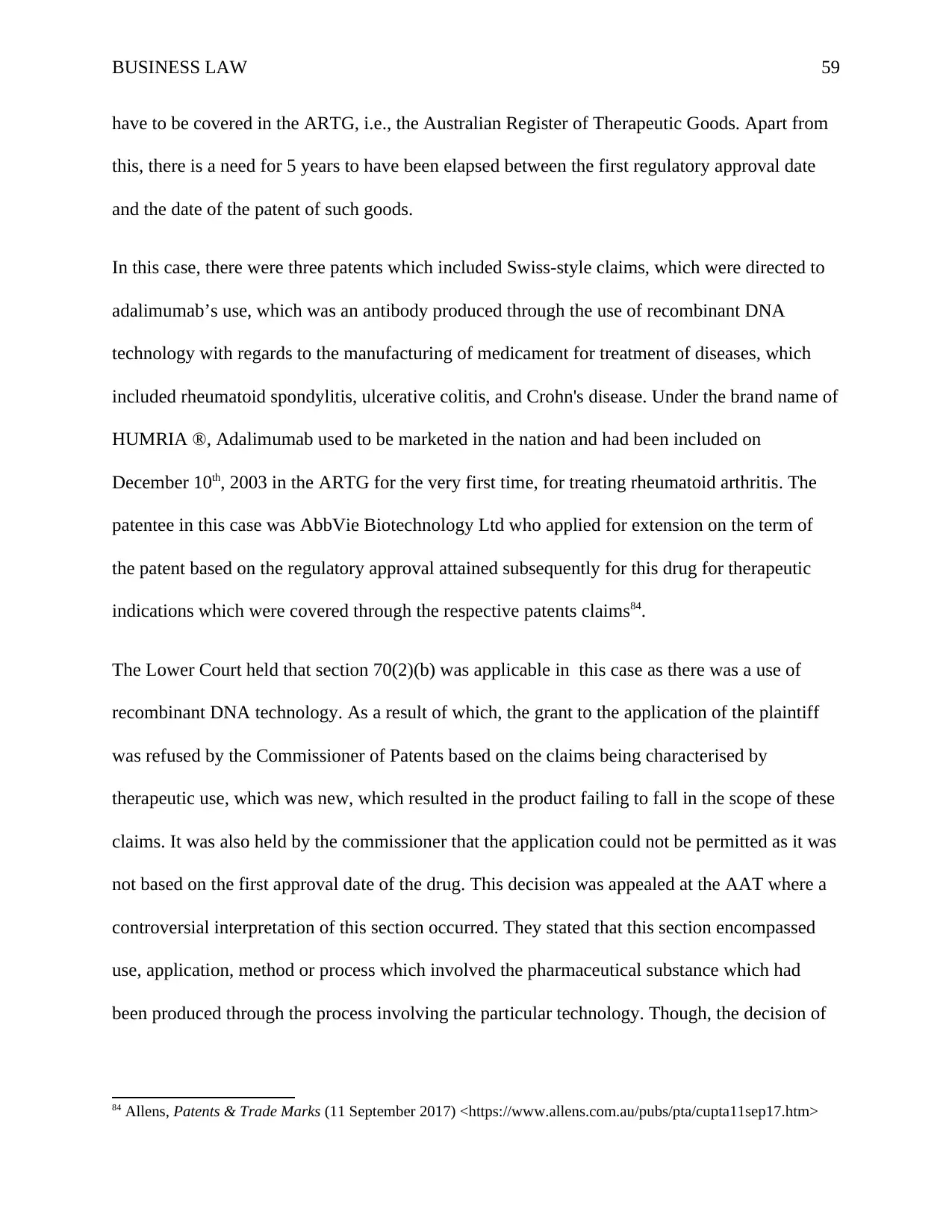
BUSINESS LAW 59
have to be covered in the ARTG, i.e., the Australian Register of Therapeutic Goods. Apart from
this, there is a need for 5 years to have been elapsed between the first regulatory approval date
and the date of the patent of such goods.
In this case, there were three patents which included Swiss-style claims, which were directed to
adalimumab’s use, which was an antibody produced through the use of recombinant DNA
technology with regards to the manufacturing of medicament for treatment of diseases, which
included rheumatoid spondylitis, ulcerative colitis, and Crohn's disease. Under the brand name of
HUMRIA ®, Adalimumab used to be marketed in the nation and had been included on
December 10th, 2003 in the ARTG for the very first time, for treating rheumatoid arthritis. The
patentee in this case was AbbVie Biotechnology Ltd who applied for extension on the term of
the patent based on the regulatory approval attained subsequently for this drug for therapeutic
indications which were covered through the respective patents claims84.
The Lower Court held that section 70(2)(b) was applicable in this case as there was a use of
recombinant DNA technology. As a result of which, the grant to the application of the plaintiff
was refused by the Commissioner of Patents based on the claims being characterised by
therapeutic use, which was new, which resulted in the product failing to fall in the scope of these
claims. It was also held by the commissioner that the application could not be permitted as it was
not based on the first approval date of the drug. This decision was appealed at the AAT where a
controversial interpretation of this section occurred. They stated that this section encompassed
use, application, method or process which involved the pharmaceutical substance which had
been produced through the process involving the particular technology. Though, the decision of
84 Allens, Patents & Trade Marks (11 September 2017) <https://www.allens.com.au/pubs/pta/cupta11sep17.htm>
have to be covered in the ARTG, i.e., the Australian Register of Therapeutic Goods. Apart from
this, there is a need for 5 years to have been elapsed between the first regulatory approval date
and the date of the patent of such goods.
In this case, there were three patents which included Swiss-style claims, which were directed to
adalimumab’s use, which was an antibody produced through the use of recombinant DNA
technology with regards to the manufacturing of medicament for treatment of diseases, which
included rheumatoid spondylitis, ulcerative colitis, and Crohn's disease. Under the brand name of
HUMRIA ®, Adalimumab used to be marketed in the nation and had been included on
December 10th, 2003 in the ARTG for the very first time, for treating rheumatoid arthritis. The
patentee in this case was AbbVie Biotechnology Ltd who applied for extension on the term of
the patent based on the regulatory approval attained subsequently for this drug for therapeutic
indications which were covered through the respective patents claims84.
The Lower Court held that section 70(2)(b) was applicable in this case as there was a use of
recombinant DNA technology. As a result of which, the grant to the application of the plaintiff
was refused by the Commissioner of Patents based on the claims being characterised by
therapeutic use, which was new, which resulted in the product failing to fall in the scope of these
claims. It was also held by the commissioner that the application could not be permitted as it was
not based on the first approval date of the drug. This decision was appealed at the AAT where a
controversial interpretation of this section occurred. They stated that this section encompassed
use, application, method or process which involved the pharmaceutical substance which had
been produced through the process involving the particular technology. Though, the decision of
84 Allens, Patents & Trade Marks (11 September 2017) <https://www.allens.com.au/pubs/pta/cupta11sep17.htm>
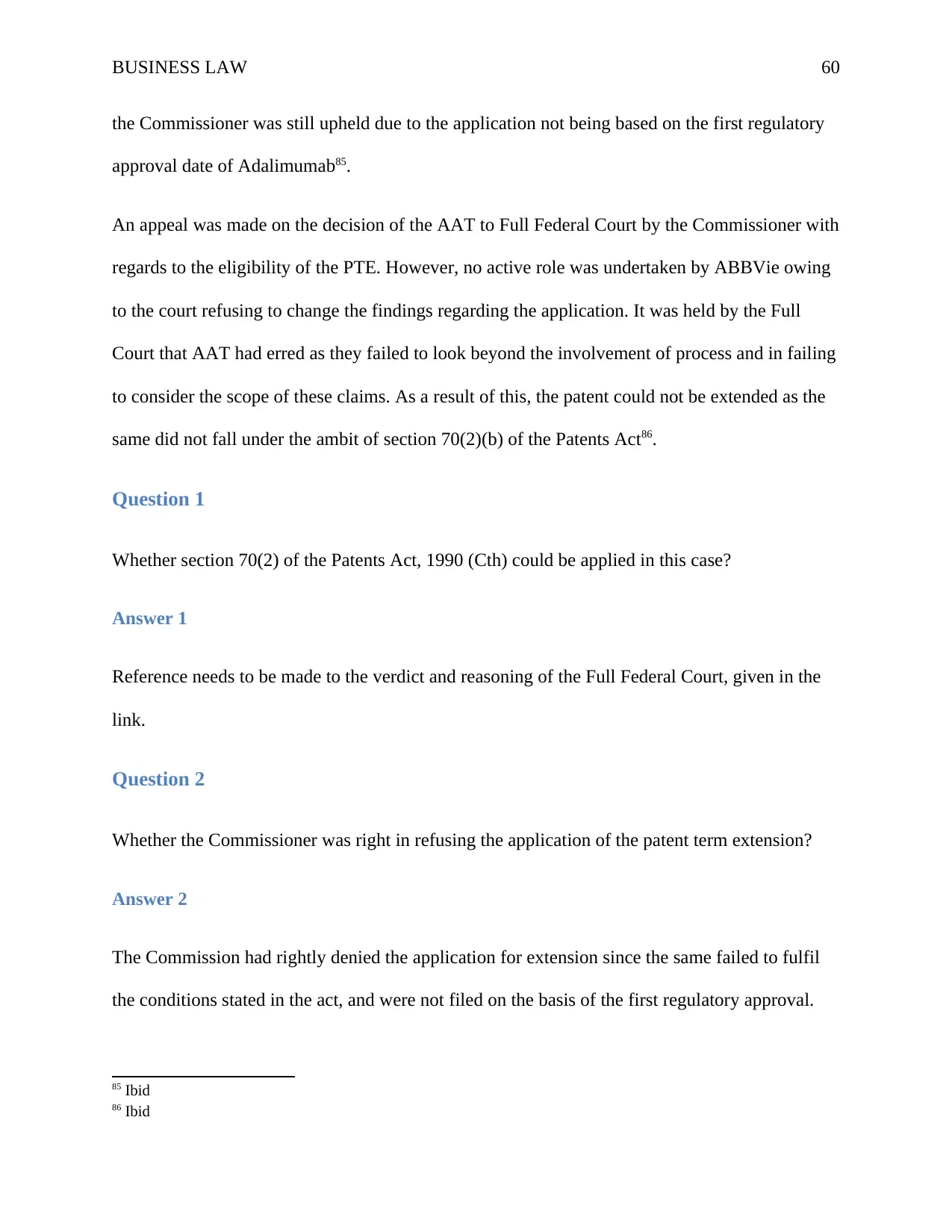
BUSINESS LAW 60
the Commissioner was still upheld due to the application not being based on the first regulatory
approval date of Adalimumab85.
An appeal was made on the decision of the AAT to Full Federal Court by the Commissioner with
regards to the eligibility of the PTE. However, no active role was undertaken by ABBVie owing
to the court refusing to change the findings regarding the application. It was held by the Full
Court that AAT had erred as they failed to look beyond the involvement of process and in failing
to consider the scope of these claims. As a result of this, the patent could not be extended as the
same did not fall under the ambit of section 70(2)(b) of the Patents Act86.
Question 1
Whether section 70(2) of the Patents Act, 1990 (Cth) could be applied in this case?
Answer 1
Reference needs to be made to the verdict and reasoning of the Full Federal Court, given in the
link.
Question 2
Whether the Commissioner was right in refusing the application of the patent term extension?
Answer 2
The Commission had rightly denied the application for extension since the same failed to fulfil
the conditions stated in the act, and were not filed on the basis of the first regulatory approval.
85 Ibid
86 Ibid
the Commissioner was still upheld due to the application not being based on the first regulatory
approval date of Adalimumab85.
An appeal was made on the decision of the AAT to Full Federal Court by the Commissioner with
regards to the eligibility of the PTE. However, no active role was undertaken by ABBVie owing
to the court refusing to change the findings regarding the application. It was held by the Full
Court that AAT had erred as they failed to look beyond the involvement of process and in failing
to consider the scope of these claims. As a result of this, the patent could not be extended as the
same did not fall under the ambit of section 70(2)(b) of the Patents Act86.
Question 1
Whether section 70(2) of the Patents Act, 1990 (Cth) could be applied in this case?
Answer 1
Reference needs to be made to the verdict and reasoning of the Full Federal Court, given in the
link.
Question 2
Whether the Commissioner was right in refusing the application of the patent term extension?
Answer 2
The Commission had rightly denied the application for extension since the same failed to fulfil
the conditions stated in the act, and were not filed on the basis of the first regulatory approval.
85 Ibid
86 Ibid
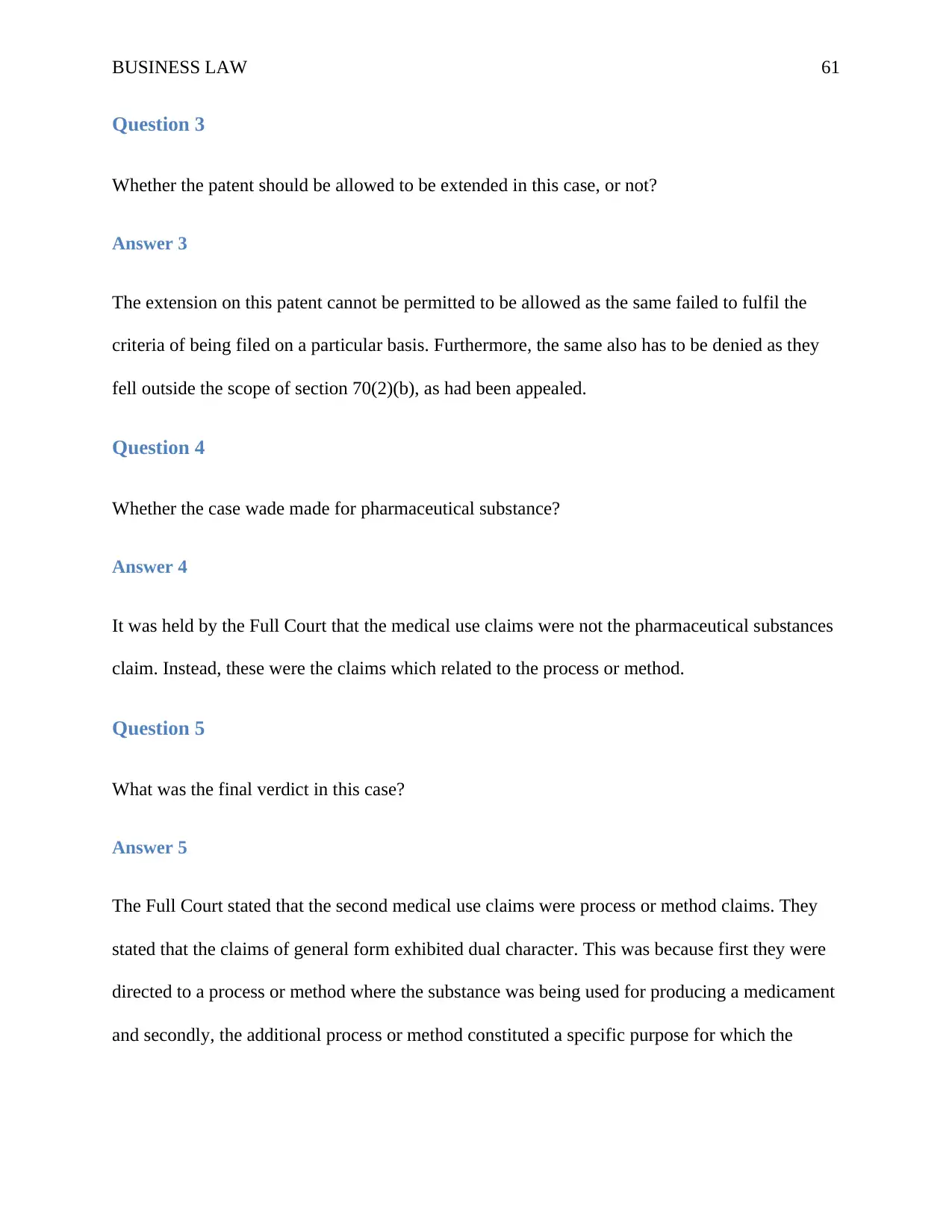
BUSINESS LAW 61
Question 3
Whether the patent should be allowed to be extended in this case, or not?
Answer 3
The extension on this patent cannot be permitted to be allowed as the same failed to fulfil the
criteria of being filed on a particular basis. Furthermore, the same also has to be denied as they
fell outside the scope of section 70(2)(b), as had been appealed.
Question 4
Whether the case wade made for pharmaceutical substance?
Answer 4
It was held by the Full Court that the medical use claims were not the pharmaceutical substances
claim. Instead, these were the claims which related to the process or method.
Question 5
What was the final verdict in this case?
Answer 5
The Full Court stated that the second medical use claims were process or method claims. They
stated that the claims of general form exhibited dual character. This was because first they were
directed to a process or method where the substance was being used for producing a medicament
and secondly, the additional process or method constituted a specific purpose for which the
Question 3
Whether the patent should be allowed to be extended in this case, or not?
Answer 3
The extension on this patent cannot be permitted to be allowed as the same failed to fulfil the
criteria of being filed on a particular basis. Furthermore, the same also has to be denied as they
fell outside the scope of section 70(2)(b), as had been appealed.
Question 4
Whether the case wade made for pharmaceutical substance?
Answer 4
It was held by the Full Court that the medical use claims were not the pharmaceutical substances
claim. Instead, these were the claims which related to the process or method.
Question 5
What was the final verdict in this case?
Answer 5
The Full Court stated that the second medical use claims were process or method claims. They
stated that the claims of general form exhibited dual character. This was because first they were
directed to a process or method where the substance was being used for producing a medicament
and secondly, the additional process or method constituted a specific purpose for which the
Paraphrase This Document
Need a fresh take? Get an instant paraphrase of this document with our AI Paraphraser
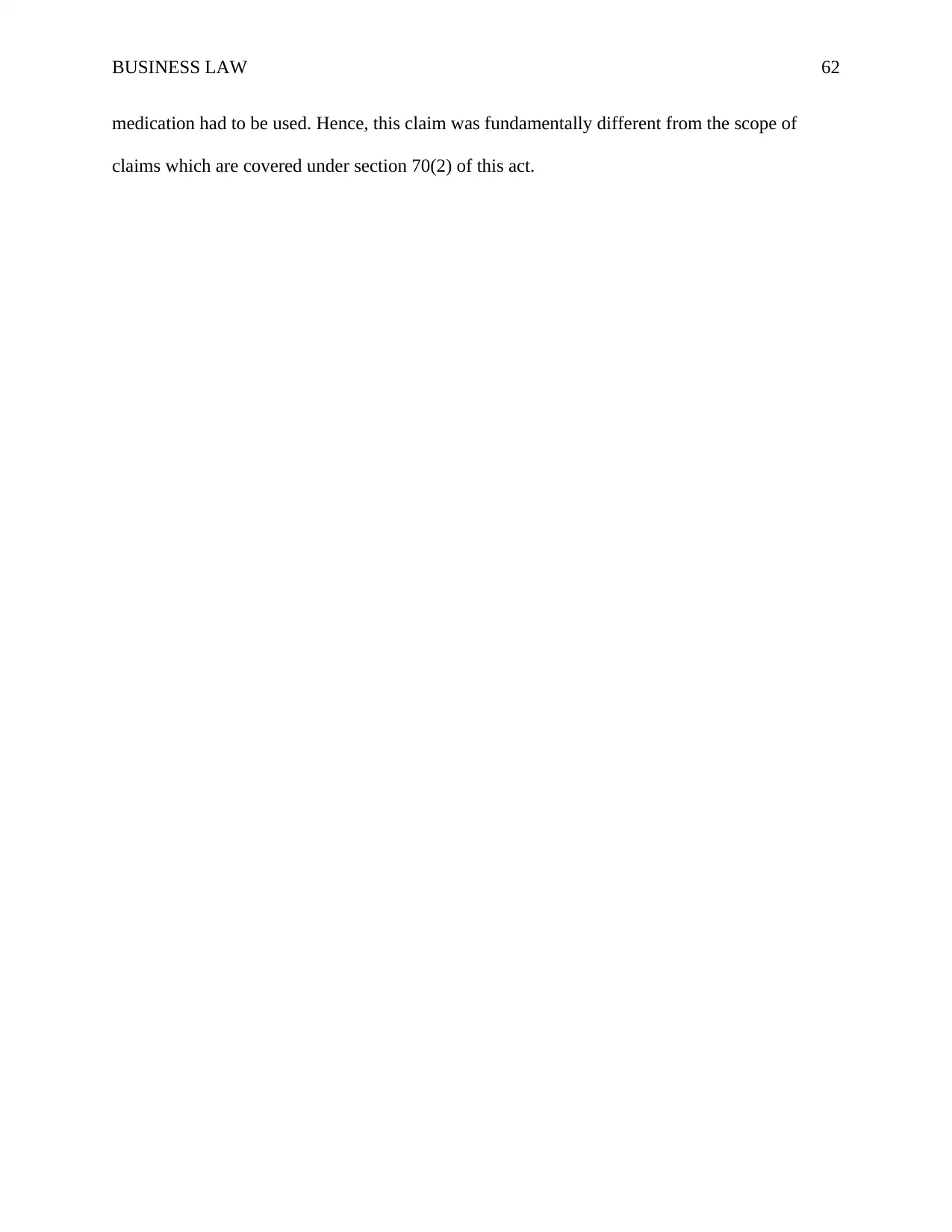
BUSINESS LAW 62
medication had to be used. Hence, this claim was fundamentally different from the scope of
claims which are covered under section 70(2) of this act.
medication had to be used. Hence, this claim was fundamentally different from the scope of
claims which are covered under section 70(2) of this act.

BUSINESS LAW 63
Bibliography
Cases
AbbVie Biotechnology Ltd v Commissioner of Patents [2016] AAT 682
Commissioner of Patents v AbbVie Biotechnology Ltd [2017] FCAFC 129 (18 August 2017)
Legislations
Patents Act, 1990 (Cth)
Others
Austlii, Commissioner of Patents v AbbVie Biotechnology Ltd [2017] FCAFC 129 (18 August
2017) <http://www.austlii.edu.au/cgi-bin/viewdoc/au/cases/cth/FCAFC/2017/129.html?
context=1;query=abbvie%20%5b2017%5d%20fcafc>
Allens, Patents & Trade Marks (11 September 2017)
<https://www.allens.com.au/pubs/pta/cupta11sep17.htm>
Bibliography
Cases
AbbVie Biotechnology Ltd v Commissioner of Patents [2016] AAT 682
Commissioner of Patents v AbbVie Biotechnology Ltd [2017] FCAFC 129 (18 August 2017)
Legislations
Patents Act, 1990 (Cth)
Others
Austlii, Commissioner of Patents v AbbVie Biotechnology Ltd [2017] FCAFC 129 (18 August
2017) <http://www.austlii.edu.au/cgi-bin/viewdoc/au/cases/cth/FCAFC/2017/129.html?
context=1;query=abbvie%20%5b2017%5d%20fcafc>
Allens, Patents & Trade Marks (11 September 2017)
<https://www.allens.com.au/pubs/pta/cupta11sep17.htm>
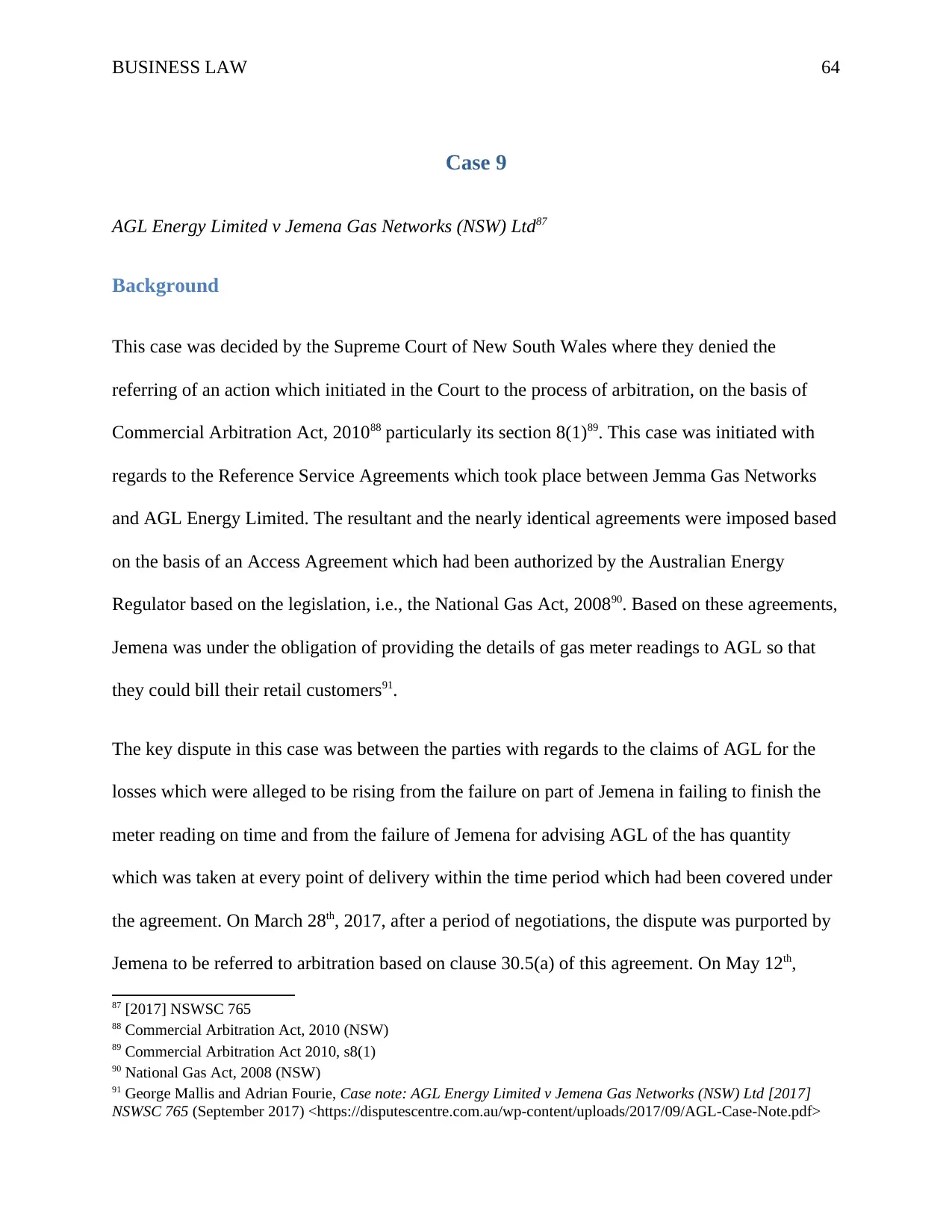
BUSINESS LAW 64
Case 9
AGL Energy Limited v Jemena Gas Networks (NSW) Ltd87
Background
This case was decided by the Supreme Court of New South Wales where they denied the
referring of an action which initiated in the Court to the process of arbitration, on the basis of
Commercial Arbitration Act, 201088 particularly its section 8(1)89. This case was initiated with
regards to the Reference Service Agreements which took place between Jemma Gas Networks
and AGL Energy Limited. The resultant and the nearly identical agreements were imposed based
on the basis of an Access Agreement which had been authorized by the Australian Energy
Regulator based on the legislation, i.e., the National Gas Act, 200890. Based on these agreements,
Jemena was under the obligation of providing the details of gas meter readings to AGL so that
they could bill their retail customers91.
The key dispute in this case was between the parties with regards to the claims of AGL for the
losses which were alleged to be rising from the failure on part of Jemena in failing to finish the
meter reading on time and from the failure of Jemena for advising AGL of the has quantity
which was taken at every point of delivery within the time period which had been covered under
the agreement. On March 28th, 2017, after a period of negotiations, the dispute was purported by
Jemena to be referred to arbitration based on clause 30.5(a) of this agreement. On May 12th,
87 [2017] NSWSC 765
88 Commercial Arbitration Act, 2010 (NSW)
89 Commercial Arbitration Act 2010, s8(1)
90 National Gas Act, 2008 (NSW)
91 George Mallis and Adrian Fourie, Case note: AGL Energy Limited v Jemena Gas Networks (NSW) Ltd [2017]
NSWSC 765 (September 2017) <https://disputescentre.com.au/wp-content/uploads/2017/09/AGL-Case-Note.pdf>
Case 9
AGL Energy Limited v Jemena Gas Networks (NSW) Ltd87
Background
This case was decided by the Supreme Court of New South Wales where they denied the
referring of an action which initiated in the Court to the process of arbitration, on the basis of
Commercial Arbitration Act, 201088 particularly its section 8(1)89. This case was initiated with
regards to the Reference Service Agreements which took place between Jemma Gas Networks
and AGL Energy Limited. The resultant and the nearly identical agreements were imposed based
on the basis of an Access Agreement which had been authorized by the Australian Energy
Regulator based on the legislation, i.e., the National Gas Act, 200890. Based on these agreements,
Jemena was under the obligation of providing the details of gas meter readings to AGL so that
they could bill their retail customers91.
The key dispute in this case was between the parties with regards to the claims of AGL for the
losses which were alleged to be rising from the failure on part of Jemena in failing to finish the
meter reading on time and from the failure of Jemena for advising AGL of the has quantity
which was taken at every point of delivery within the time period which had been covered under
the agreement. On March 28th, 2017, after a period of negotiations, the dispute was purported by
Jemena to be referred to arbitration based on clause 30.5(a) of this agreement. On May 12th,
87 [2017] NSWSC 765
88 Commercial Arbitration Act, 2010 (NSW)
89 Commercial Arbitration Act 2010, s8(1)
90 National Gas Act, 2008 (NSW)
91 George Mallis and Adrian Fourie, Case note: AGL Energy Limited v Jemena Gas Networks (NSW) Ltd [2017]
NSWSC 765 (September 2017) <https://disputescentre.com.au/wp-content/uploads/2017/09/AGL-Case-Note.pdf>
Secure Best Marks with AI Grader
Need help grading? Try our AI Grader for instant feedback on your assignments.
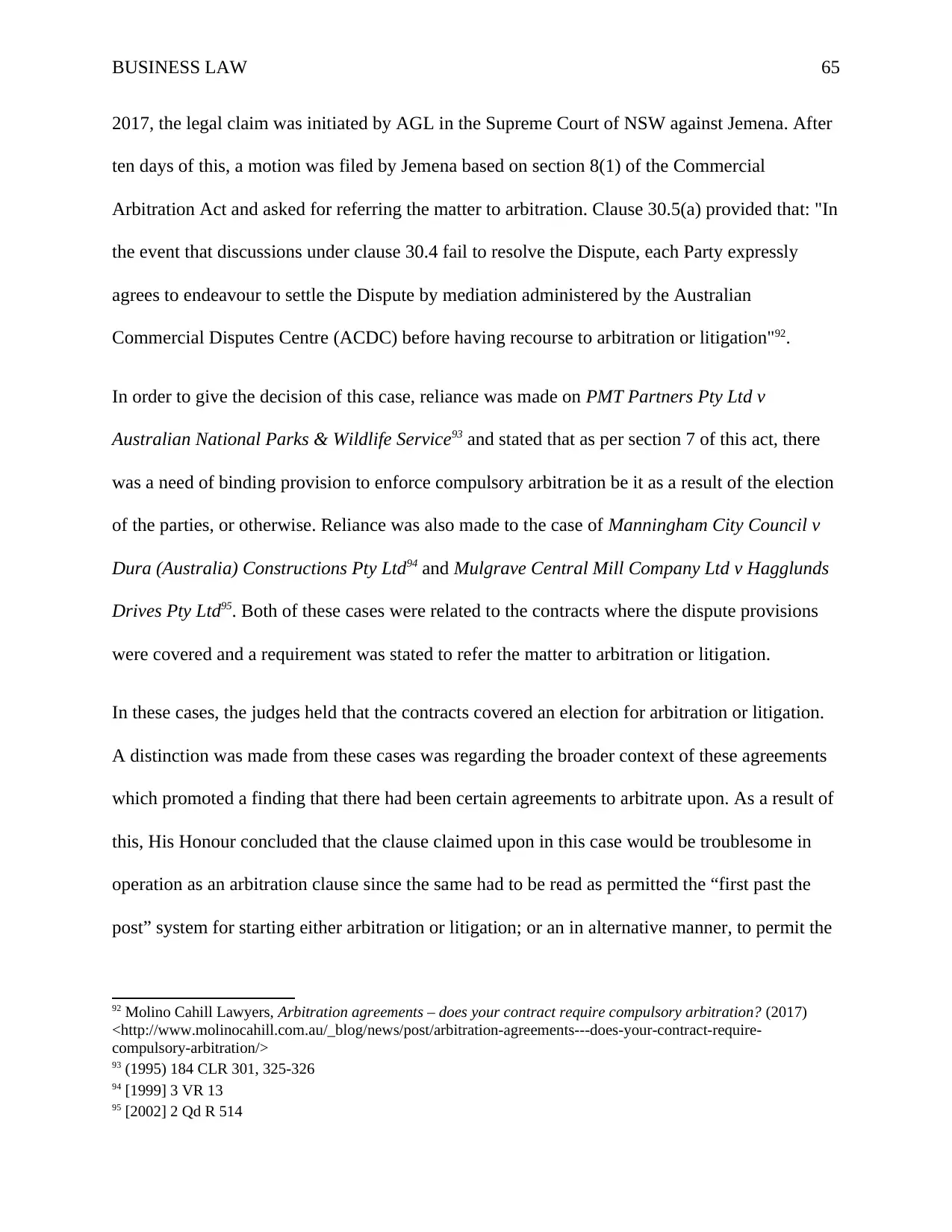
BUSINESS LAW 65
2017, the legal claim was initiated by AGL in the Supreme Court of NSW against Jemena. After
ten days of this, a motion was filed by Jemena based on section 8(1) of the Commercial
Arbitration Act and asked for referring the matter to arbitration. Clause 30.5(a) provided that: "In
the event that discussions under clause 30.4 fail to resolve the Dispute, each Party expressly
agrees to endeavour to settle the Dispute by mediation administered by the Australian
Commercial Disputes Centre (ACDC) before having recourse to arbitration or litigation"92.
In order to give the decision of this case, reliance was made on PMT Partners Pty Ltd v
Australian National Parks & Wildlife Service93 and stated that as per section 7 of this act, there
was a need of binding provision to enforce compulsory arbitration be it as a result of the election
of the parties, or otherwise. Reliance was also made to the case of Manningham City Council v
Dura (Australia) Constructions Pty Ltd94 and Mulgrave Central Mill Company Ltd v Hagglunds
Drives Pty Ltd95. Both of these cases were related to the contracts where the dispute provisions
were covered and a requirement was stated to refer the matter to arbitration or litigation.
In these cases, the judges held that the contracts covered an election for arbitration or litigation.
A distinction was made from these cases was regarding the broader context of these agreements
which promoted a finding that there had been certain agreements to arbitrate upon. As a result of
this, His Honour concluded that the clause claimed upon in this case would be troublesome in
operation as an arbitration clause since the same had to be read as permitted the “first past the
post” system for starting either arbitration or litigation; or an in alternative manner, to permit the
92 Molino Cahill Lawyers, Arbitration agreements – does your contract require compulsory arbitration? (2017)
<http://www.molinocahill.com.au/_blog/news/post/arbitration-agreements---does-your-contract-require-
compulsory-arbitration/>
93 (1995) 184 CLR 301, 325-326
94 [1999] 3 VR 13
95 [2002] 2 Qd R 514
2017, the legal claim was initiated by AGL in the Supreme Court of NSW against Jemena. After
ten days of this, a motion was filed by Jemena based on section 8(1) of the Commercial
Arbitration Act and asked for referring the matter to arbitration. Clause 30.5(a) provided that: "In
the event that discussions under clause 30.4 fail to resolve the Dispute, each Party expressly
agrees to endeavour to settle the Dispute by mediation administered by the Australian
Commercial Disputes Centre (ACDC) before having recourse to arbitration or litigation"92.
In order to give the decision of this case, reliance was made on PMT Partners Pty Ltd v
Australian National Parks & Wildlife Service93 and stated that as per section 7 of this act, there
was a need of binding provision to enforce compulsory arbitration be it as a result of the election
of the parties, or otherwise. Reliance was also made to the case of Manningham City Council v
Dura (Australia) Constructions Pty Ltd94 and Mulgrave Central Mill Company Ltd v Hagglunds
Drives Pty Ltd95. Both of these cases were related to the contracts where the dispute provisions
were covered and a requirement was stated to refer the matter to arbitration or litigation.
In these cases, the judges held that the contracts covered an election for arbitration or litigation.
A distinction was made from these cases was regarding the broader context of these agreements
which promoted a finding that there had been certain agreements to arbitrate upon. As a result of
this, His Honour concluded that the clause claimed upon in this case would be troublesome in
operation as an arbitration clause since the same had to be read as permitted the “first past the
post” system for starting either arbitration or litigation; or an in alternative manner, to permit the
92 Molino Cahill Lawyers, Arbitration agreements – does your contract require compulsory arbitration? (2017)
<http://www.molinocahill.com.au/_blog/news/post/arbitration-agreements---does-your-contract-require-
compulsory-arbitration/>
93 (1995) 184 CLR 301, 325-326
94 [1999] 3 VR 13
95 [2002] 2 Qd R 514
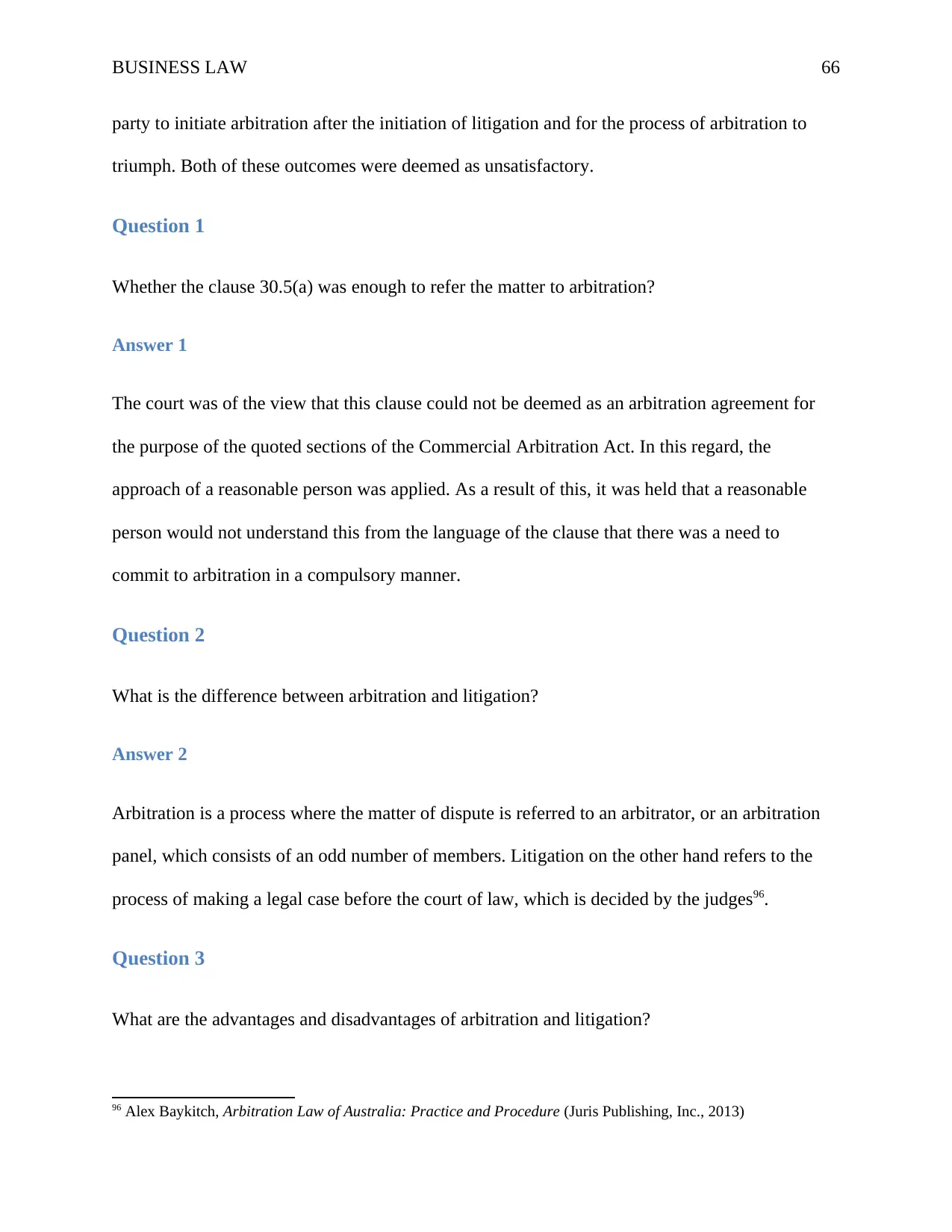
BUSINESS LAW 66
party to initiate arbitration after the initiation of litigation and for the process of arbitration to
triumph. Both of these outcomes were deemed as unsatisfactory.
Question 1
Whether the clause 30.5(a) was enough to refer the matter to arbitration?
Answer 1
The court was of the view that this clause could not be deemed as an arbitration agreement for
the purpose of the quoted sections of the Commercial Arbitration Act. In this regard, the
approach of a reasonable person was applied. As a result of this, it was held that a reasonable
person would not understand this from the language of the clause that there was a need to
commit to arbitration in a compulsory manner.
Question 2
What is the difference between arbitration and litigation?
Answer 2
Arbitration is a process where the matter of dispute is referred to an arbitrator, or an arbitration
panel, which consists of an odd number of members. Litigation on the other hand refers to the
process of making a legal case before the court of law, which is decided by the judges96.
Question 3
What are the advantages and disadvantages of arbitration and litigation?
96 Alex Baykitch, Arbitration Law of Australia: Practice and Procedure (Juris Publishing, Inc., 2013)
party to initiate arbitration after the initiation of litigation and for the process of arbitration to
triumph. Both of these outcomes were deemed as unsatisfactory.
Question 1
Whether the clause 30.5(a) was enough to refer the matter to arbitration?
Answer 1
The court was of the view that this clause could not be deemed as an arbitration agreement for
the purpose of the quoted sections of the Commercial Arbitration Act. In this regard, the
approach of a reasonable person was applied. As a result of this, it was held that a reasonable
person would not understand this from the language of the clause that there was a need to
commit to arbitration in a compulsory manner.
Question 2
What is the difference between arbitration and litigation?
Answer 2
Arbitration is a process where the matter of dispute is referred to an arbitrator, or an arbitration
panel, which consists of an odd number of members. Litigation on the other hand refers to the
process of making a legal case before the court of law, which is decided by the judges96.
Question 3
What are the advantages and disadvantages of arbitration and litigation?
96 Alex Baykitch, Arbitration Law of Australia: Practice and Procedure (Juris Publishing, Inc., 2013)
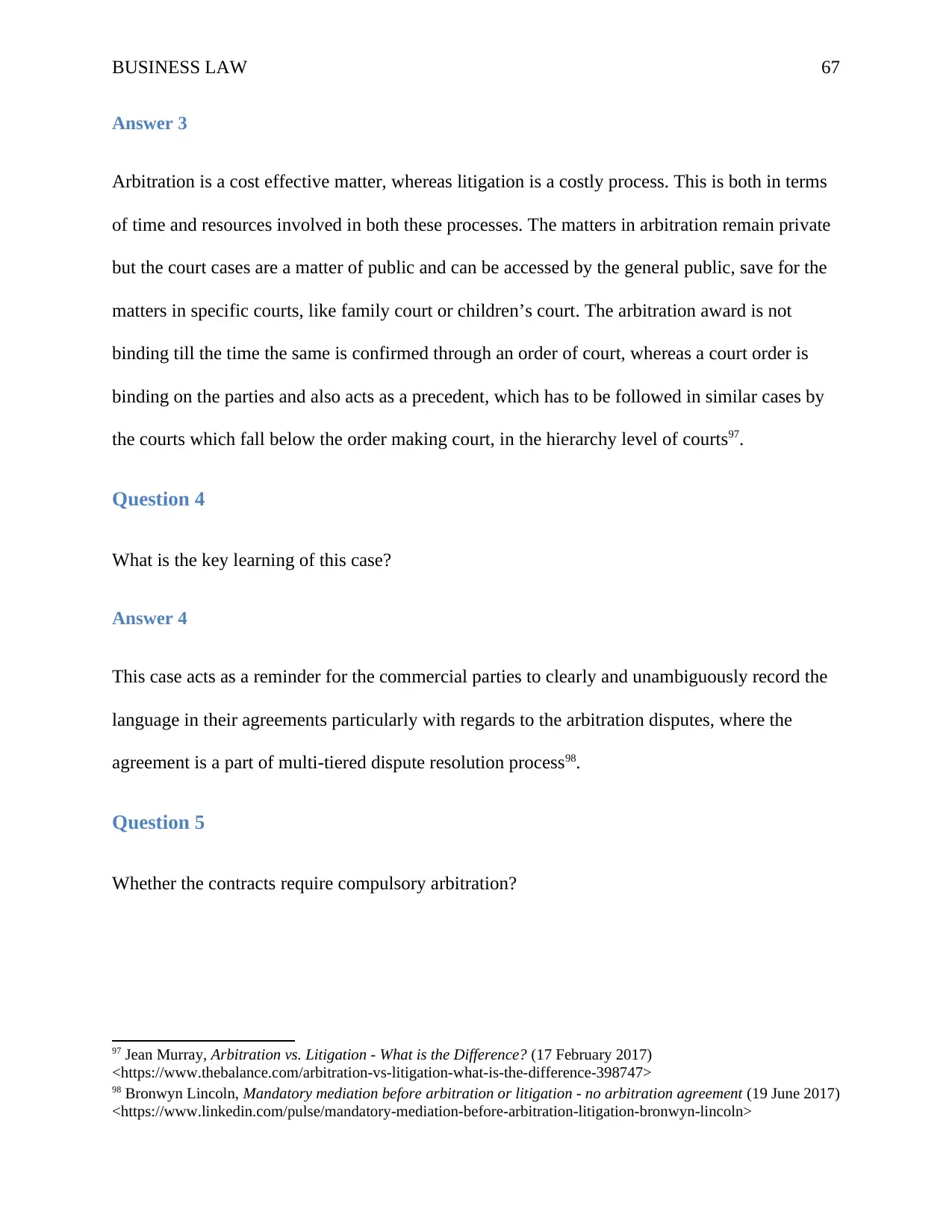
BUSINESS LAW 67
Answer 3
Arbitration is a cost effective matter, whereas litigation is a costly process. This is both in terms
of time and resources involved in both these processes. The matters in arbitration remain private
but the court cases are a matter of public and can be accessed by the general public, save for the
matters in specific courts, like family court or children’s court. The arbitration award is not
binding till the time the same is confirmed through an order of court, whereas a court order is
binding on the parties and also acts as a precedent, which has to be followed in similar cases by
the courts which fall below the order making court, in the hierarchy level of courts97.
Question 4
What is the key learning of this case?
Answer 4
This case acts as a reminder for the commercial parties to clearly and unambiguously record the
language in their agreements particularly with regards to the arbitration disputes, where the
agreement is a part of multi-tiered dispute resolution process98.
Question 5
Whether the contracts require compulsory arbitration?
97 Jean Murray, Arbitration vs. Litigation - What is the Difference? (17 February 2017)
<https://www.thebalance.com/arbitration-vs-litigation-what-is-the-difference-398747>
98 Bronwyn Lincoln, Mandatory mediation before arbitration or litigation - no arbitration agreement (19 June 2017)
<https://www.linkedin.com/pulse/mandatory-mediation-before-arbitration-litigation-bronwyn-lincoln>
Answer 3
Arbitration is a cost effective matter, whereas litigation is a costly process. This is both in terms
of time and resources involved in both these processes. The matters in arbitration remain private
but the court cases are a matter of public and can be accessed by the general public, save for the
matters in specific courts, like family court or children’s court. The arbitration award is not
binding till the time the same is confirmed through an order of court, whereas a court order is
binding on the parties and also acts as a precedent, which has to be followed in similar cases by
the courts which fall below the order making court, in the hierarchy level of courts97.
Question 4
What is the key learning of this case?
Answer 4
This case acts as a reminder for the commercial parties to clearly and unambiguously record the
language in their agreements particularly with regards to the arbitration disputes, where the
agreement is a part of multi-tiered dispute resolution process98.
Question 5
Whether the contracts require compulsory arbitration?
97 Jean Murray, Arbitration vs. Litigation - What is the Difference? (17 February 2017)
<https://www.thebalance.com/arbitration-vs-litigation-what-is-the-difference-398747>
98 Bronwyn Lincoln, Mandatory mediation before arbitration or litigation - no arbitration agreement (19 June 2017)
<https://www.linkedin.com/pulse/mandatory-mediation-before-arbitration-litigation-bronwyn-lincoln>
Paraphrase This Document
Need a fresh take? Get an instant paraphrase of this document with our AI Paraphraser
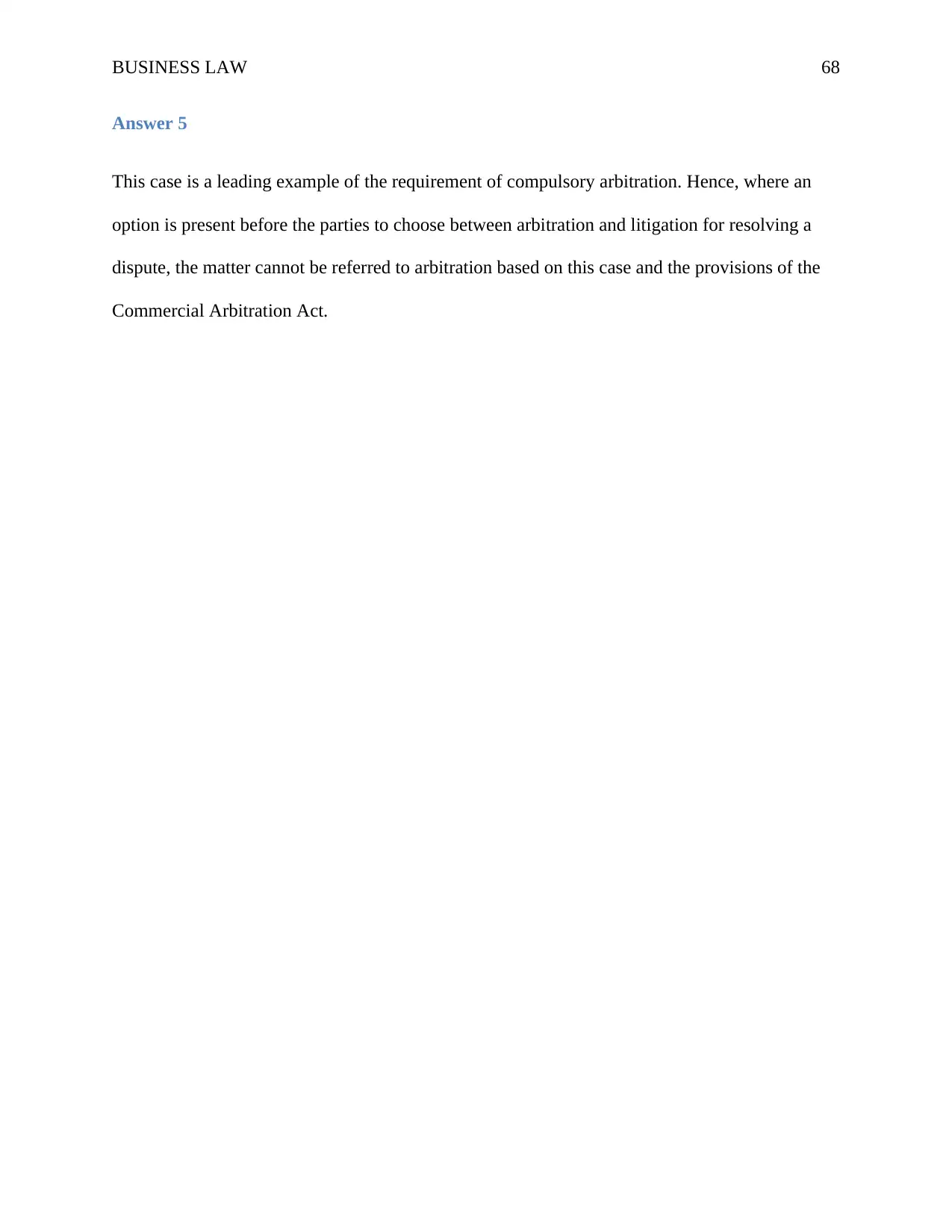
BUSINESS LAW 68
Answer 5
This case is a leading example of the requirement of compulsory arbitration. Hence, where an
option is present before the parties to choose between arbitration and litigation for resolving a
dispute, the matter cannot be referred to arbitration based on this case and the provisions of the
Commercial Arbitration Act.
Answer 5
This case is a leading example of the requirement of compulsory arbitration. Hence, where an
option is present before the parties to choose between arbitration and litigation for resolving a
dispute, the matter cannot be referred to arbitration based on this case and the provisions of the
Commercial Arbitration Act.

BUSINESS LAW 69
Bibliography
Books
Baykitch A, Arbitration Law of Australia: Practice and Procedure (Juris Publishing, Inc., 2013)
Cases
AGL Energy Limited v Jemena Gas Networks (NSW) Ltd [2017] NSWSC 765
Manningham City Council v Dura (Australia) Constructions Pty Ltd [1999] 3 VR 13
Mulgrave Central Mill Company Ltd v Hagglunds Drives Pty Ltd [2002] 2 Qd R 514
PMT Partners Pty Ltd v Australian National Parks & Wildlife Service (1995) 184 CLR 301, 325-
326
Legislations
Commercial Arbitration Act, 2010 (NSW)
National Gas Act, 2008 (NSW)
Others
Lincoln B, Mandatory mediation before arbitration or litigation - no arbitration agreement (19
June 2017) <https://www.linkedin.com/pulse/mandatory-mediation-before-arbitration-litigation-
bronwyn-lincoln>
Bibliography
Books
Baykitch A, Arbitration Law of Australia: Practice and Procedure (Juris Publishing, Inc., 2013)
Cases
AGL Energy Limited v Jemena Gas Networks (NSW) Ltd [2017] NSWSC 765
Manningham City Council v Dura (Australia) Constructions Pty Ltd [1999] 3 VR 13
Mulgrave Central Mill Company Ltd v Hagglunds Drives Pty Ltd [2002] 2 Qd R 514
PMT Partners Pty Ltd v Australian National Parks & Wildlife Service (1995) 184 CLR 301, 325-
326
Legislations
Commercial Arbitration Act, 2010 (NSW)
National Gas Act, 2008 (NSW)
Others
Lincoln B, Mandatory mediation before arbitration or litigation - no arbitration agreement (19
June 2017) <https://www.linkedin.com/pulse/mandatory-mediation-before-arbitration-litigation-
bronwyn-lincoln>
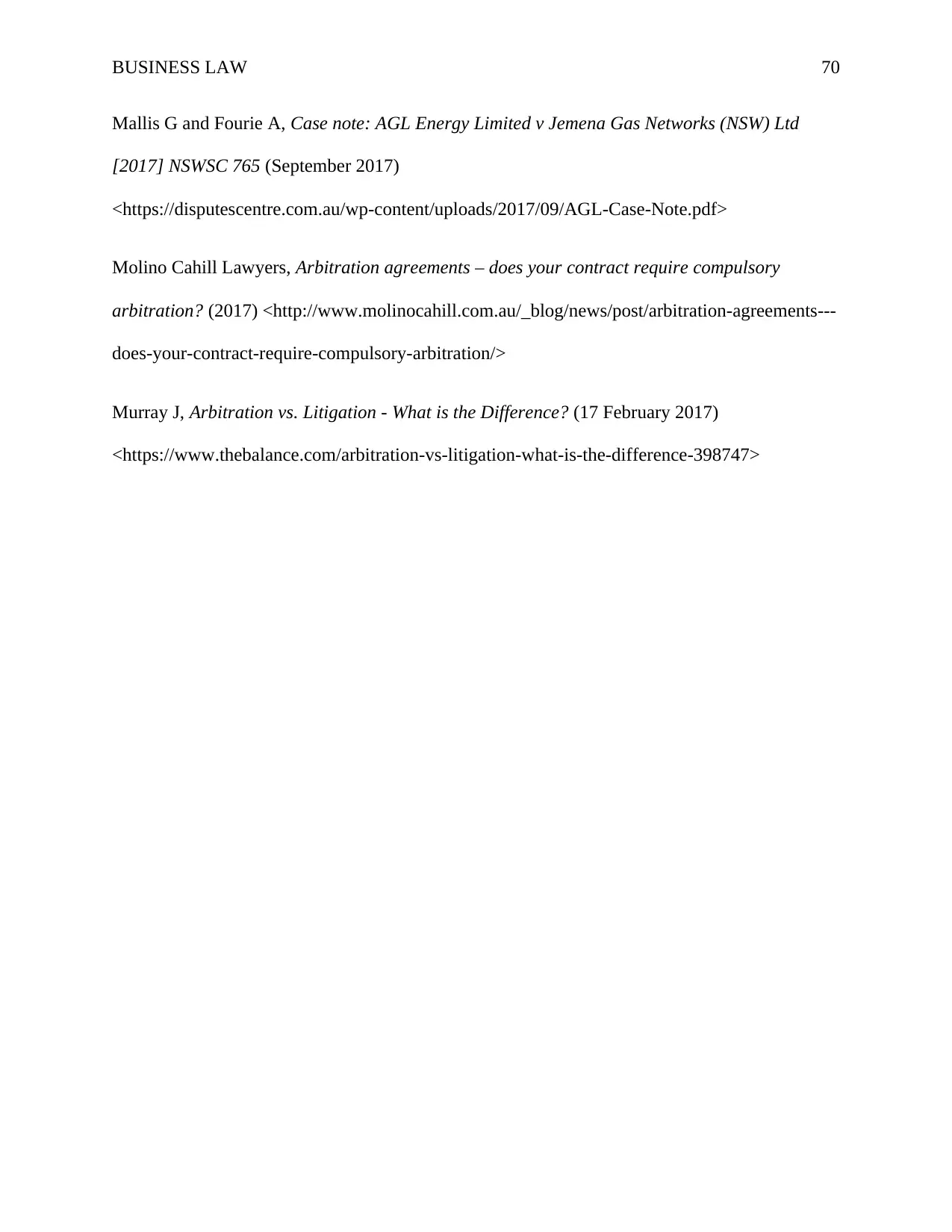
BUSINESS LAW 70
Mallis G and Fourie A, Case note: AGL Energy Limited v Jemena Gas Networks (NSW) Ltd
[2017] NSWSC 765 (September 2017)
<https://disputescentre.com.au/wp-content/uploads/2017/09/AGL-Case-Note.pdf>
Molino Cahill Lawyers, Arbitration agreements – does your contract require compulsory
arbitration? (2017) <http://www.molinocahill.com.au/_blog/news/post/arbitration-agreements---
does-your-contract-require-compulsory-arbitration/>
Murray J, Arbitration vs. Litigation - What is the Difference? (17 February 2017)
<https://www.thebalance.com/arbitration-vs-litigation-what-is-the-difference-398747>
Mallis G and Fourie A, Case note: AGL Energy Limited v Jemena Gas Networks (NSW) Ltd
[2017] NSWSC 765 (September 2017)
<https://disputescentre.com.au/wp-content/uploads/2017/09/AGL-Case-Note.pdf>
Molino Cahill Lawyers, Arbitration agreements – does your contract require compulsory
arbitration? (2017) <http://www.molinocahill.com.au/_blog/news/post/arbitration-agreements---
does-your-contract-require-compulsory-arbitration/>
Murray J, Arbitration vs. Litigation - What is the Difference? (17 February 2017)
<https://www.thebalance.com/arbitration-vs-litigation-what-is-the-difference-398747>
Secure Best Marks with AI Grader
Need help grading? Try our AI Grader for instant feedback on your assignments.
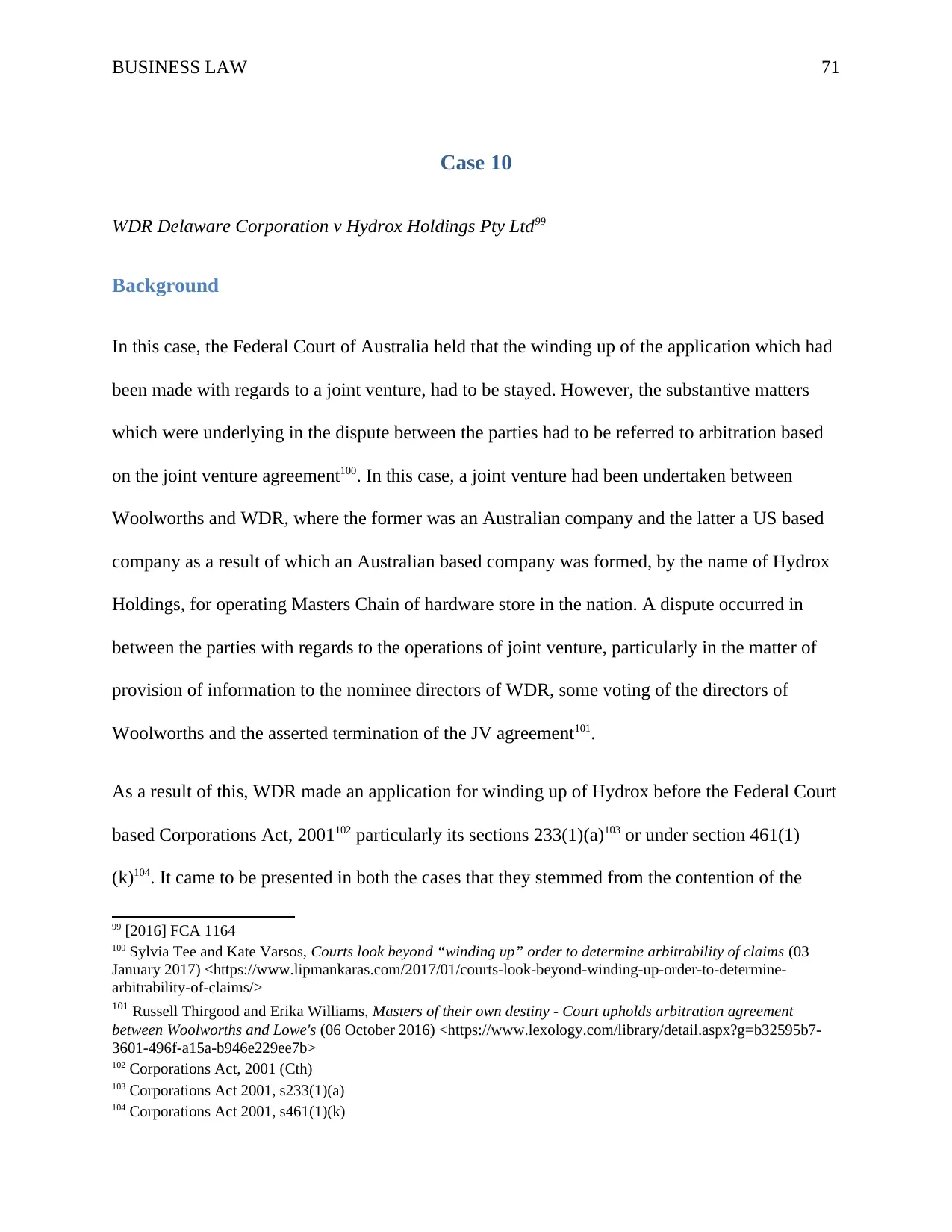
BUSINESS LAW 71
Case 10
WDR Delaware Corporation v Hydrox Holdings Pty Ltd99
Background
In this case, the Federal Court of Australia held that the winding up of the application which had
been made with regards to a joint venture, had to be stayed. However, the substantive matters
which were underlying in the dispute between the parties had to be referred to arbitration based
on the joint venture agreement100. In this case, a joint venture had been undertaken between
Woolworths and WDR, where the former was an Australian company and the latter a US based
company as a result of which an Australian based company was formed, by the name of Hydrox
Holdings, for operating Masters Chain of hardware store in the nation. A dispute occurred in
between the parties with regards to the operations of joint venture, particularly in the matter of
provision of information to the nominee directors of WDR, some voting of the directors of
Woolworths and the asserted termination of the JV agreement101.
As a result of this, WDR made an application for winding up of Hydrox before the Federal Court
based Corporations Act, 2001102 particularly its sections 233(1)(a)103 or under section 461(1)
(k)104. It came to be presented in both the cases that they stemmed from the contention of the
99 [2016] FCA 1164
100 Sylvia Tee and Kate Varsos, Courts look beyond “winding up” order to determine arbitrability of claims (03
January 2017) <https://www.lipmankaras.com/2017/01/courts-look-beyond-winding-up-order-to-determine-
arbitrability-of-claims/>
101 Russell Thirgood and Erika Williams, Masters of their own destiny - Court upholds arbitration agreement
between Woolworths and Lowe's (06 October 2016) <https://www.lexology.com/library/detail.aspx?g=b32595b7-
3601-496f-a15a-b946e229ee7b>
102 Corporations Act, 2001 (Cth)
103 Corporations Act 2001, s233(1)(a)
104 Corporations Act 2001, s461(1)(k)
Case 10
WDR Delaware Corporation v Hydrox Holdings Pty Ltd99
Background
In this case, the Federal Court of Australia held that the winding up of the application which had
been made with regards to a joint venture, had to be stayed. However, the substantive matters
which were underlying in the dispute between the parties had to be referred to arbitration based
on the joint venture agreement100. In this case, a joint venture had been undertaken between
Woolworths and WDR, where the former was an Australian company and the latter a US based
company as a result of which an Australian based company was formed, by the name of Hydrox
Holdings, for operating Masters Chain of hardware store in the nation. A dispute occurred in
between the parties with regards to the operations of joint venture, particularly in the matter of
provision of information to the nominee directors of WDR, some voting of the directors of
Woolworths and the asserted termination of the JV agreement101.
As a result of this, WDR made an application for winding up of Hydrox before the Federal Court
based Corporations Act, 2001102 particularly its sections 233(1)(a)103 or under section 461(1)
(k)104. It came to be presented in both the cases that they stemmed from the contention of the
99 [2016] FCA 1164
100 Sylvia Tee and Kate Varsos, Courts look beyond “winding up” order to determine arbitrability of claims (03
January 2017) <https://www.lipmankaras.com/2017/01/courts-look-beyond-winding-up-order-to-determine-
arbitrability-of-claims/>
101 Russell Thirgood and Erika Williams, Masters of their own destiny - Court upholds arbitration agreement
between Woolworths and Lowe's (06 October 2016) <https://www.lexology.com/library/detail.aspx?g=b32595b7-
3601-496f-a15a-b946e229ee7b>
102 Corporations Act, 2001 (Cth)
103 Corporations Act 2001, s233(1)(a)
104 Corporations Act 2001, s461(1)(k)

BUSINESS LAW 72
party regarding the conduct of affairs of Hydrox being oppressive, or unfairly discriminatory/
prejudicial against WDR, as they were a shareholder of this company. Woolworths attempted to
get a stay on this winding up process and stated that the dispute was between WDR and
Woolworths and hence, the same had to be determined on the basis of arbitration based on article
8(1) the UNCITRAL Model Law on International Commercial Arbitration or section 7(2)
International Arbitration Act 1974 (Cth)105.
Based on section 7(2), the court had to stay the court proceedings in between the arbitration
agreement where the proceedings covered determination of such a matter which could be
deemed as capable of being settled through arbitration. However, the claim made by WDR was
that the proceedings were not arbitrable as only the winding up matter had to be decided on
statutory basis. It was also claimed that winding up could not be arbitrated since the legal status
of a company is affected here which results in third parties being affected. This meant that this
subject only vested with the governmental authority for upholding the public interest in order to
make certain that the proper steps had been taken in fulfilling the liquidation process. The
purpose of International Arbitration Act’s section 7(2) was deemed to have been exceeded in the
made claims, as per Woolworths. It was argued that the matter had factual and legal disputes
making it arbitrable106.
The court was in agreement with the analysis of Woolworths regarding a majority of matters. It
was held that these were not enough grounds to wind up Hydrox and were breaches of contract,
wrongful conduct in asserting the termination of JV agreement in bad faith and on such grounds
which failed to justify the termination and lastly, wrongful conduct with regards to the sense of
105 Herbert Smith Freehills LLP, Australian Federal Court Stays Winding Up Application To Allow Arbitration Of
Underlying Dispute (01 February 2017) <http://hsfnotes.com/arbitration/2017/02/01/australian-federal-court-stays-
winding-up-application-to-allow-arbitration-of-underlying-dispute/>
106 Ibid
party regarding the conduct of affairs of Hydrox being oppressive, or unfairly discriminatory/
prejudicial against WDR, as they were a shareholder of this company. Woolworths attempted to
get a stay on this winding up process and stated that the dispute was between WDR and
Woolworths and hence, the same had to be determined on the basis of arbitration based on article
8(1) the UNCITRAL Model Law on International Commercial Arbitration or section 7(2)
International Arbitration Act 1974 (Cth)105.
Based on section 7(2), the court had to stay the court proceedings in between the arbitration
agreement where the proceedings covered determination of such a matter which could be
deemed as capable of being settled through arbitration. However, the claim made by WDR was
that the proceedings were not arbitrable as only the winding up matter had to be decided on
statutory basis. It was also claimed that winding up could not be arbitrated since the legal status
of a company is affected here which results in third parties being affected. This meant that this
subject only vested with the governmental authority for upholding the public interest in order to
make certain that the proper steps had been taken in fulfilling the liquidation process. The
purpose of International Arbitration Act’s section 7(2) was deemed to have been exceeded in the
made claims, as per Woolworths. It was argued that the matter had factual and legal disputes
making it arbitrable106.
The court was in agreement with the analysis of Woolworths regarding a majority of matters. It
was held that these were not enough grounds to wind up Hydrox and were breaches of contract,
wrongful conduct in asserting the termination of JV agreement in bad faith and on such grounds
which failed to justify the termination and lastly, wrongful conduct with regards to the sense of
105 Herbert Smith Freehills LLP, Australian Federal Court Stays Winding Up Application To Allow Arbitration Of
Underlying Dispute (01 February 2017) <http://hsfnotes.com/arbitration/2017/02/01/australian-federal-court-stays-
winding-up-application-to-allow-arbitration-of-underlying-dispute/>
106 Ibid
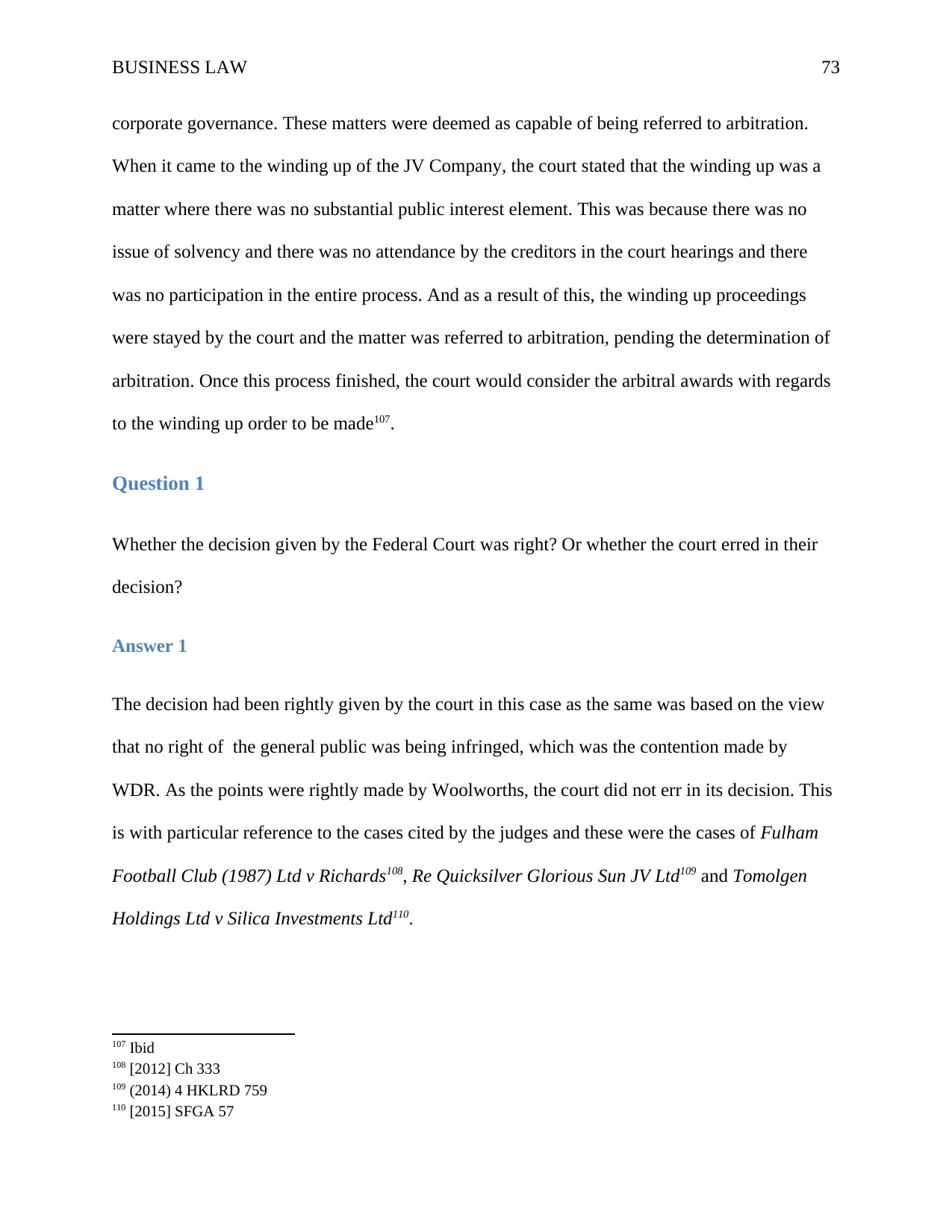
BUSINESS LAW 73
corporate governance. These matters were deemed as capable of being referred to arbitration.
When it came to the winding up of the JV Company, the court stated that the winding up was a
matter where there was no substantial public interest element. This was because there was no
issue of solvency and there was no attendance by the creditors in the court hearings and there
was no participation in the entire process. And as a result of this, the winding up proceedings
were stayed by the court and the matter was referred to arbitration, pending the determination of
arbitration. Once this process finished, the court would consider the arbitral awards with regards
to the winding up order to be made107.
Question 1
Whether the decision given by the Federal Court was right? Or whether the court erred in their
decision?
Answer 1
The decision had been rightly given by the court in this case as the same was based on the view
that no right of the general public was being infringed, which was the contention made by
WDR. As the points were rightly made by Woolworths, the court did not err in its decision. This
is with particular reference to the cases cited by the judges and these were the cases of Fulham
Football Club (1987) Ltd v Richards108, Re Quicksilver Glorious Sun JV Ltd109 and Tomolgen
Holdings Ltd v Silica Investments Ltd110.
107 Ibid
108 [2012] Ch 333
109 (2014) 4 HKLRD 759
110 [2015] SFGA 57
corporate governance. These matters were deemed as capable of being referred to arbitration.
When it came to the winding up of the JV Company, the court stated that the winding up was a
matter where there was no substantial public interest element. This was because there was no
issue of solvency and there was no attendance by the creditors in the court hearings and there
was no participation in the entire process. And as a result of this, the winding up proceedings
were stayed by the court and the matter was referred to arbitration, pending the determination of
arbitration. Once this process finished, the court would consider the arbitral awards with regards
to the winding up order to be made107.
Question 1
Whether the decision given by the Federal Court was right? Or whether the court erred in their
decision?
Answer 1
The decision had been rightly given by the court in this case as the same was based on the view
that no right of the general public was being infringed, which was the contention made by
WDR. As the points were rightly made by Woolworths, the court did not err in its decision. This
is with particular reference to the cases cited by the judges and these were the cases of Fulham
Football Club (1987) Ltd v Richards108, Re Quicksilver Glorious Sun JV Ltd109 and Tomolgen
Holdings Ltd v Silica Investments Ltd110.
107 Ibid
108 [2012] Ch 333
109 (2014) 4 HKLRD 759
110 [2015] SFGA 57
Paraphrase This Document
Need a fresh take? Get an instant paraphrase of this document with our AI Paraphraser
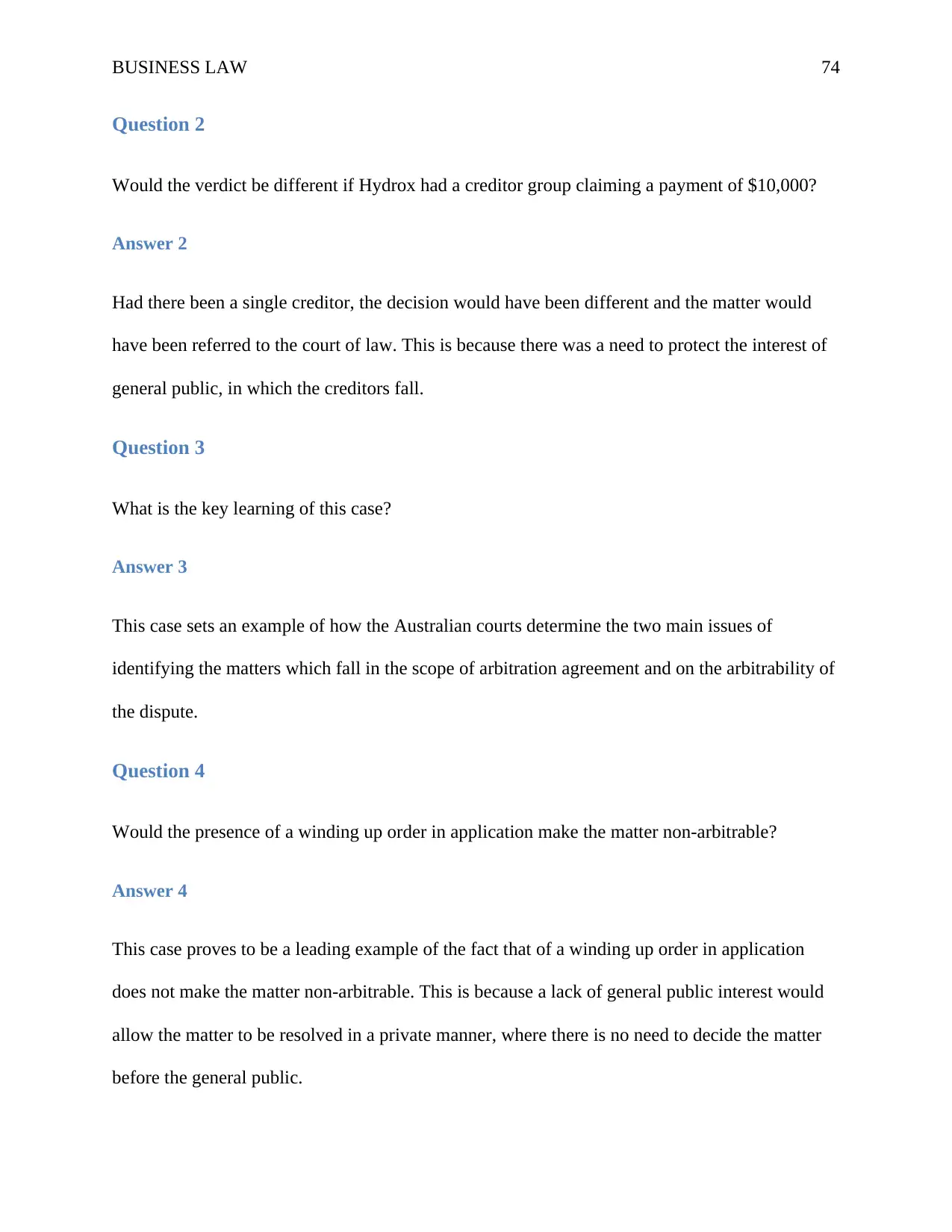
BUSINESS LAW 74
Question 2
Would the verdict be different if Hydrox had a creditor group claiming a payment of $10,000?
Answer 2
Had there been a single creditor, the decision would have been different and the matter would
have been referred to the court of law. This is because there was a need to protect the interest of
general public, in which the creditors fall.
Question 3
What is the key learning of this case?
Answer 3
This case sets an example of how the Australian courts determine the two main issues of
identifying the matters which fall in the scope of arbitration agreement and on the arbitrability of
the dispute.
Question 4
Would the presence of a winding up order in application make the matter non-arbitrable?
Answer 4
This case proves to be a leading example of the fact that of a winding up order in application
does not make the matter non-arbitrable. This is because a lack of general public interest would
allow the matter to be resolved in a private manner, where there is no need to decide the matter
before the general public.
Question 2
Would the verdict be different if Hydrox had a creditor group claiming a payment of $10,000?
Answer 2
Had there been a single creditor, the decision would have been different and the matter would
have been referred to the court of law. This is because there was a need to protect the interest of
general public, in which the creditors fall.
Question 3
What is the key learning of this case?
Answer 3
This case sets an example of how the Australian courts determine the two main issues of
identifying the matters which fall in the scope of arbitration agreement and on the arbitrability of
the dispute.
Question 4
Would the presence of a winding up order in application make the matter non-arbitrable?
Answer 4
This case proves to be a leading example of the fact that of a winding up order in application
does not make the matter non-arbitrable. This is because a lack of general public interest would
allow the matter to be resolved in a private manner, where there is no need to decide the matter
before the general public.

BUSINESS LAW 75
Question 5
Did the Federal Court have the jurisdiction to decide upon this matter?
Answer 5
The Federal Court had the jurisdiction over this case as the company which was formed through
the joint venture, i.e., Hydrox, was an Australian company, on which the Federal Court has the
relevant jurisdiction.
Question 5
Did the Federal Court have the jurisdiction to decide upon this matter?
Answer 5
The Federal Court had the jurisdiction over this case as the company which was formed through
the joint venture, i.e., Hydrox, was an Australian company, on which the Federal Court has the
relevant jurisdiction.
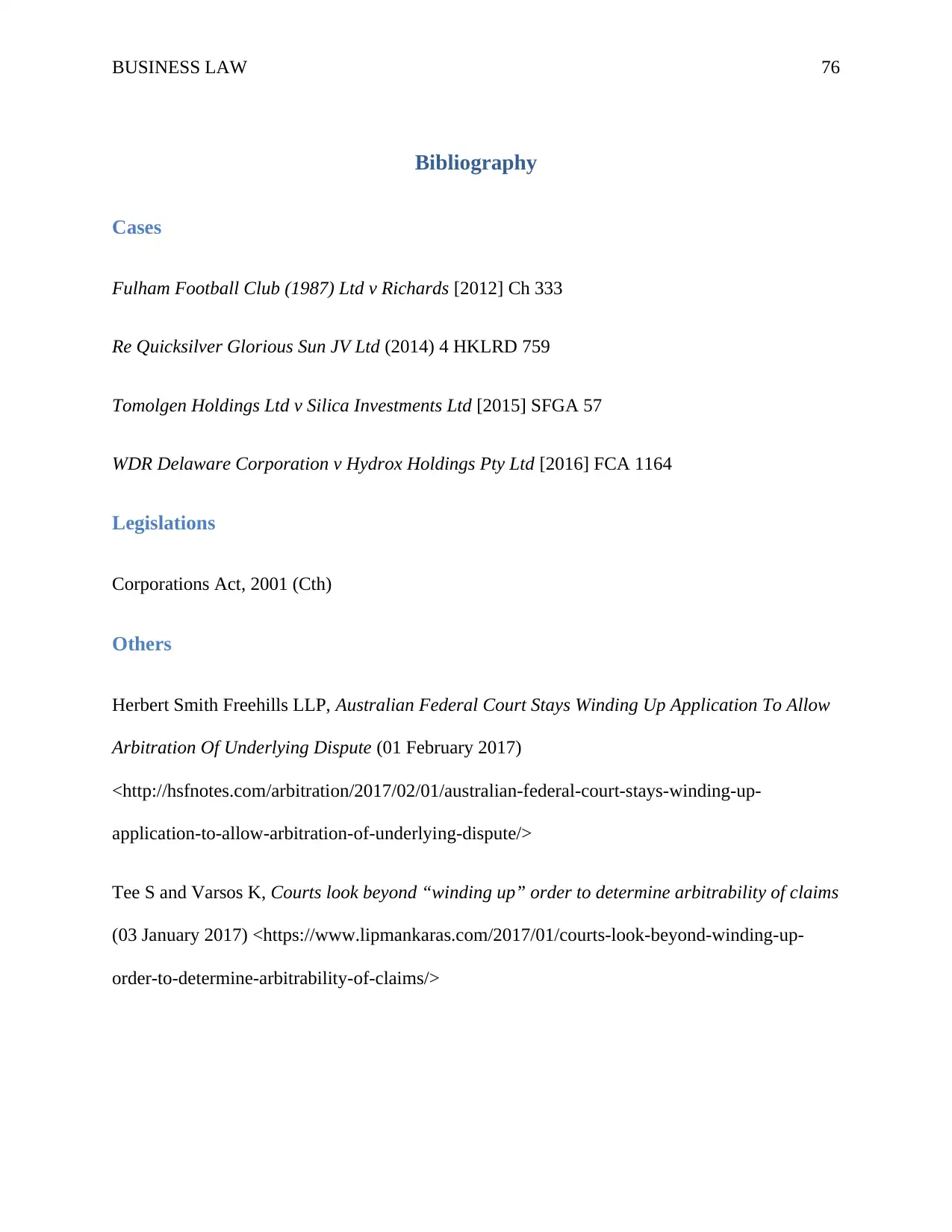
BUSINESS LAW 76
Bibliography
Cases
Fulham Football Club (1987) Ltd v Richards [2012] Ch 333
Re Quicksilver Glorious Sun JV Ltd (2014) 4 HKLRD 759
Tomolgen Holdings Ltd v Silica Investments Ltd [2015] SFGA 57
WDR Delaware Corporation v Hydrox Holdings Pty Ltd [2016] FCA 1164
Legislations
Corporations Act, 2001 (Cth)
Others
Herbert Smith Freehills LLP, Australian Federal Court Stays Winding Up Application To Allow
Arbitration Of Underlying Dispute (01 February 2017)
<http://hsfnotes.com/arbitration/2017/02/01/australian-federal-court-stays-winding-up-
application-to-allow-arbitration-of-underlying-dispute/>
Tee S and Varsos K, Courts look beyond “winding up” order to determine arbitrability of claims
(03 January 2017) <https://www.lipmankaras.com/2017/01/courts-look-beyond-winding-up-
order-to-determine-arbitrability-of-claims/>
Bibliography
Cases
Fulham Football Club (1987) Ltd v Richards [2012] Ch 333
Re Quicksilver Glorious Sun JV Ltd (2014) 4 HKLRD 759
Tomolgen Holdings Ltd v Silica Investments Ltd [2015] SFGA 57
WDR Delaware Corporation v Hydrox Holdings Pty Ltd [2016] FCA 1164
Legislations
Corporations Act, 2001 (Cth)
Others
Herbert Smith Freehills LLP, Australian Federal Court Stays Winding Up Application To Allow
Arbitration Of Underlying Dispute (01 February 2017)
<http://hsfnotes.com/arbitration/2017/02/01/australian-federal-court-stays-winding-up-
application-to-allow-arbitration-of-underlying-dispute/>
Tee S and Varsos K, Courts look beyond “winding up” order to determine arbitrability of claims
(03 January 2017) <https://www.lipmankaras.com/2017/01/courts-look-beyond-winding-up-
order-to-determine-arbitrability-of-claims/>
Secure Best Marks with AI Grader
Need help grading? Try our AI Grader for instant feedback on your assignments.
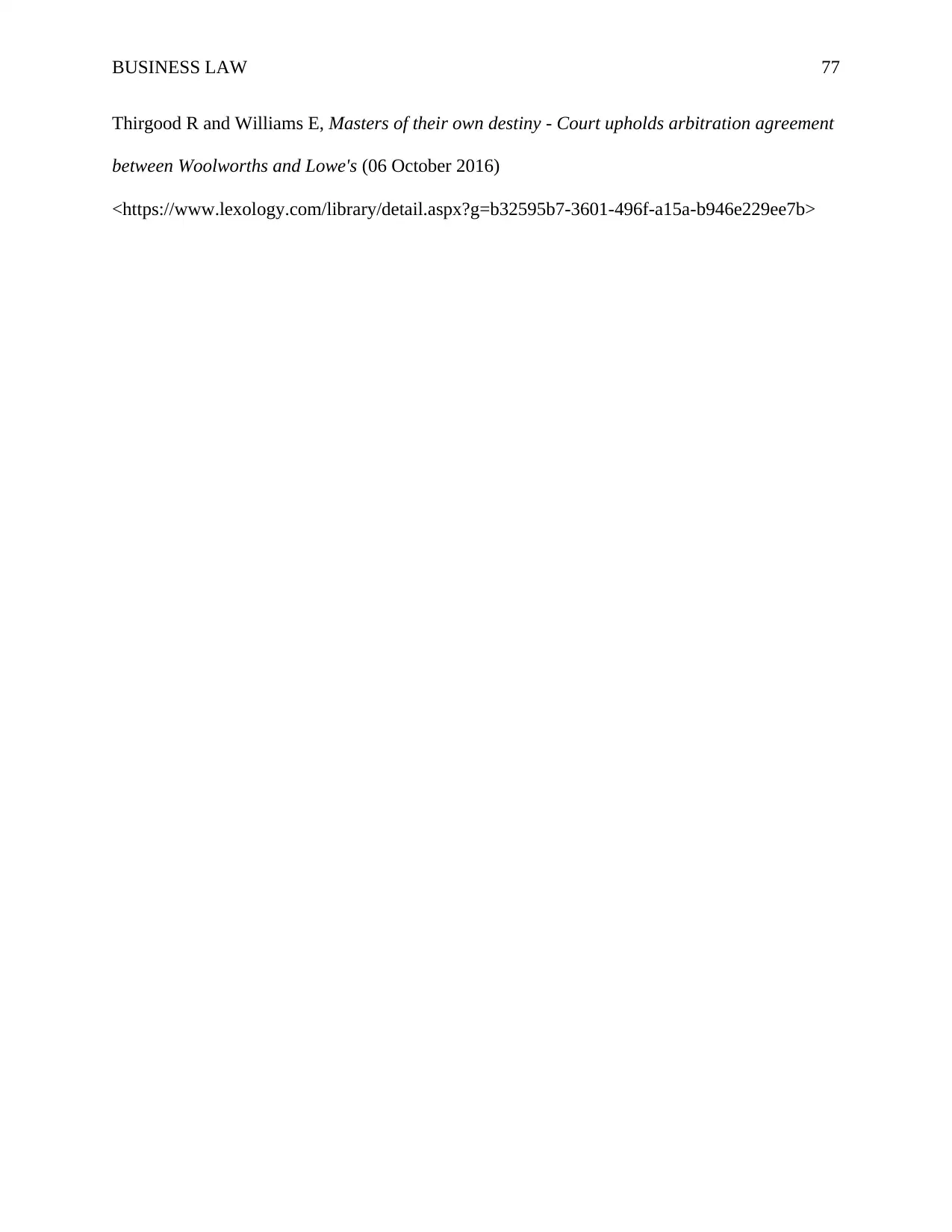
BUSINESS LAW 77
Thirgood R and Williams E, Masters of their own destiny - Court upholds arbitration agreement
between Woolworths and Lowe's (06 October 2016)
<https://www.lexology.com/library/detail.aspx?g=b32595b7-3601-496f-a15a-b946e229ee7b>
Thirgood R and Williams E, Masters of their own destiny - Court upholds arbitration agreement
between Woolworths and Lowe's (06 October 2016)
<https://www.lexology.com/library/detail.aspx?g=b32595b7-3601-496f-a15a-b946e229ee7b>
1 out of 77
Related Documents
Your All-in-One AI-Powered Toolkit for Academic Success.
+13062052269
info@desklib.com
Available 24*7 on WhatsApp / Email
![[object Object]](/_next/static/media/star-bottom.7253800d.svg)
Unlock your academic potential
© 2024 | Zucol Services PVT LTD | All rights reserved.




